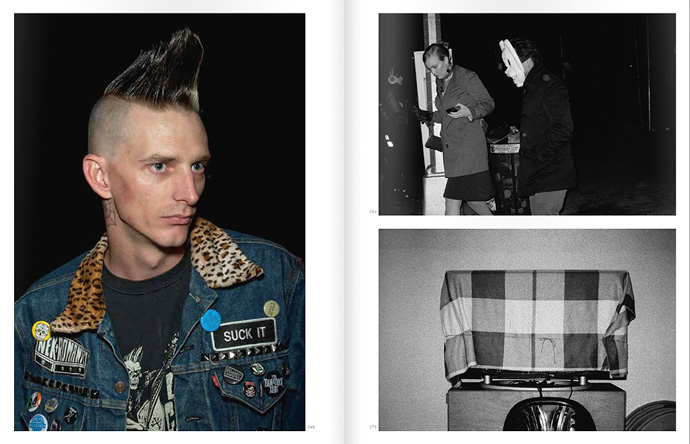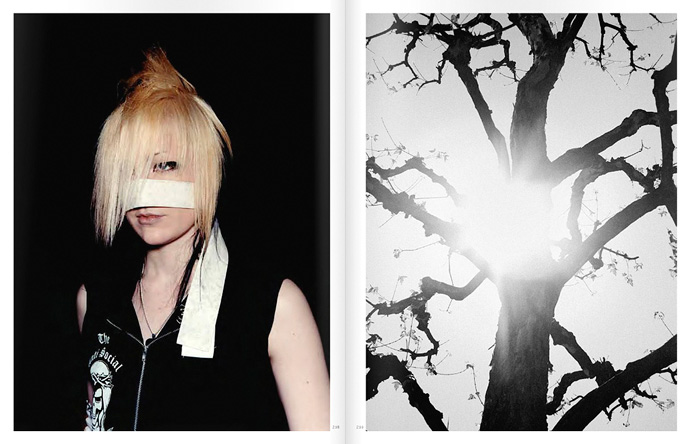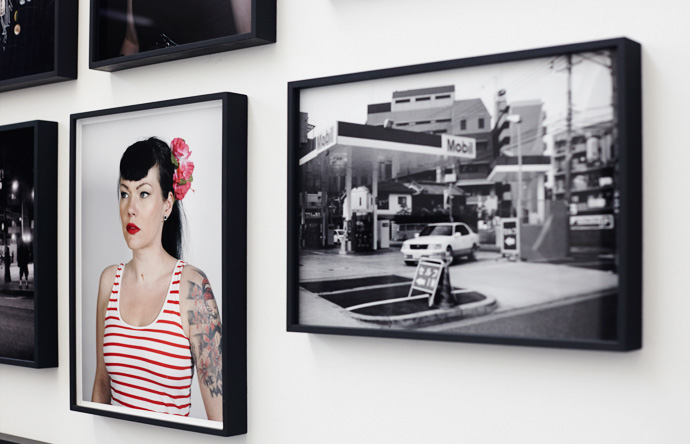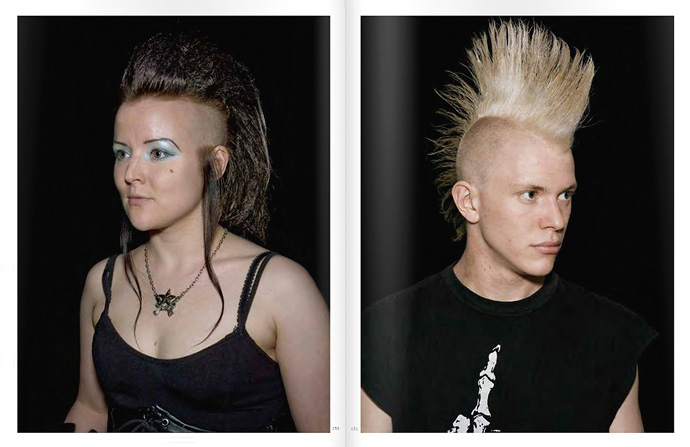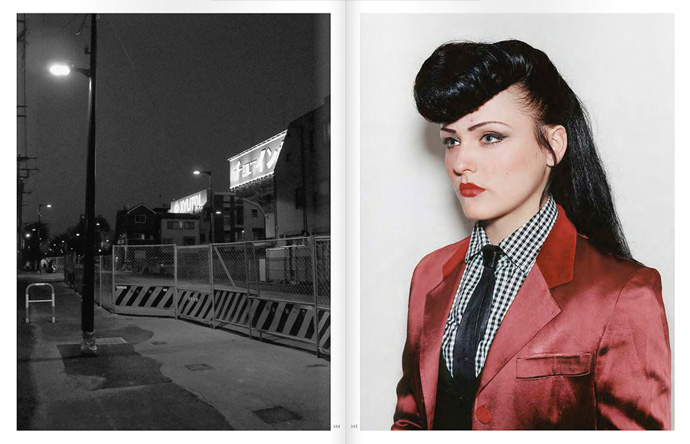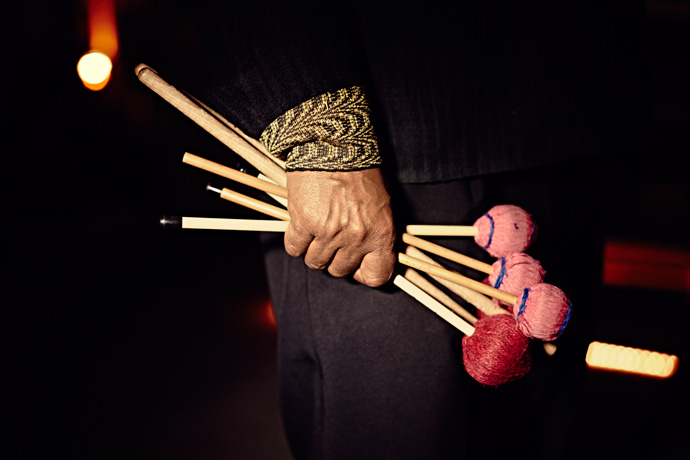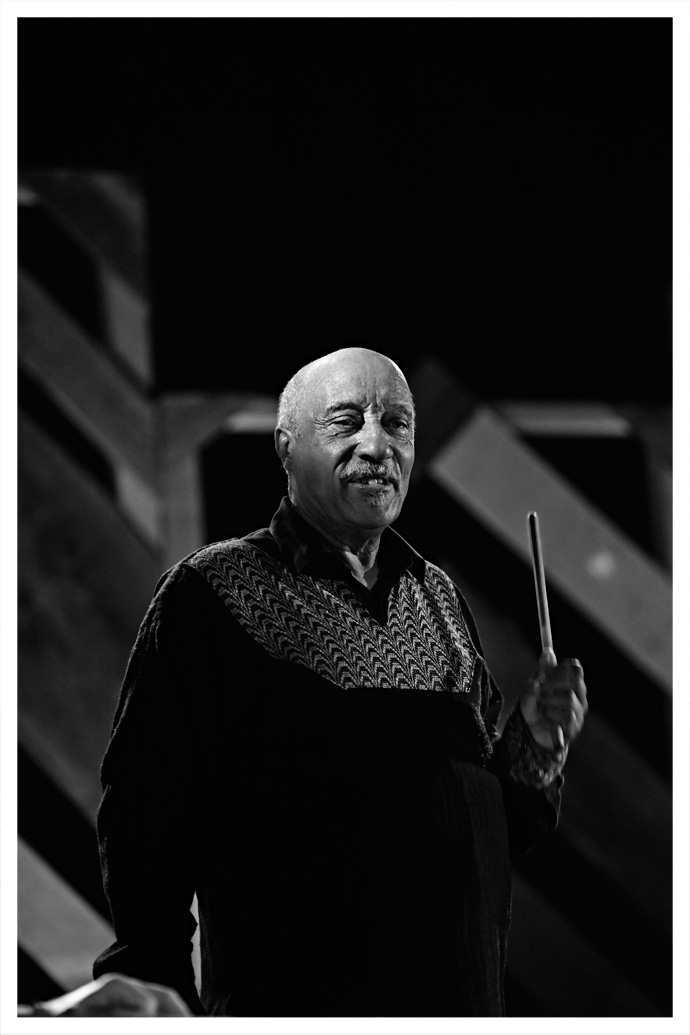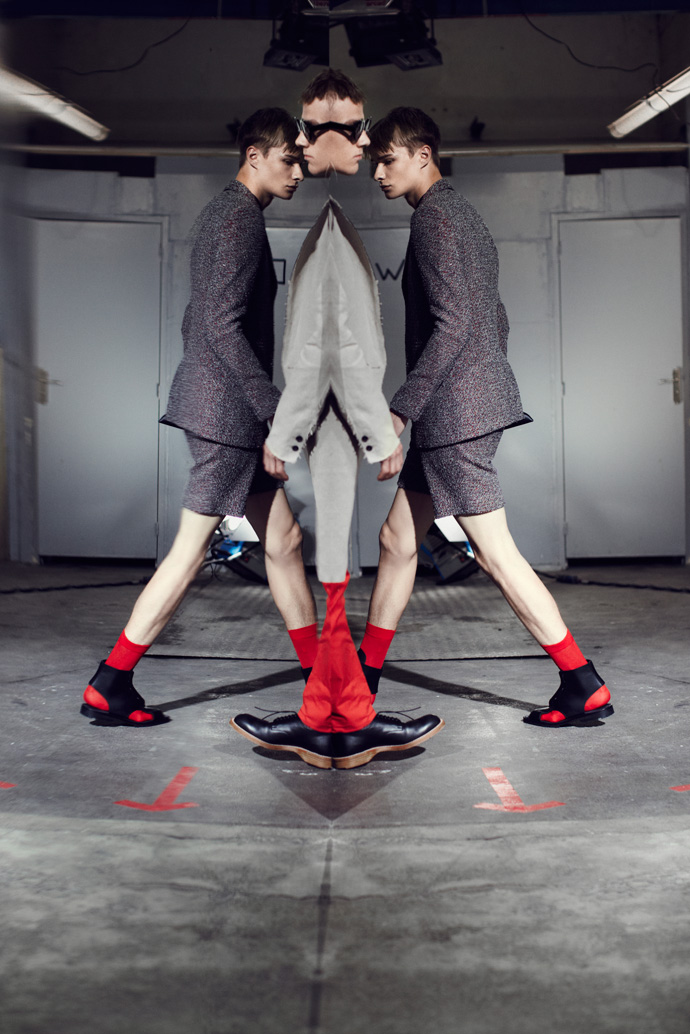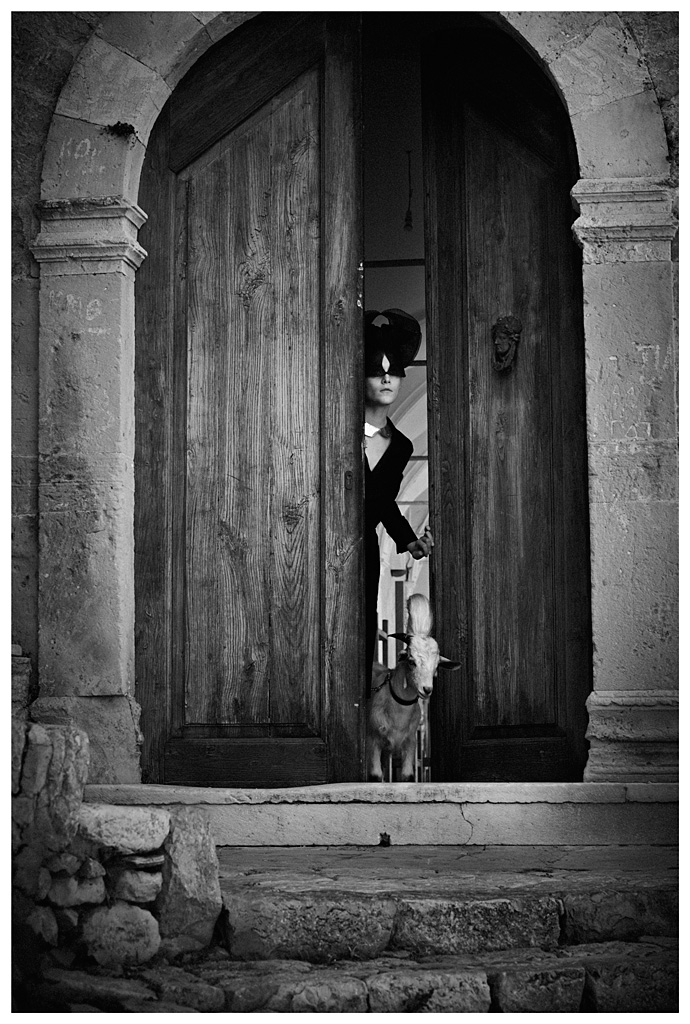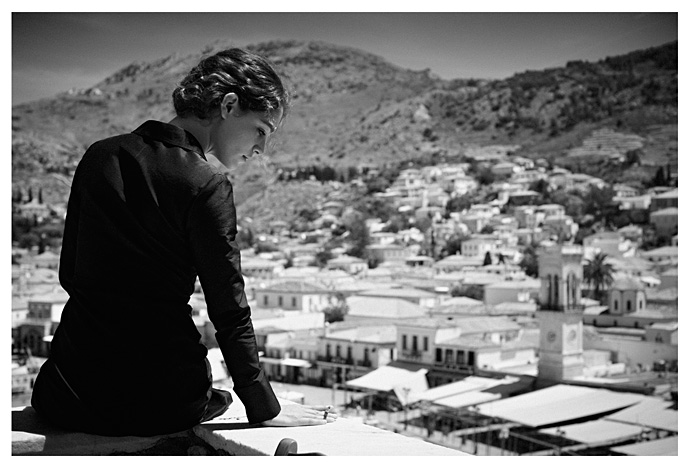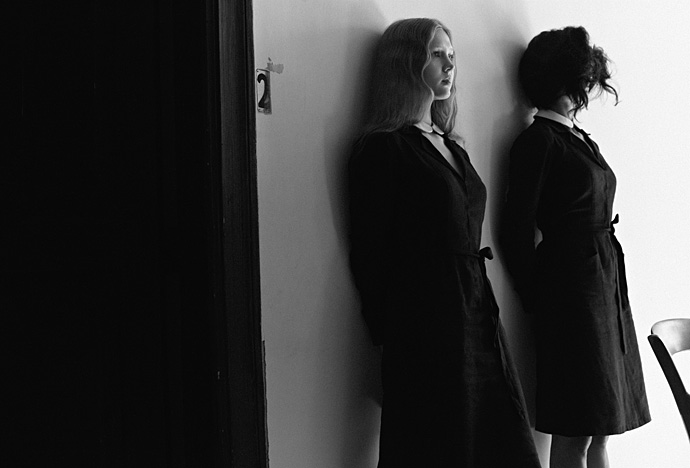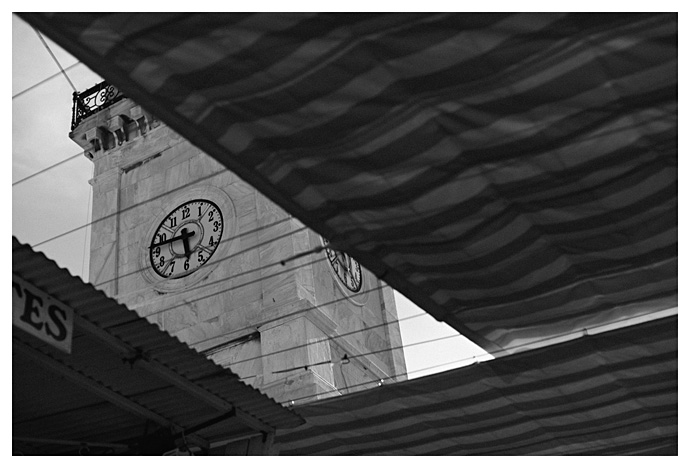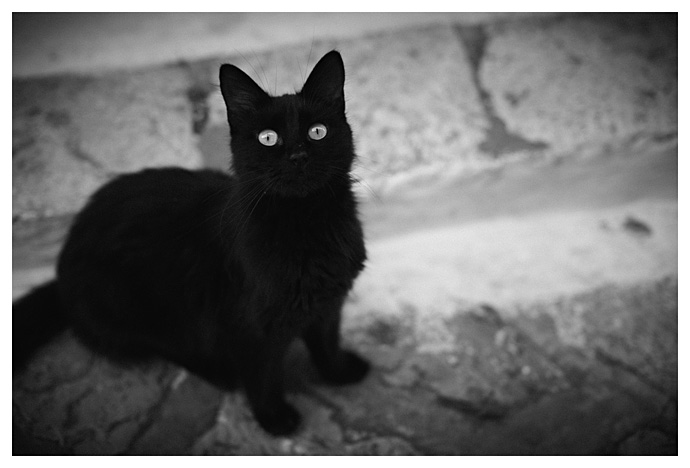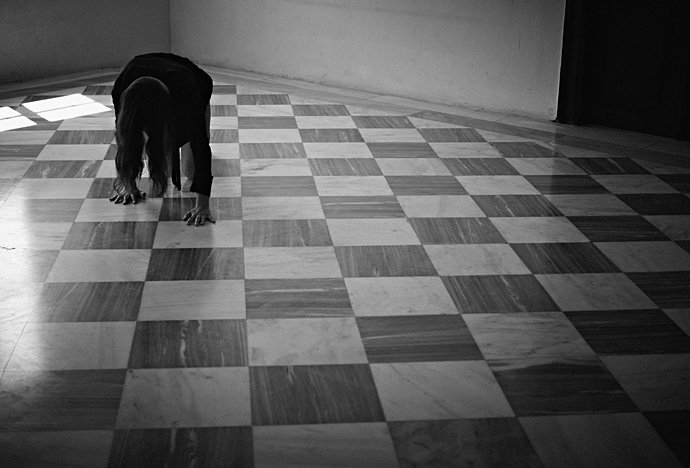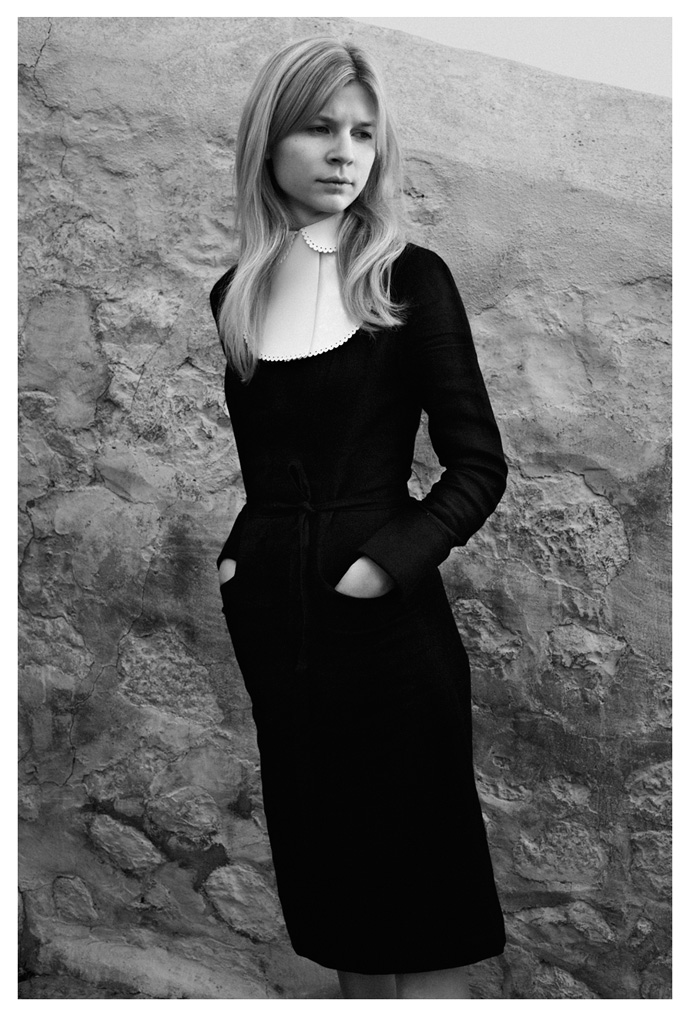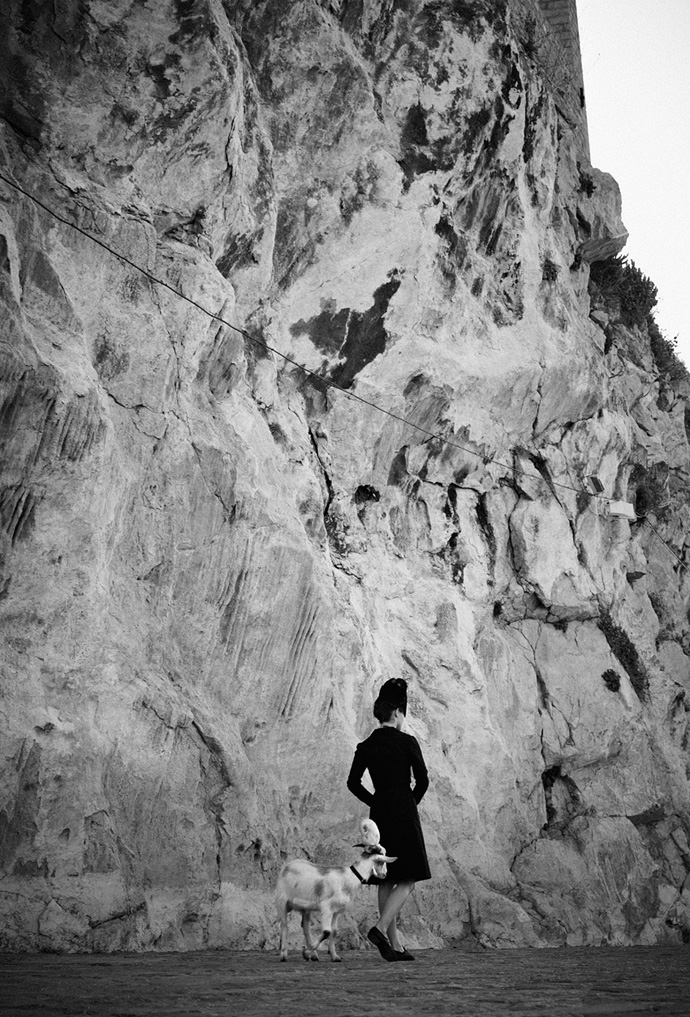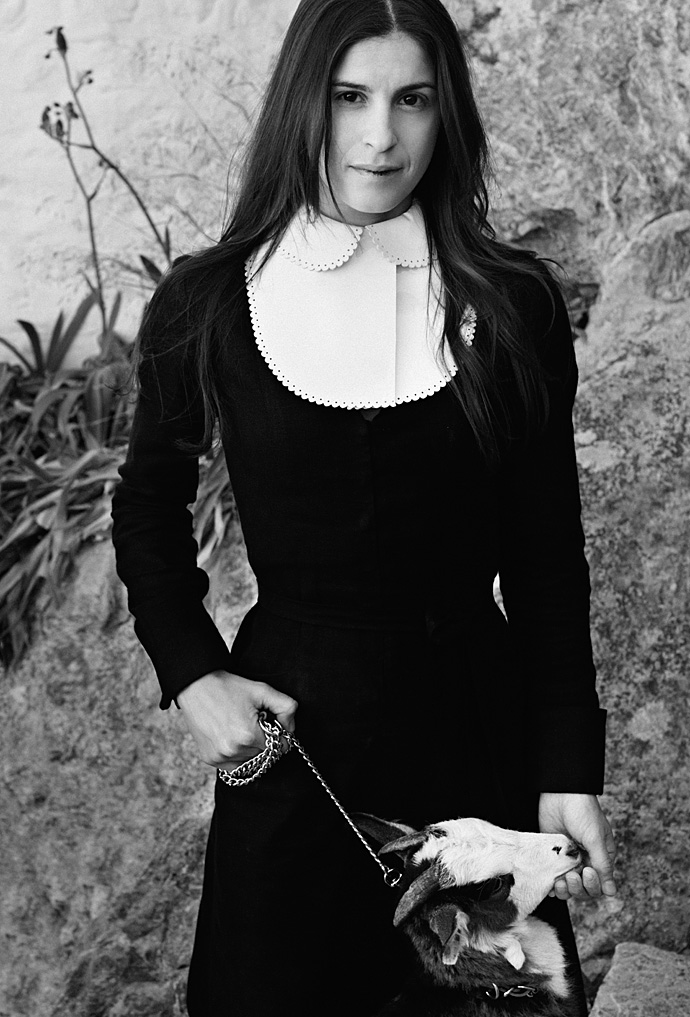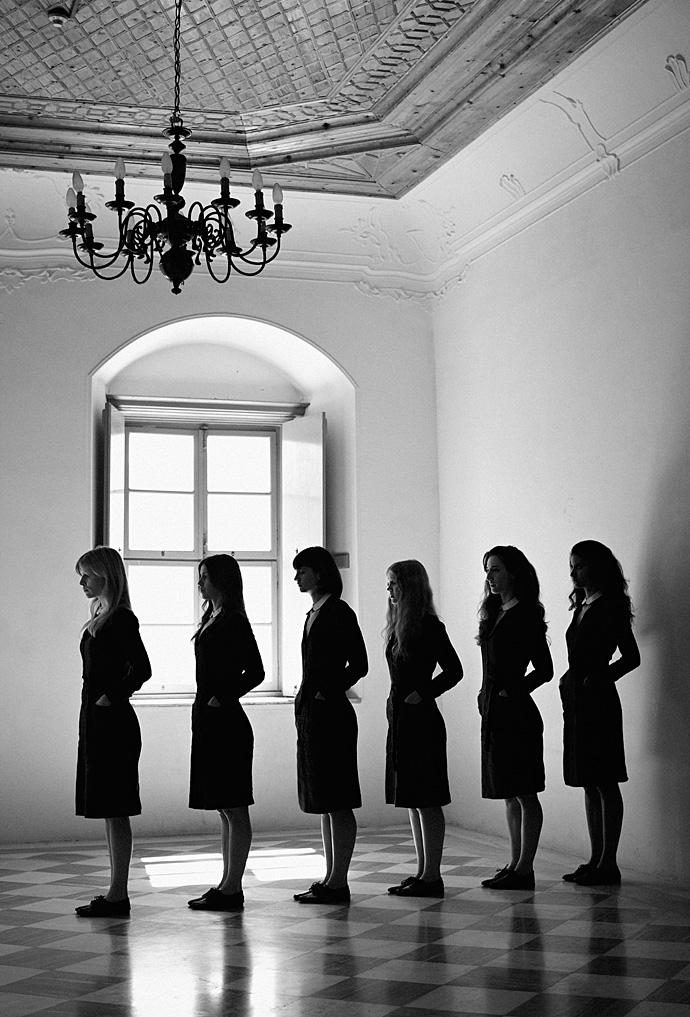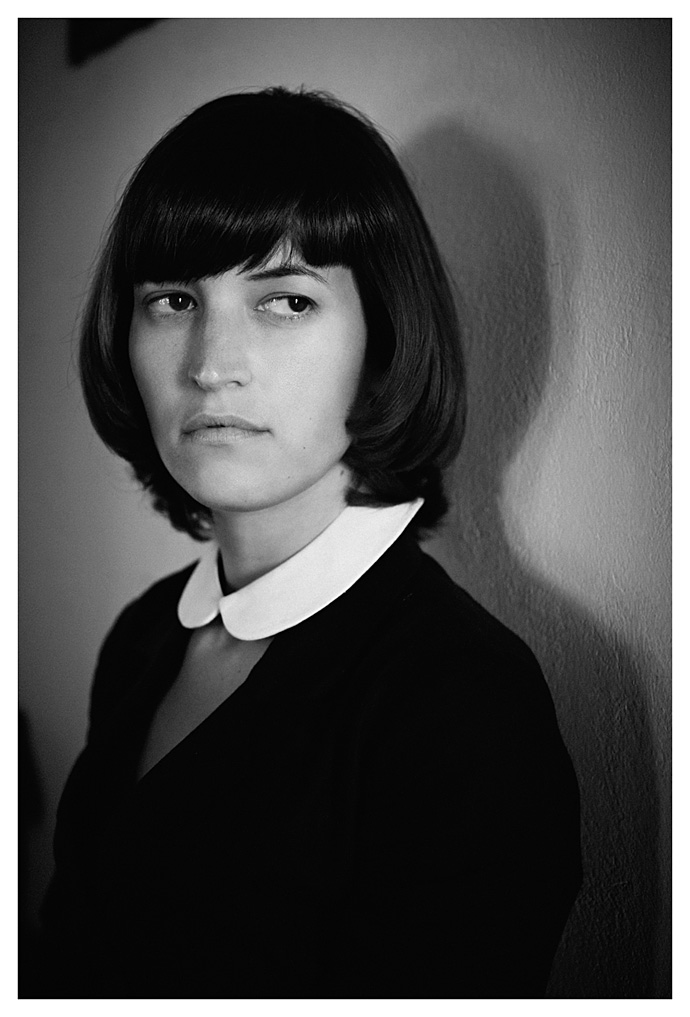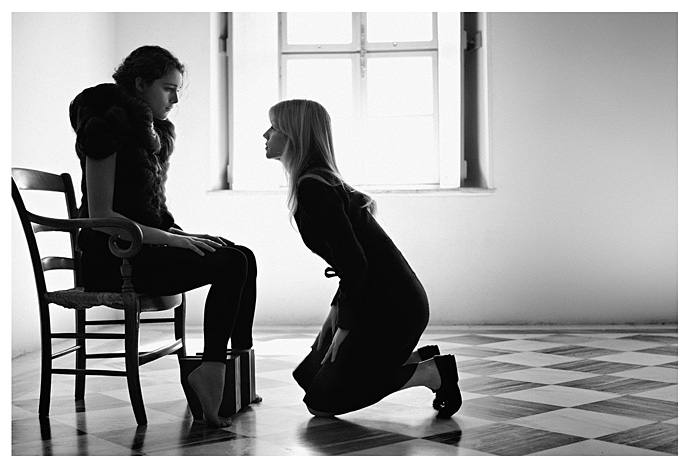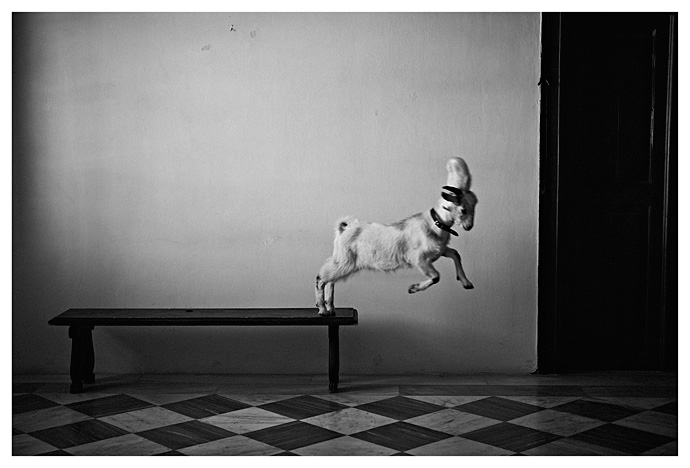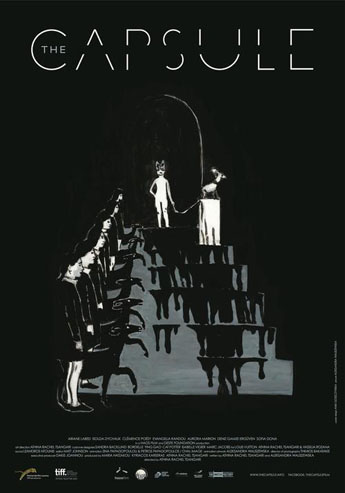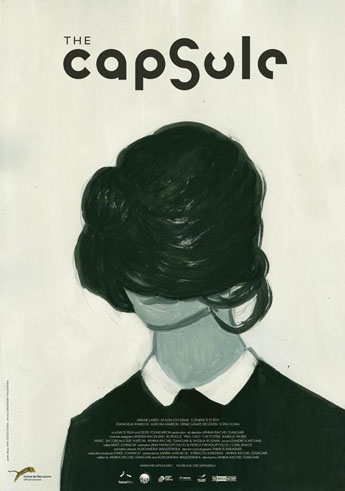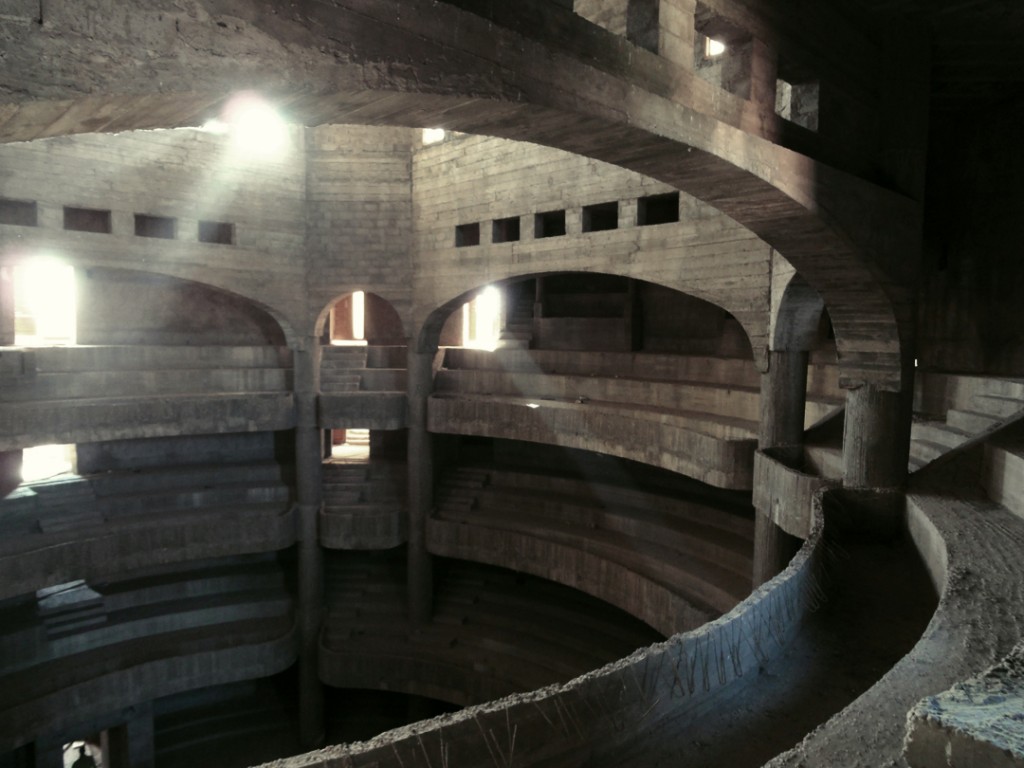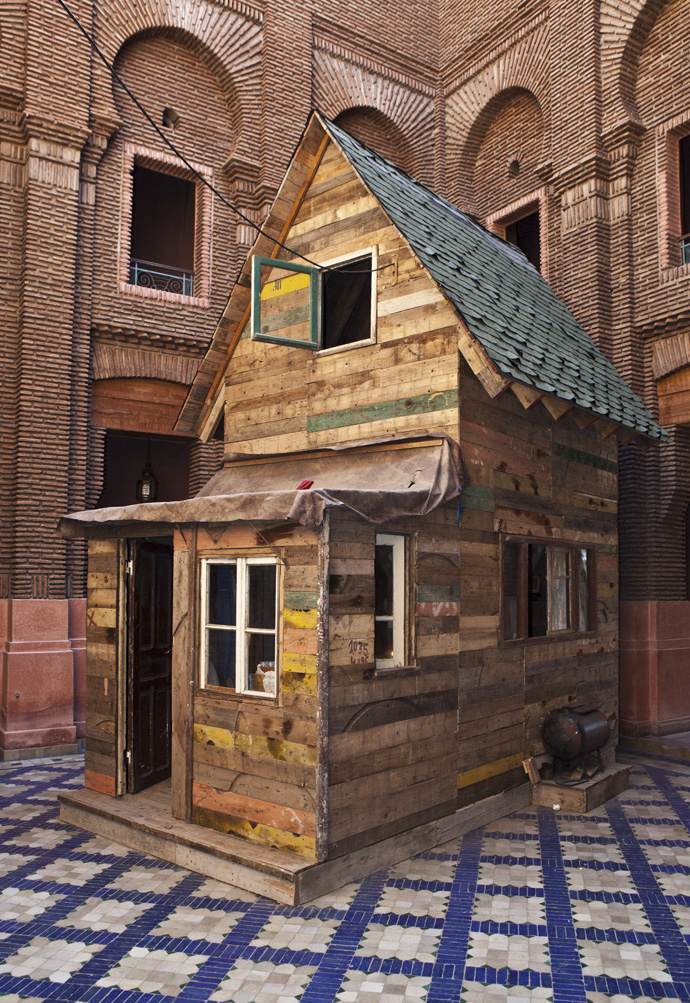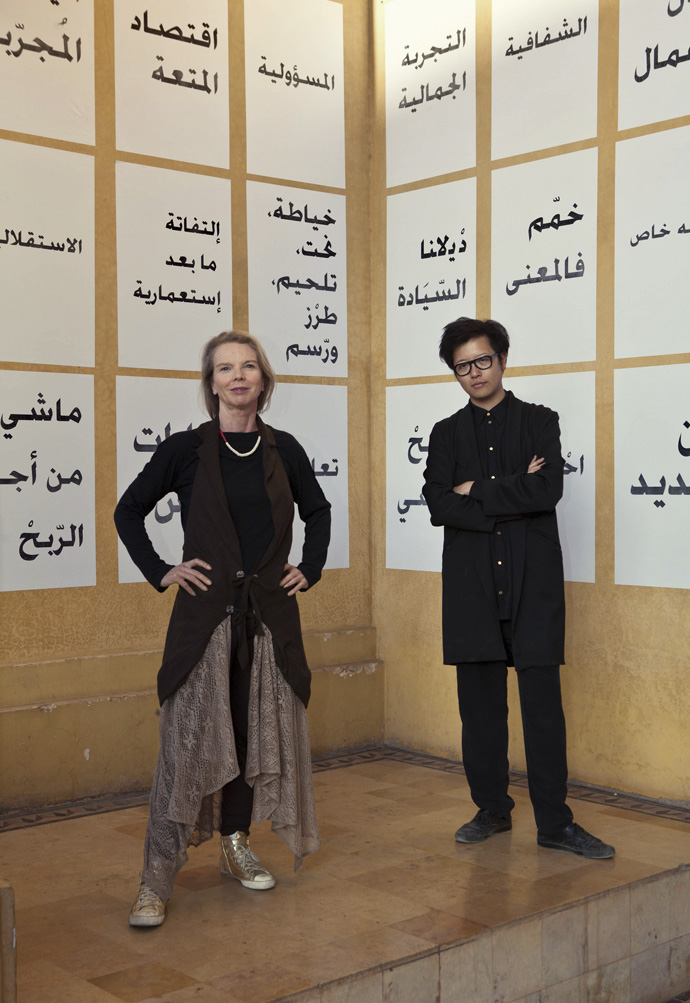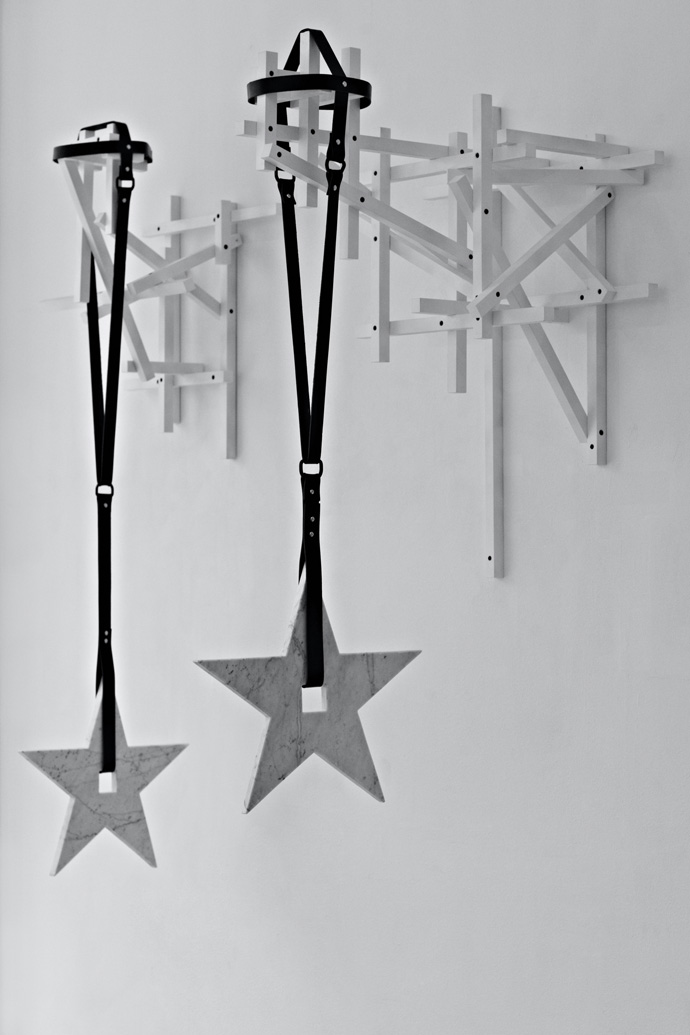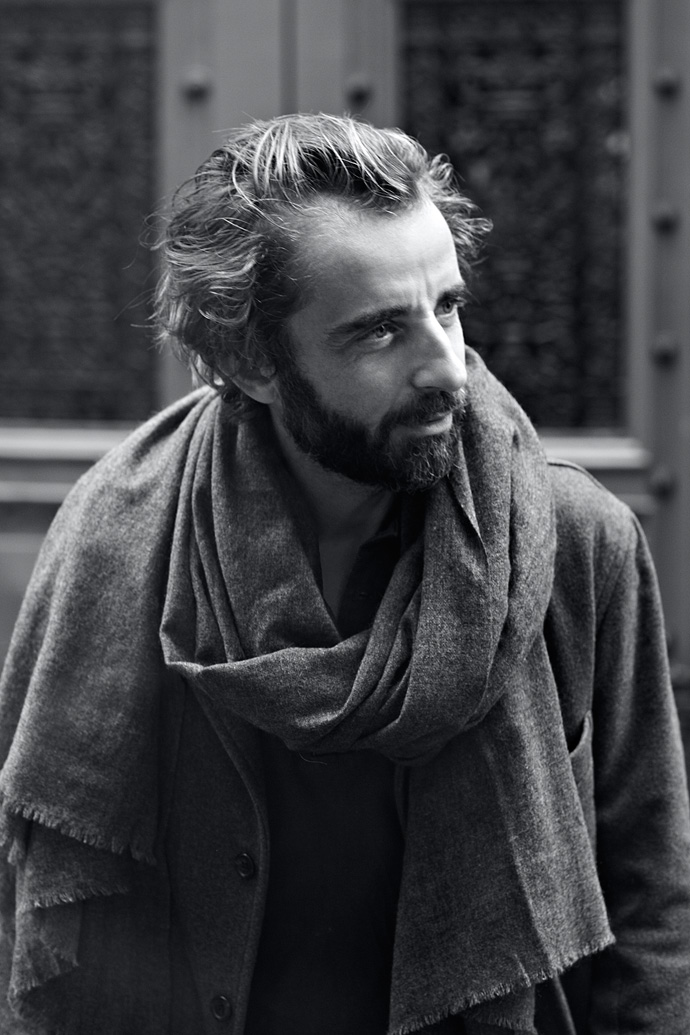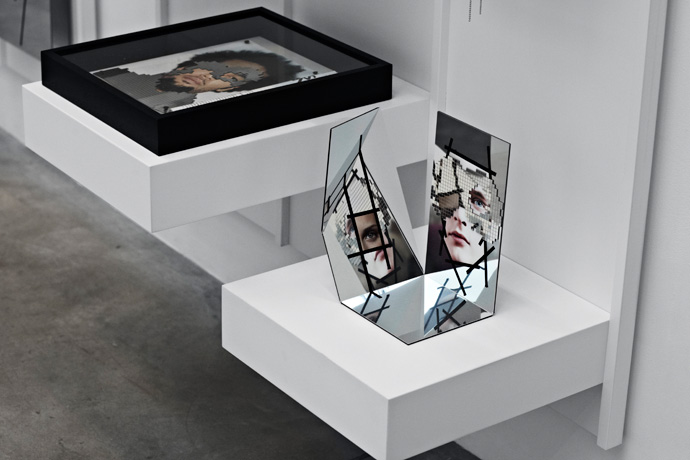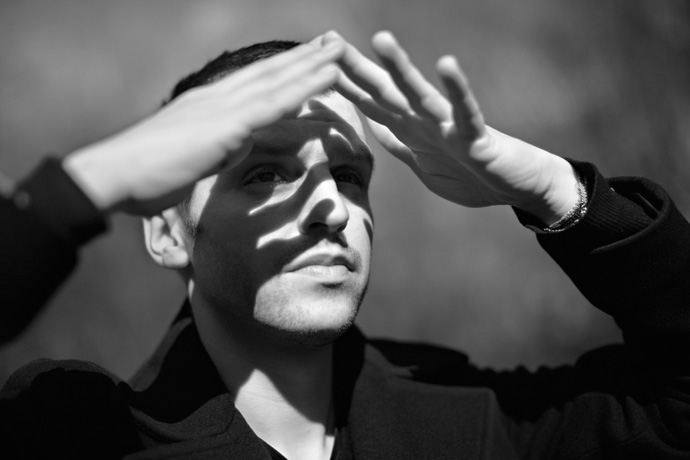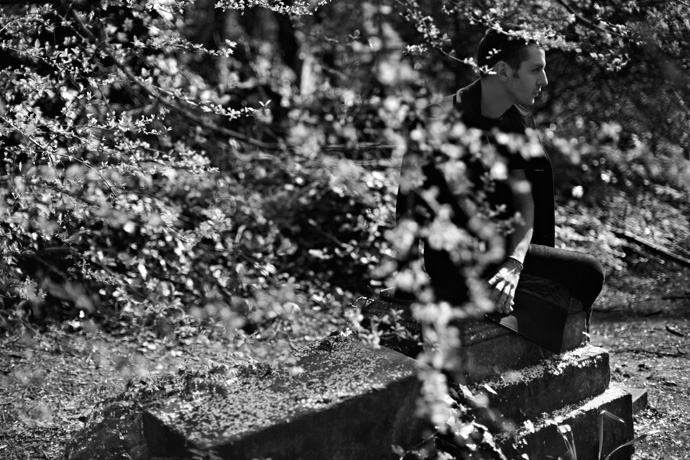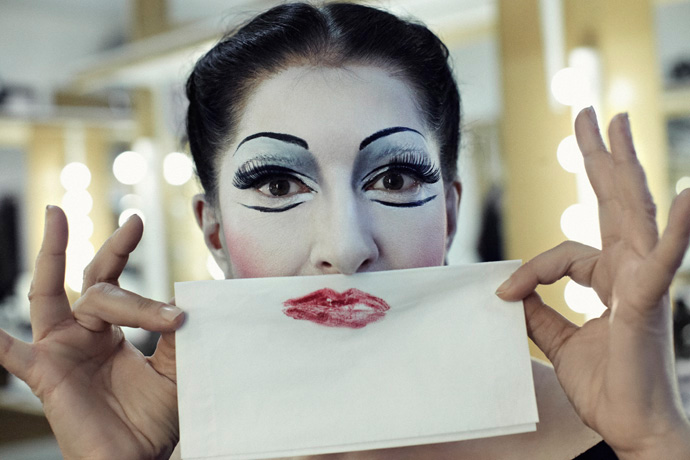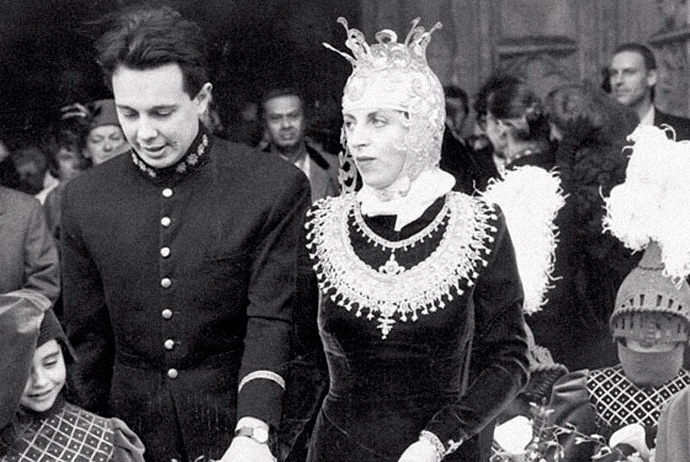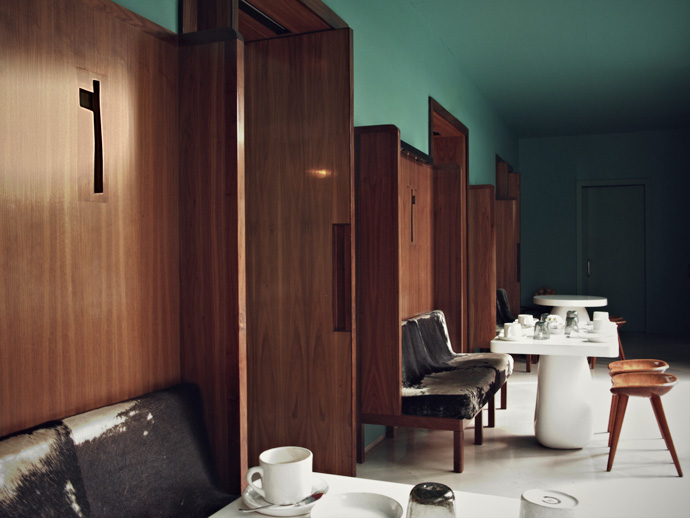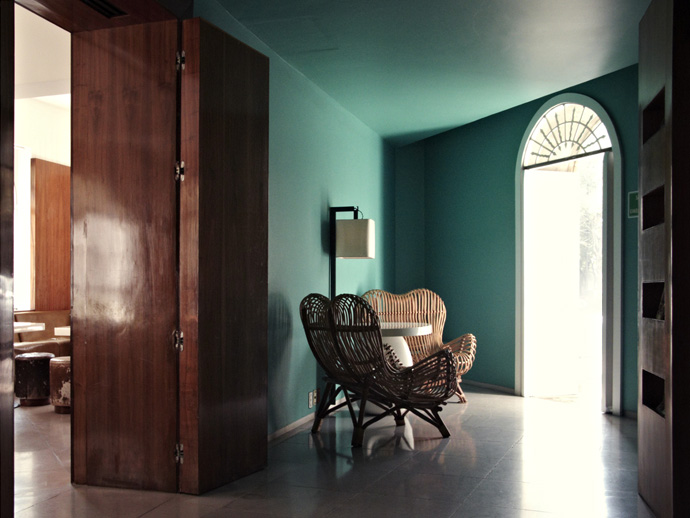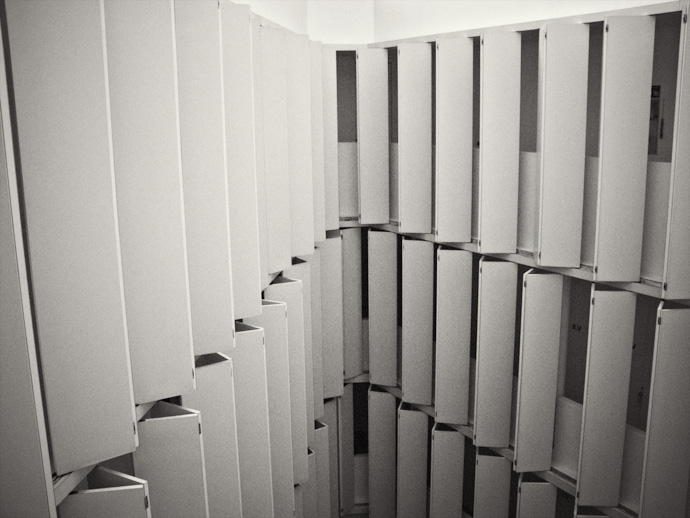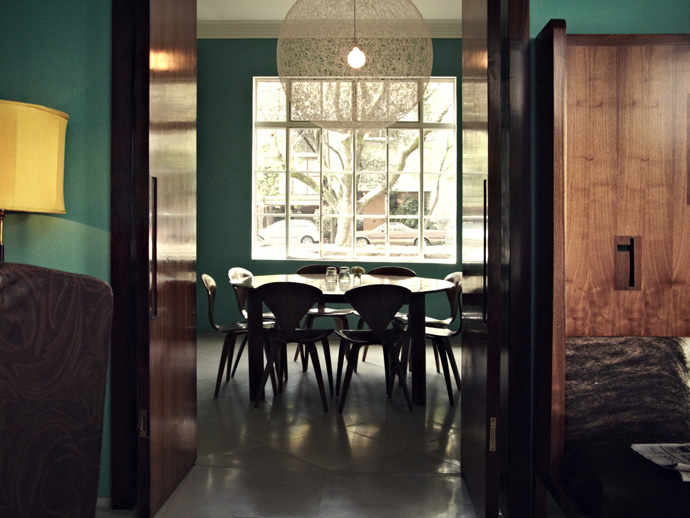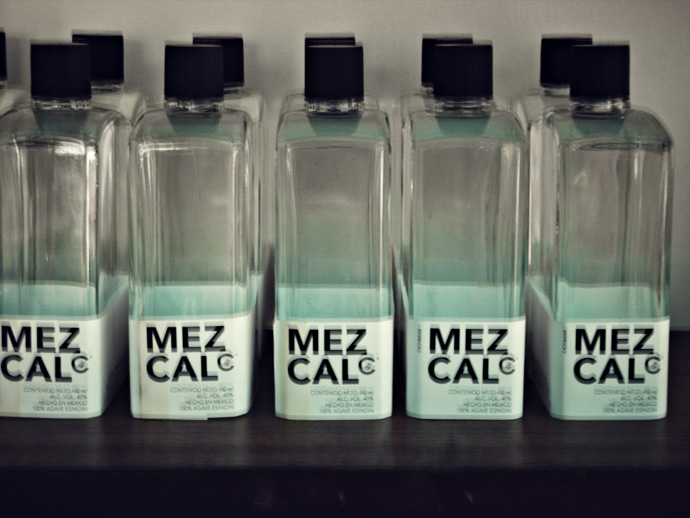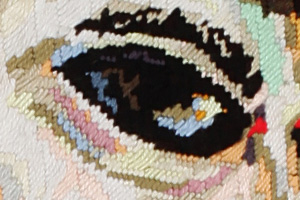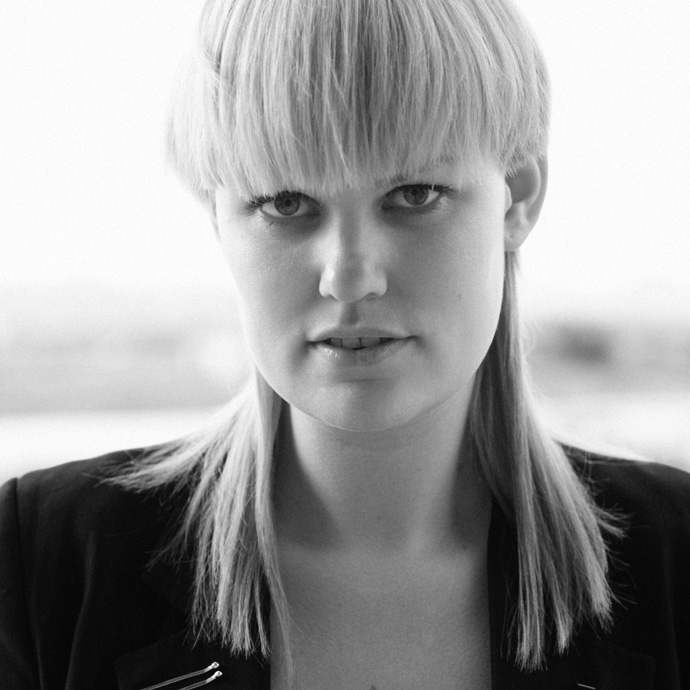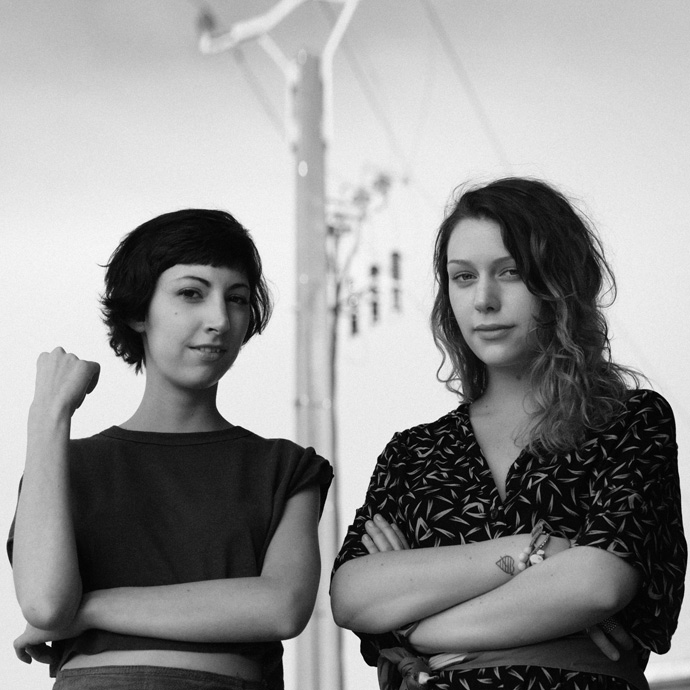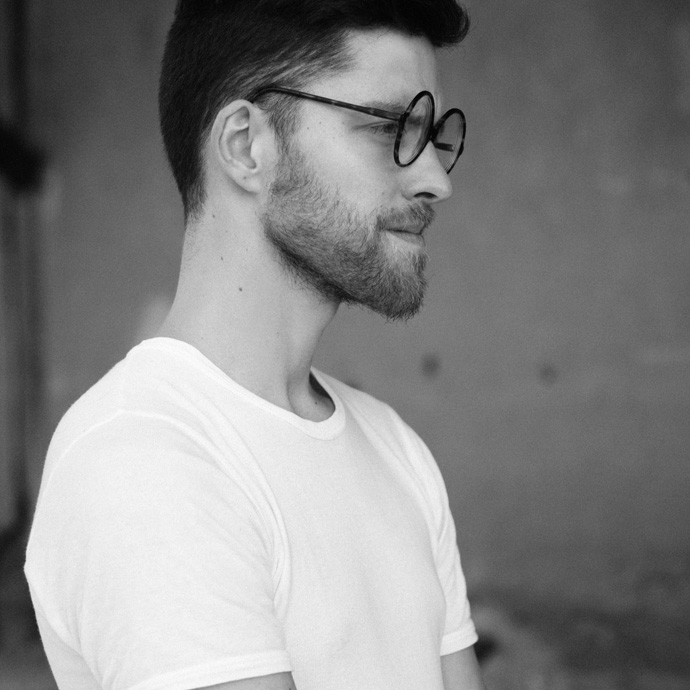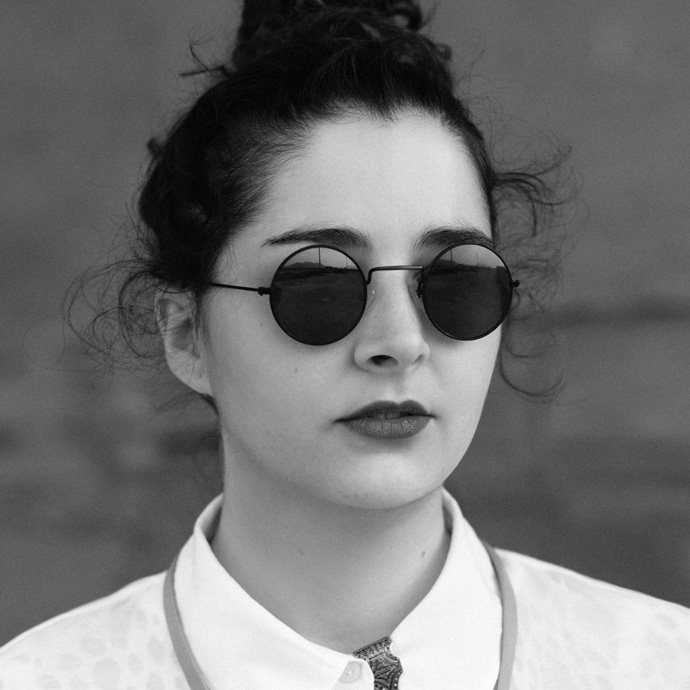-

OLIVER SIEBER – “THE NEW FUCK YOU”
-America, Asia, Europe… each continent spawns its own counter-cultures, centered for the most around music scenes. From these subcultures, Oliver Sieber creates an “Imaginary Club” composed of goths, punks, skins and rockabillies – irrespective of their cultural demarcations.
About 100 photos define the perimeters of Oliver Sieber’s “Imaginary Club, portraits taken in a makeshift studio of concerts, festivals and in clubs, and juxtaposed with black and white shots of deserted rehearsal spaces, street shots and club entrances.
Oliver Sieber’s “Imaginary Club” is exhibited at the Villa Noailles in Hyères as part of the 29th International Fashion & Photography Festival, a variation on his most recent book of same title. While setting up this exhibition, Oliver and his collaborator Katja Stuke spoke to The Stimuleye about the need of upheaval, total erosion of style and dress codes in youth culture and the need to find new forms of expressing positions of identity.
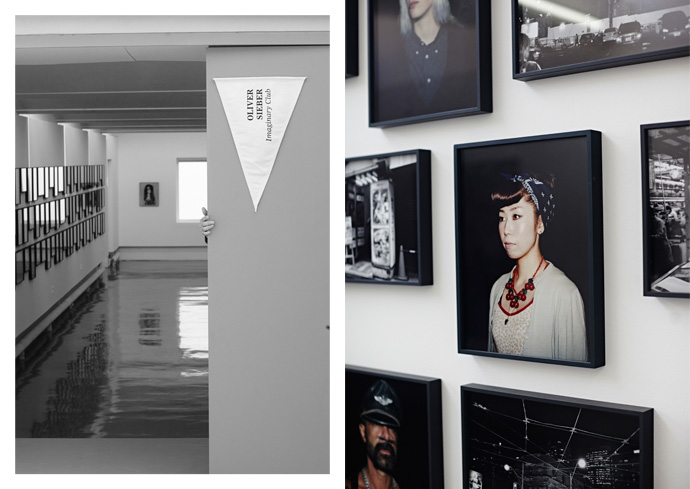
Oliver Sieber, "Imaginary Club": Exhibition at Villa Noailles, Hyeres
THE IMAGINARY CLUB
The Stimuleye: Who are these people in your “Imaginary Club”?
Oliver: What really interests me is reaction and forms of counter culture.
After WWII, the teenagers in America and England started to discover new forms of music and fashion, new forms of liberation. Many people I met are still in this sort of idea. Punk is a very good example, because it did have real societal meaning.That is what is important to teenager culture: upheaval, the struggle to identification, to root themselves. To not only take position against the elder generation, but in general. And that has often to do with music. I am interested in music, and communication of style codes.
The people in my “Imaginary Club” are not always part of a subculture in the classic sense. I have also portrayed artist friends, that, similar to teenagers, are forced to redefine themselves again and again. Here for example is a photo of Rebecca. From a wealthy family, she received always best grades, suddenly something switched in her head. Rebelling against her intellectual parents, she was climbing down the eaves gutters and was not to tame anymore.
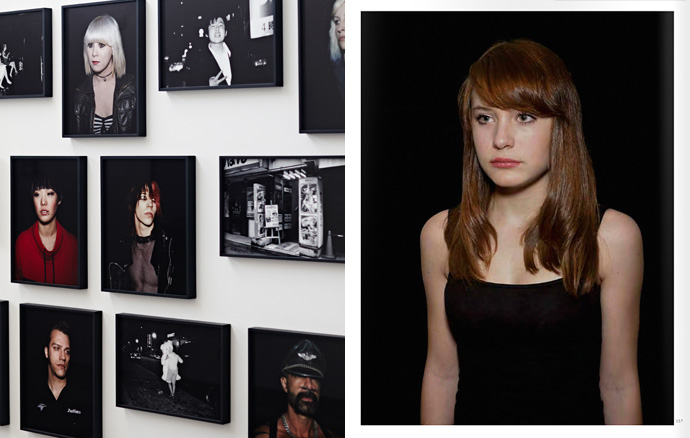
Oliver Sieber, "Imaginary Club": Exhibition at Villa Noailles, Hyeres. Right Side: Rebecca
When I look at my work, I understand it as an entry for the viewer, or a window upon which I reflect myself. Often it is not really about what is on the wall or who is depicted, but about the dialogue between the image and the onlooker. That changes from person to person.
The Stimuleye: Looking at the Portraits there are many Punks, Skinheads, Rockabillies.- is there also something a bit like nostalgia?
Oliver: We have a very globalized music culture today. Subcultures developing real novelties is something rather sparse and rare. Are there really subcultures that result from youth movements? I think it is not like that anymore. It’s more that youngsters try to identify with their role models of choice.
A good example is David Bowie that in the 70’s offered an image of “multi sexual liberation” for many people, also in combination with music and the song texts that bore a poetry and language that people picked up on. Just because we have 2014 now, his music did not disappear. You can still buy the records and the language still speaks to people who want to identify with it. And as fans do, they associate themselves with this. I think people living this don’t reflect on what they do, as we look at it. They just do it.
Katja:
There are always new aspects adding up and things get mixed up. So you have a development that can’t be called the “nostalgic”. It may be rooted in a source, and like in this case ideally there is a progression where new aspects ad up.Oliver Sieber, excepts from the book "Imaginary Club"
FASHION CODES AND THE INTERNET : THE NEW “FUCK YOU”
Katja:
Today you often cannot rely on the looks giving an indication on who people are: In Germany you find nazis that look like left anarchist “Antifa” fighters.
That possibly has to do with the internet, where you can communicate your stance or orientation in different ways then through fashion and dress codes.
You also have to react on other people adapting what you personally take serious as a subculture, how they mix your codes, abuse or pervert them.This makes it sometimes also difficult to determine whom are you following in a protest, where codes are so mixed up, that no one is able to keep up track.
For example in Ukraine its absolutely ambiguous who is protesting with whom recently. Unlike in the past, today it’s hard to determine who is on which side, from demonstrator to counter protester. Now you have young Nazi Hipsters in all black with tight jeans shouldering a jute bag, which really requires more than a second look to recognize what is going on.In this position you’re forced to find other forms to show your conviction that are different and function without the need of fashion as we had it in the past.
I am sure there are subcultures, but they function really differently, without the involvement of fashion, as the channels are much more multi layered. It’s not about provoking through your look anymore, because nowadays people are not easy to shock. So you have to find other ways and places to put your orientation forwards.Oliver Sieber, excepts from the book "Imaginary Club"
Oliver: In Japan a lot of messages get transported through flyers and stickers. This was similar in Los Angeles up until recently, but it changed and is now functioning mainly through hotmail panels. Everyone has a smartphone, no matter to which group you belong. The Cosplay culture for example functions only through the forums in the web. That’s all chat, appointments for conventions and Skype.
Katja:
But the internet is not at all as public as you may expect.
Often it’s very difficult to access a certain online group or forums. There are strict admins that want to know who you are and what you do, and remind you that with access you commit to a regular contribution etc- so you can’t just get in and check out. It’s much easier to go into a bar or a club, even if you have to pass and convince the bouncer.Oliver:
For example I photographed a young punk who realized how his style had been adapted and declared a trend. He totally changed his appearance to not be associated with this widely publicized new trend. That doesn’t mean though that his anti-ascist conviction or adoration for punk changed at all.As label and the designers pick up on elements of subculture their message is watered down extremely fast, so you have to have to change your codes again. As Jason (Evans) recently said at the Tate: “The new normal is the new ‘Fuck You,'”, because you can’t be categorized like this anymore.
Oliver Sieber, "Imaginary Club": Exhibition at Villa Noailles, Hyeres
PROTEST
Oliver:
That there is a new protest culture again is really great. These positions are getting from the internet to the street again, where you suddenly have to make an effort, as the codes we’re used to don’t work anymore when you can’t diversify between “good” and “evil”, nor recognize “your” or “my” people.Katja:
At the same time there is also these movements of parallel culture to create an existence and surrounding of some sorts of withdraw, even resigning.
This may be an approach resulting from being overwhelmed by societal developments. Specially in Japan we’ve met people that engage in small initiatives, artistic ones or others that take care of the homeless. There is this movement of “do it yourself” culture where people search for new forms of living for themselves apart from mainstream, norms and social graces, which are less visible.Oliver:
When visiting Osaka soon for another exhibit, we plan to investigate deeper into this, meet with these “alternative” people that found a totally different life and structure within of Japanese society.
What I found puzzling was that we met many homeless who spoke great English or Spanish, and had lived and worked abroad, but this had lead that they were not fully integrable any more into society, because the’ve been abroad too long and back in Japan landed on the street.Katja:
I think that also has to do that people with knowledge of languages have access to much more information over the internet for example, and thus are more open to ideas to try a different draft for their life than their parents, because that didn’t work that well either.
Specially as you can’t rely on social securities anymore- it’s not like our parent generation that studied, took a job and continued with a great retirement plan.Oliver Sieber, excepts from the book "Imaginary Club"
The Stimuleye: How do you work together?
Katja:
There are varying methods, but at times there are actual connections or a common greater theme and possibilities to juxtapose our work in an exhibition or we publish a book together for example at BöhmKobayashi.The City of Duesseldorf has provided us with a space we curated for three years where we developed “ANT!FOTO” which was to show exhibitions on positions of photography we feel were missing. As a result we also started a publication the “ANT!FOTO Manifest” which was a common project of us.
Oliver:
The “ANT!FOTO Manifest” was a project where we asked 70 photographer and curators to word their statement after a 10 point thesis we created. Initially this was planned only as a magazine, but finally will be shown in the Museum Folkwang as well as going to the
Fotomuseum Winterthur .The Stimuleye: What is the last thing that stimulated you?
Oliver:
After we talked so much on imagery, I would like to mention something that stimulated me:
when we talked to Frenkie (Bosnian Rapper) while visiting him in Tuzla, i asked him what is “heimat” (homeland) to him.
He said after being a refugee returning from Nuernberg to Tuzla, he realized what he missed: it was the scent of the firing wood that you can smell everywhere in the city. For my senses, apart from sound or music, the smell is very important.Oliver Sieber, excepts from the book "Imaginary Club"
Imaginary Club 2005-2012 432 pages, Offset-Print, a BöhmKobayashi/GwinZegal Joint
Imaginary Club is running at the Villa Noailles in Hyeres until may 25, 2014 and after that at the Galerie Stieglitz 19 in Antwerpen. Opening May 25, 2014, further dates are at PhotoBookMuseum from August 19, 2014 and after that the Exhibition will be travelling
10 -

Merry Xmas, Mister Sakamoto.
-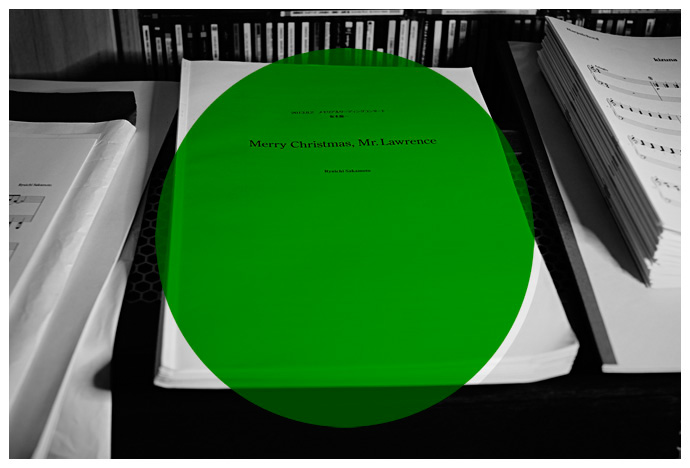 Manuscript to the score of "Furyo" by Ryuichi Sakamoto. Photography René Habermacher.
Manuscript to the score of "Furyo" by Ryuichi Sakamoto. Photography René Habermacher.It doesn’t quite add up.
There are the many facets of Ryuichi Sakamoto, but putting them together, you still wouldn’t get a sense of who the man is.
He is both an icon of Japan’s 1980’s Bubble Era, and the one who moved beyond Japan and away from the spotlight, a consistent experimentalist and accidental sex-symbol.
Founding member of the influential band Yellow Magic Orchestra, Japan’s answer to Kraftwerk.
Musical innovator for over 30 years, mixing synthpop, Okinawan traditions, sampling, bossa nova….
Screen-mate of David Bowie in the cult film “Merry Christmas, Mr. Lawrence” / “Furyo.”
Film composer for Almodovar, Oshima, Bertolucci, Oliver Stone and Brian de Palma.
Collaborating with David Byrne, Brian Wilson, Youssou N’Dour and the Dalai Lama.
Appearing in Madonna’s “Rain” music video.
Sampled by Afrika Bambaataa…and Mariah Carey.And last but not least, well before the Fukushima accident, a prominent activist in Japan’s anti-nuclear effort.
It doesn’t quite add up, and that’s really for the best, as we found out after spending an afternoon with him in New York City
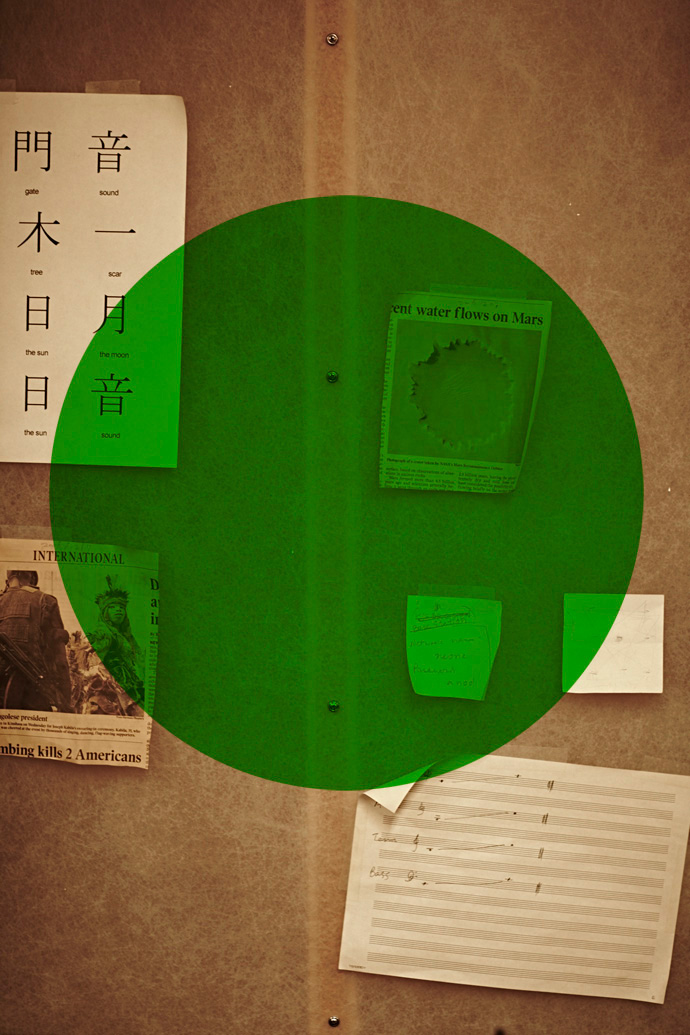
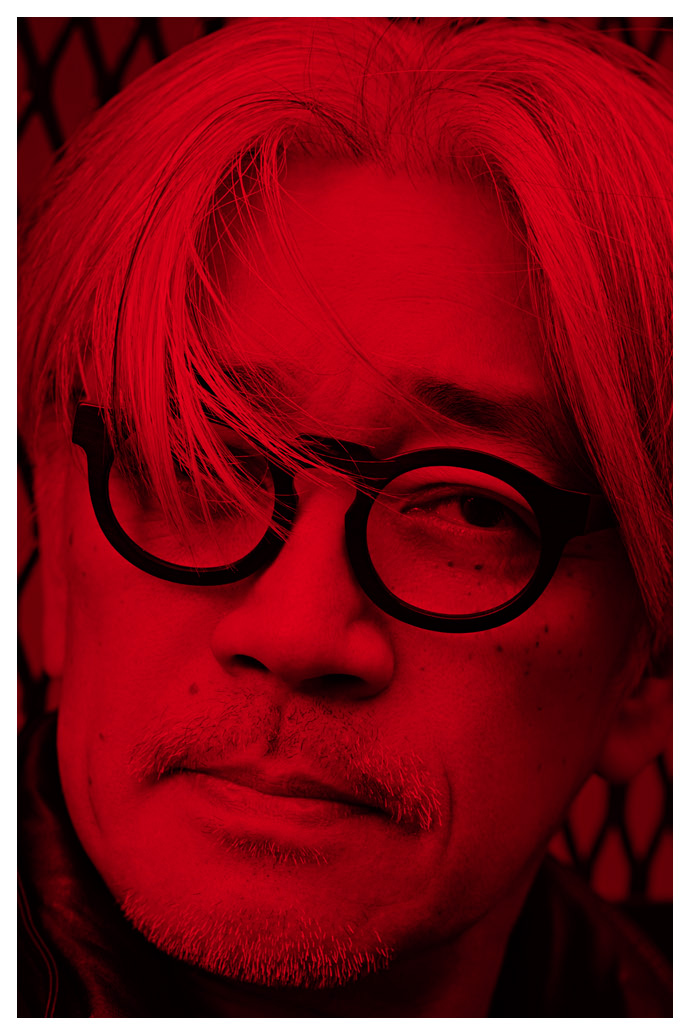 Left: inspiration board. Right: Ryuichi Sakamoto. Photography by René Habermacher.
Left: inspiration board. Right: Ryuichi Sakamoto. Photography by René Habermacher.The Stimuleye: When did you first feel personally concerned with the nuclear issue?
Ryuchi Sakamoto: Probably I started feeling anxious about it around the time of Chernobyl. Then I encountered the facts about the nuclear reprocessing plant in the northern part of Japan called Rokkasho. It was 7 years ago, pretty recent.
It’s not a usual nuclear plant, it’s to re-use, re-process used radioactive wastes. Through the processing, you emit hundreds of time more radioactive materials than the usual nuclear plant does. You get 365 nuclear plants in 1 village. Very dangerous.
So I started a web campaign, called Stop Rokkasho, I asked Kraftwerk to give us a sound logo, and they did actually ! The pretty famous graphic designer Jonathan Barnbrook had his assistant design the webpage, which was very neat.
As a web campaign it succeeded, my friends – photographers, musicians, stylists, creative people got to know about this plant. We decided to make a Stop Rokkasho tshirt, we asked more than 50 designers to make a tshirt. They needed phrases, so I gave them “No Nukes. More Trees.”
Everybody loved it, especially the second line.
It’s very easy to understand, and no one can resist.So, I decided to form a company called “More Trees”, it’s been 6 years, and we’ve been doing mainly conservation of Japanese forests. We have now 11 forests in Japan and 1 in Philippines.
(more…) -

MULATU ASTATKE: the bushes vs Debussy
-It may have taken decades, but the Ethio-Jazz sounds of Mulatu Astatke are now traveling throughout the world, through Kanye West samples and Jim Jarmusch films, reaching unlikely destinations such as the ecstatic crowds of Calvi On The Rocks in Corsica.
‘Doctor’ Mulatu Astatke as he likes to remind us, is not only a jazzman, but a doctor in musicology, who is eager to add to the lists of achievements of his home country, Ethiopia: coffee, inspiration to the Rastafarian faith, the invention of the musical scale, and it would seem, music conducting.
The bushes. Debussy. In the the mouth of Mulatu Astatke, it’s hard to hear the difference between the two.
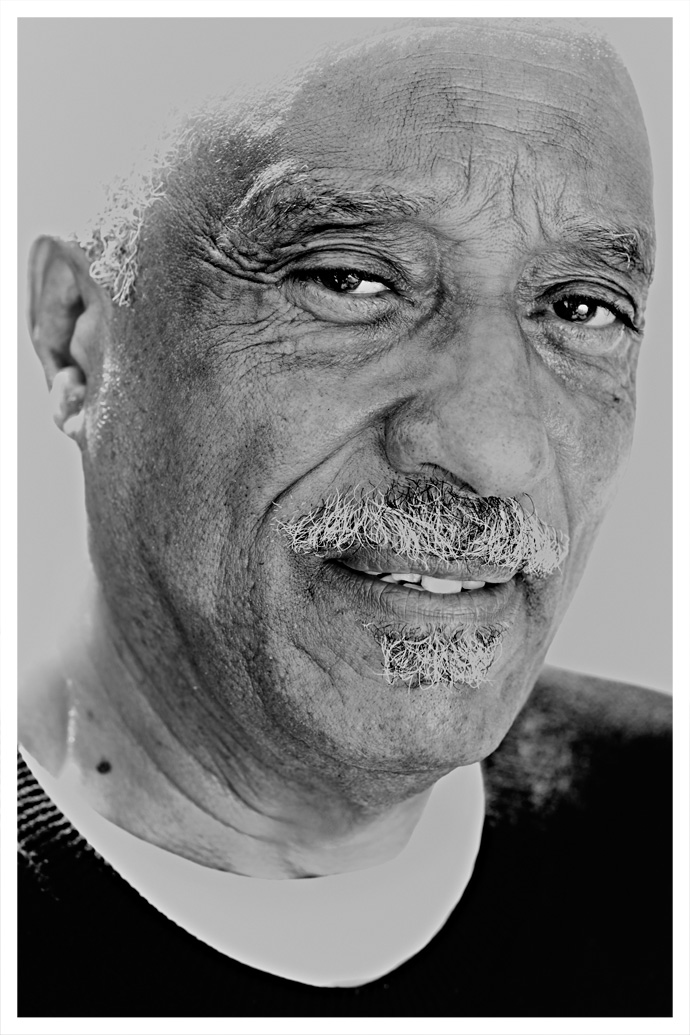
Doctor Mulatu Astatke, "Father of Ethio-Jazz" as his business Card states. Calvi 2013. Photography by René Habermacher.
René Habermacher: How did you come to be part of this festival that is very electronic music related?
Mulatu Astatke: Well, you know, I’ve travelled to Europe a lot in the last 3-4 years. The band became very popular, very busy and we did also a completely beautiful cd which will be coming out in October for the Jazz Village. People seem to ask for my band everywhere.
I used to be involved with electronic music a few years back with Heliocentrics on the album “Inspiration Information” (2009). But I really love acoustic sounds very much: real sounds, real music, everything. It’s good for the people to be able to get both sides, they can hear the acoustic but also the electronic music. I think it’s a very good idea to bring me to this type of festival. It’s great.
RH: How do you feel about the younger generation of pop musicians referring to your sound or even sampling, as in the case of Kanye West and other heavyweights of the contemporary pop generation?
MA: I remember the film “The Broken Flowers” by Jim Jarmusch, with Sharon Stone and Bill Murray. (NB- The soundtrack to the film features an eclectic mix of music, chiefly using instrumentals by Mulatu Astatke as the main score mixed with garage rock, metal and reggae.) The film really made a push and brought different crowds to my audience.
Then people started sampling my music. So my audience keeps on growing. I love it, I have no objection to sampling my music, because every time they sample, the crowds come too.I see all kind of people in London, in Paris, in Australia, everywhere, middle-aged, young, old ages, all kinds of crowd. It helps Ethio-jazz, and also for people to see different directions of music. So it helps so much. I enjoy it. Its beautiful.
Mulatu with drum sticks shortly before going on stage. The composer’s own signature instrument is the vibraphone, a set of graduated aluminum percussion bars that resemble a marimba or a xylophone. Photography by René Habermacher
RH: Ethiopian culture pioneered a lot of different things in music. Your work is part of that tradition.
Do you think because you were so pioneering it took quite some time for the deserved recognition to come in?MA: I put myself as an example and always say: never give up, just keep on pushing!
It’s so great when reality reaches what I always dreamed for this music to reach. If you just get to this point… it took me around 43 years!
The thing which takes time always give great results. It is what it is: as a musician you come to Paris, play Ethio-jazz, you go to NYC, to Germany, Denmark, Sweden, England: playing Ethio jazz.
And then suddenly this music just develops. Its a great recognition.I got my PhD from Berklee (NB – Boston, USA) and lectured in different universities all the time. It’s a great achievement for Ethio-jazz to be accepted at Berklee, a recognition of what we have given to the development of modern music, to dance and everything to the world. So I said: it’s not only for Mulatu, but this is a recognition of Africa, which is so great. So this is what we fight for.
Now I also do a lot of research at Harvard, at MIT and also lecturing for National Geography last month at the Royal Albert hall in London about Ethiopian contribution to culture and music.
I talk about African achievements and what it has given to the worldRH: So the theoretical reflection is very important for you.
MA: Very much! If you don’t know the historical aspect and the contribution of your country’s music, you can’t go any further.
The more you know, the more you do research, the more you enjoy.And the more you can develop the music and show to the world your own contribution.
So research is very important. For example in Ethiopia I go to the rural areas, to the bushes.
There’s one tribe, the Dirashe, who plays a diminishing scale in the middle of a pentatonic five tone scale country like Ethiopia.
In Ethiopia we play only five notes, that’s how Ethio-jazz developed: five notes against the twelve tone scale of American Jazz, you know what I mean. When I studied at Berklee, they were teaching us how Charlie Parker created the modern jazz through diminished scale. But this tribe plays a diminished scale. And great composers like Debussy are on a diminished scale. So what is really very interesting is these tribes have been there for centuries and centuries, so what I want to know is: is it Charlie Parker, was it Debussy, or this tribe ?Who was first? This is the question. These tribes people knew nothing, no painting, nothing, and they play diminished scale. I don’t know how they got it, because they are in the middle of a five note country. How did they manage to get this?
So I raised this question at Berklee and they were so surprised. What they said is: “Oh Mulatu- you got us!”
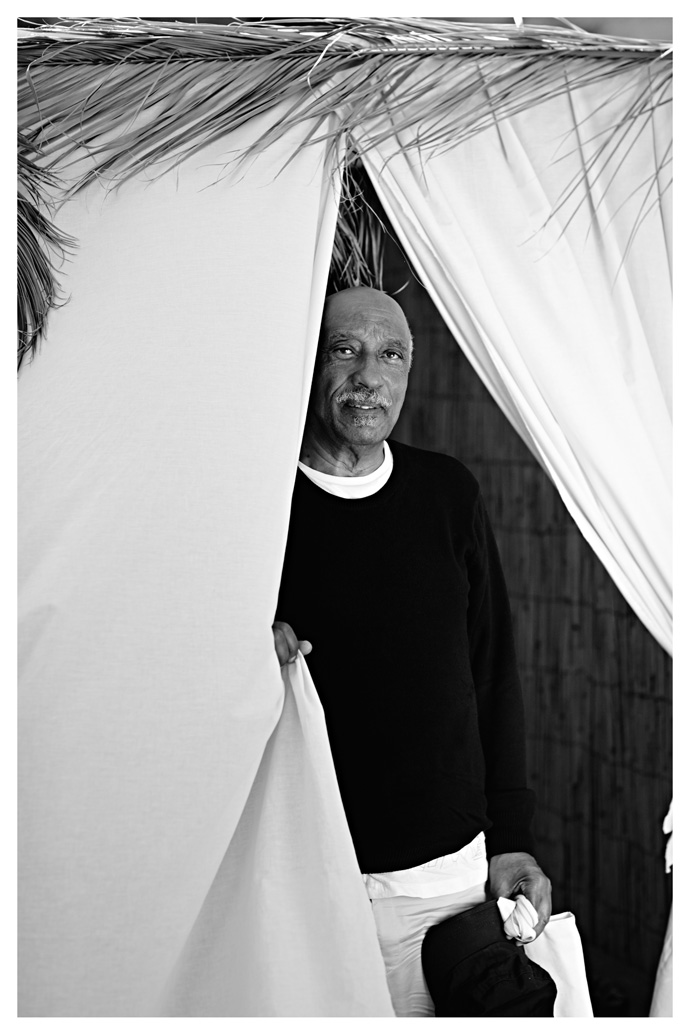 Mulatu Astatke received late recognition: Originally supposed to become an aeronautical engineer he was
the first African student in the late 1950s at Berklee College of Music — “the only place in that time,”
he said, to study jazz. Photography by René Habermacher.
Mulatu Astatke received late recognition: Originally supposed to become an aeronautical engineer he was
the first African student in the late 1950s at Berklee College of Music — “the only place in that time,”
he said, to study jazz. Photography by René Habermacher.RH: Is there a point where you thought the recognition is starting to come?
where you though somebody starts to understand what you were trying to do with Ethio-jazz?MA: In Europe and America, they understand and love my composition all the same. But when I went back from NY to Ethiopia, they didn’t like it at all, because they were used to this musical form that we call the current form: malalala…dalala (sings) I remember a long time ago there was a town that told me to get off stage. It was too complicated to them. They could not understand: “is this a joke or what is it?” Playing around: wabadawadawa?” – they don’t dig it. So I finished the piece and went off.
But now, after 10-15, 20 years they go crazy. The whole town of Addis is Ethio-jazz now.
Finally it’s Ethiopians! So I always say: keep on fighting, never stop. That’s the result.RH: When you worked with those tribes on interpretations, did they have any rejection?
MA: No. You know, I don’t touch them. I just work behind whatever is going on. I can write beautiful counterpoints and harmonies and they do their thing. I just tell them how good they are. What they’ve done to modern music, their contribution to the world. So they love it.
I do a lot of experimental work with this people. I do beautiful jazz fusions with them.
(NB- Mulatu once brought musicians from four different tribes together in an Addis Ababa television studio and orchestrated a cross-tribal fusion performance. This giving traditional musicians, many of them farmers, an artistic exposure beyond their tribes)
The ideal way to explore multiple forms of music is through jazz.
In fact there is a Dirashe track is on my new album, and another one with the Surma tribe.
It’s so interesting, I did an experiment with Fatou (NB- Fatoumata Diawara), the Malian singer who is featured in one song,
a fusion of their music with Ethiopian: east meet west. It’s so beautiful, its on my new album called “Sketches of Ethiopia”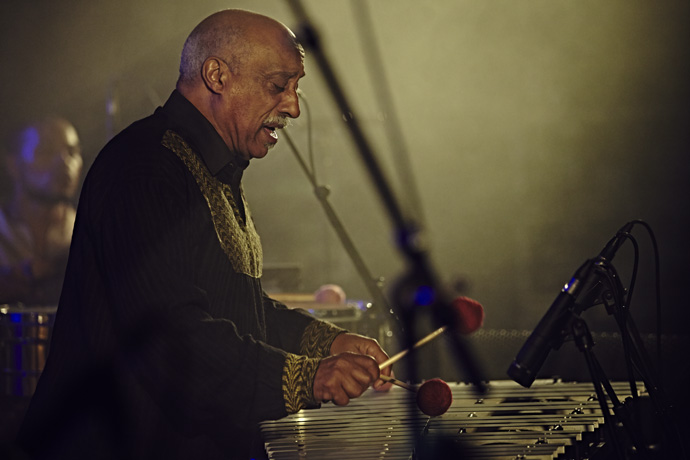
Mulatu in action at Calvi On The Rocks, Corsica 2013. Photography by René Habermacher
RH: Another culture that strongly relates to Ethiopian heritage is the reggae culture, yet in a very different way.
How is your relationship to this?MA: I really respect them for introducing the Ethiopian, the flags and their love to Ethiopia.
But even though musically we’re in different modes, different scales, different things. When you hear Bob (Marley) and the other ones they use mostly their own stuff.
So actually its not like Ethiopian culture or Ethiopian music, but this is their own way of appreciating music. I like them for promoting our country, for promoting our flag in this world, and for it to become like part of national art. We enjoy them, we love them so much! And now, you see they are adding a lot of Ethiopian modes, Ethiopian scales to reggae currently. There are rastas living in Ethiopia in a place called Shashamane.
Hailee Selassie gave them the land in 1948, so they stay there. And now they start to come into our music: Ethio reggae you know.
But now there are more young Ethiopian musicians, they do a lot of reggae. It’s great I think.RH: In 2008 you premiered a portion of the Saint Yared opera at Harvard.
Are you continuing on that project?(NB- The Saint Yared Opera is a project on Saint Yared who is regarded as a saint of the Ethiopian Orthodox Church and credited founder of the Ethiopian Coptic Church Music. He is believed to have been the first to write musical notes, centuries ahead of Western civilisation, and use an ancient form of conducting stick. The composition of the opera will blend the old and the new, and incorporate traditional chant texts in Ge’ez, the Ethiopian liturgical language, but as well electronic elements)
MA: Oh yeah. Thats very interesting. It’s gona be completed very soon. It’s already done actually.
The problem is that l am so busy travelling with other projects: I write for films, I do my experimental works.
I need two to three months to finally put the opera on a stage.This is a work I’ve done at Harvard.
My paper was about conducting being an Ethiopian contribution to the world.
We used to conduct music in the 6th century, with a stick called a mekwamia.Mulatu at Calvi On The Rocks, Corsica 2013. Photography by René Habermacher
So I studied the movement. If you look at the military band march, and the man in front waving sticks and things — 80-90% of that movement is from the mekwamia in Ethiopia.
But where did they get this from? This was before existence of symphony or conducting a symphony — and we have it. If you look inside the Encyclopedia, were there symphony orchestrae in the 6th century? There weren’t.So I said “OK, there were no symphonies, so then the conducting movement is taken from us.” Of course there were a lot of conducting, there were choirs in Europe of all kind.
But the most of the movement is what they use for the military also. If you use in the symphony a stick like this, the way you move it is exactly the same how we move it.
So they are telling us “you can do your reggae, you can do your jazz, you can do your rap.”
But they say classic music is purely European culture, which Africa has nothing to do with.
They are musicologists for Harvard, Yale, Princeton – so I said:
“look, I am open minded. This is what I found. If i am wrong, tell me, I am learning from you.”They couldn’t answer me.
So I say: “one for Ethiopia”. They said: “we’ll see.”[In the opera] there are two great conductors in the symphony, one european with a bow tie, conducting the symphony behind, and a church guy that conducts the choirs.
My dream is to do it in Lalibela (NB- one of Ethiopia’s holiest cities, famous for its monolithic rock-cut churches), the cave.
Mulatu at Calvi On The Rocks, Corsica 2013. In the late 1960s he had returned to Ethiopia with the first Hammond Organ and Vibraphones. Photography by René Habermacher
RH: What is the last thing that stimulated you?
MA: That’s really these people in the bushes. They inspire me so much. I have very great respect for them. The more you go closer to them the more you find them so interesting. They have created so many great musical instruments.
Now there are instruments in the bushes they sound like trumpets but made from bamboo. Strings, sound like violins, cellos, that kind of thing.
So I was wondering, let’s do a research – who inspired who ?
When you see these people never had a chance to go anywhere, they have no television, they have no radio, – they have nothing.So I always think they inspire the developing world. Those are the people that inspire me. The more you go everyday, you learn something.
New ideas, something interesting from those people. They inspire me.We call them backwards. But they’re not backwards people to me, they are advanced people.
They are ahead. So this this is my life now. I listen to them.
Whenever I have the chance I am in the bushes, I go close to them.
It’s so interesting, so beautiful. That is what inspires me truly.
Upcoming concert dates:
AUGUST 10 – Paris, Trianon -

Kostas Murkudis
-Putting Kostas Murkudis, with his East German utilitarian approach, at the helm of Closed jeans, a brand defined by the relationship between function and form, is a match in heaven, in a time where the initial idea of fashion is caught between mass production and the arbitrary grip of luxury-obsessed conglomerates.
They each bring their own interesting history and their associations to big names to a collaboration very much anchored in the “now” – on one side, Marithé and François Girbaud, who founded Closed in the 70’s, and on the other, Helmut Lang, with whom Murkudis worked during the label’s early and formative years, though both brand and designer exist in their own right.
For women’s fashion week in September, Closed will open its first flagship store in Paris.
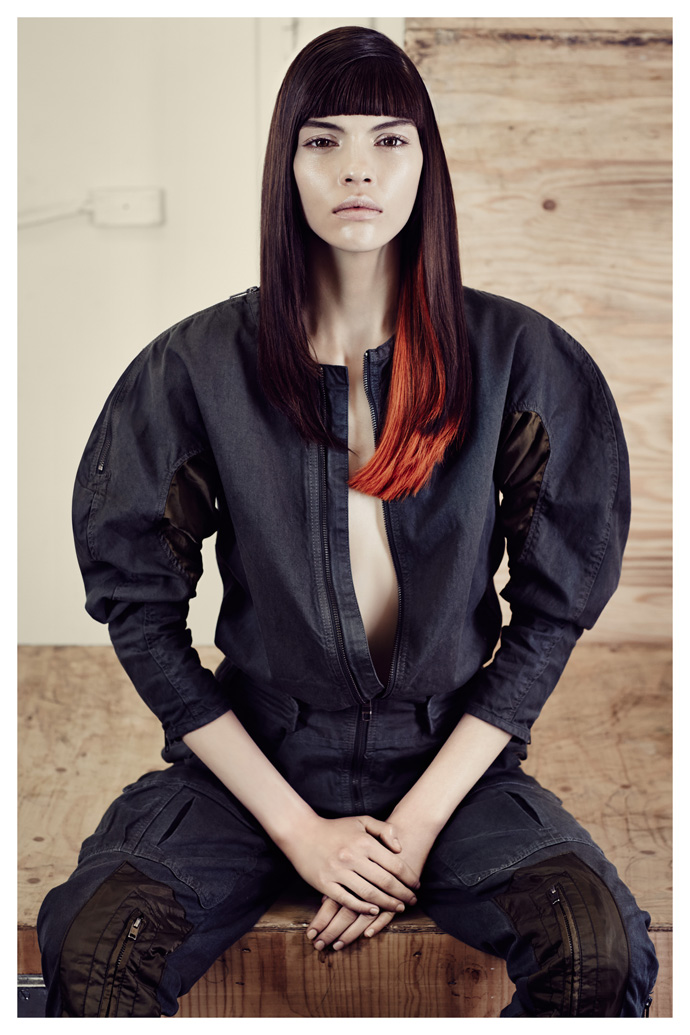
Overall "Illusion" from the FW 13/14 collection by Kostas Murkudis for Closed Jeans. Photography by René Habermacher
René Habermacher: When I heard you’d be working for Closed jeans, I thought it made great sense with your approach – sustainability, resistance, utilitarianism and uniformity are expressions that come to mind when thinking of your work, and all of these seem to be relevant in the context of jeanswear.
KM: I grew up in the DDR (German Democratic Republic), in East Germany, so these are surely aspects of my work that I value and are part of my professional ethos that I will follow up into the future. It’s my contribution, to make it accessible to more people than for example with my own brand.
I always had “two hearts beating in my chest”: one more poetic, free of necessities, and the other that is more about durability and functionality everyday. I always loved the approach of the Bauhaus, it is very important to me. But I really do love both aspects. Now with my new mission at Closed, I can really apply everything you described, I have all tools and a fantastic team I love working with.
For me this is the perfect balance between the two brands.Whereas with my own brand, my mini-label that I call my laboratory, I don’t have to think about whether the piece is really durable, has the right pocket or whatever. I just can do projects important to me, which do not necessarily have anything to do with fashion. For example recently I have worked with a royal glass manufactory in Munich, Lobmeyr, that usually do stuff like church windows etc. I think there are so many possibilities and I am very curious for new challenges.

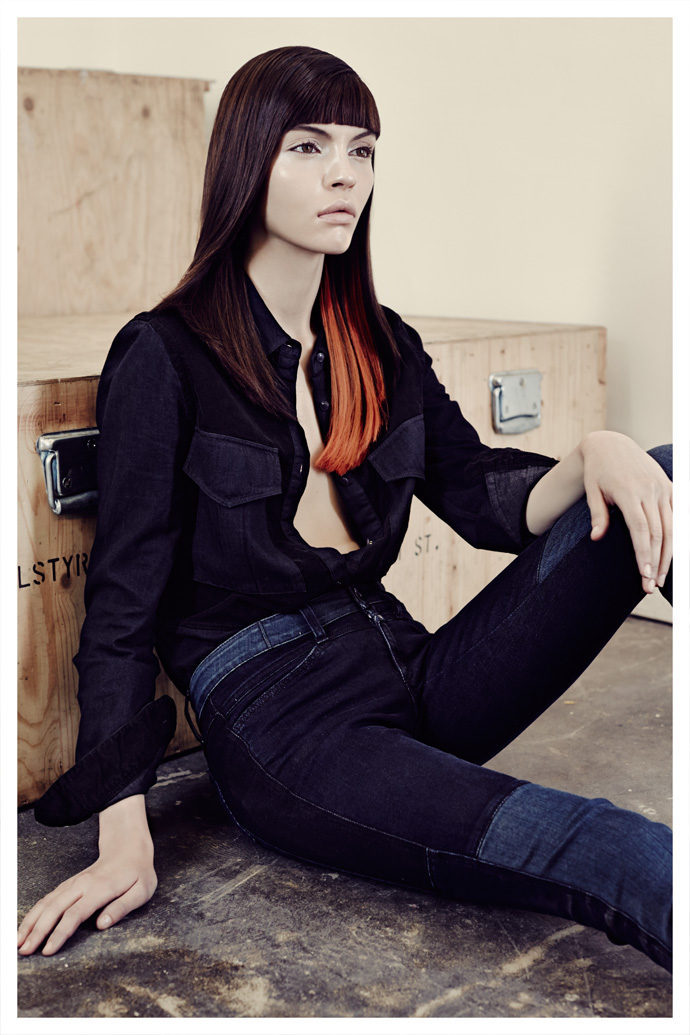
Shirt and Jeans FW 13/14 Kostas Murkudis for Closed. Photography by René Habermacher
RH: You’re working for quite some time in fashion now. When you started, fashion was something different: in the 90’s, fashion still had a socio-cultural context, was a compass and expressive part of movements. Today it’s different, its not really that a social movement expresses anything through dressing codes.
KM: That’s true and has obviously social, socio-political, and sociological causes. There is very little happening that could tempt for re-orientation. I do really hope that finally something will be happening. Or has it started already? When you look what is going on in Brasil, or Turkey, in countries where I would not have expected that this kind of movement would be surfacing.
The situations in Greece, Portugal or Spain, France and possibly soon England, don’t look so great either, but something is happening and I am hoping very much that this will spread across cultures and regions, and maybe create the necessity to develop new codes. Obviously they have to develop themselves, we as designers can’t help it.
RH: For quite a while fashion hasn’t had a cultural value of progress, it has become more a simple “garment industry.”
KM: That’s right. Fashion is not allowed to be like this anymore. It’s the very capitalist approach to define success only through growth, to which the big houses are forced to: generating work, circulate money, this and that – it’s not about content at all. In fact it is even arbitrary who designs. It is the brand with its margin that is in focus.
If that’s what’s thriving in society, fashion can only be its image.On the other hand, design has become another aspect – let’s take an example like the iPod, or the iPhone and what has been generated here: a simplicity, practicability and a beauty of objects that have not been produced like this in a while.
It’s not about developing funky variants and decorations, but to work continuously on refinement and improvement with every generation, which I believe impacts our everyday culture. Even kids are not seduced to just buy something new because there are some new crazy buttons added. And you don’t have the desire to buy a jeans with 25 embroideries and absurd stitchings on the butt that are completely pointless. This pointlessness, this battle of material is not working anymore.
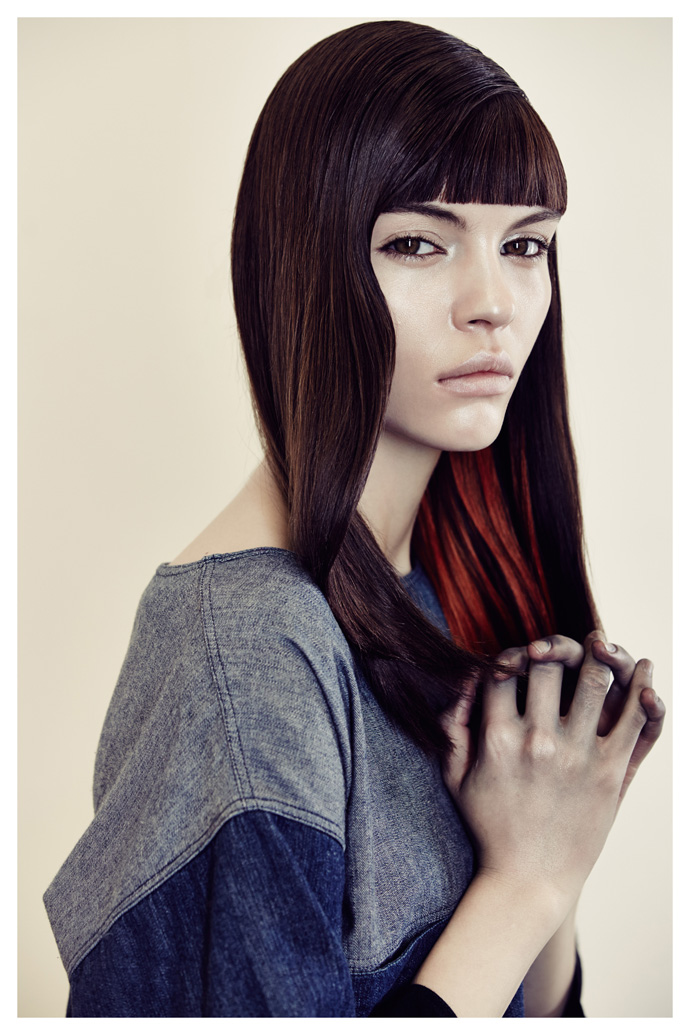
Jeans dress FW 13/14 Kostas Murkudis for Closed. Photography by René Habermacher „First there is nothing, then a deep void and finally a blue depth.“
Yves Klein.(Leitmotif for the colour codes to the SKYWALK CAPSULE COLLECTION No.1)
For example my brother Andreas, who owns a concept store in Berlin, he affords himself the luxury to buy only what he thinks is really good, regardless of the label. He buys what is up-to-date in his eyes. He was totally shocked about the pricing for which it’s possible to get good design that is on top politically correct produced in Italy: good quality fondly fabricated from great fabric. Not that this is world changing…
RH: But democratic?
KM: Democratic in a positive way. I didn’t really want to use that word. When my brother saw the Skywalk Capsule Collection in Berlin, he went to order straight away several looks from the FW collection, saying: “wow, this is really cheap- and so cool, but really cheap”.
Of course we have the same approach, maybe also because we grew up in the DDR: for us longevity or functionality and beauty don’t have to cancel each other out.RH: What is your relationship to glamour?
KM: I try to stay remote, but sometimes have to make compromises. My relationship is rather an aversion. I come from a very simple background and it really does not touch me to hear “who was where with who wearing what”, that doesn’t interest me.
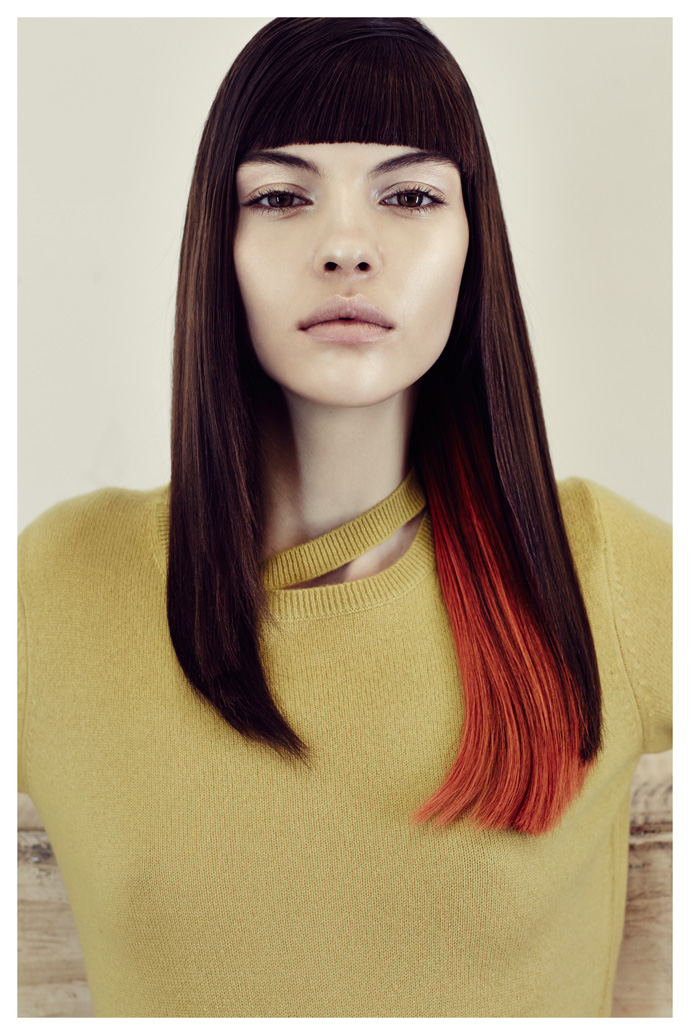
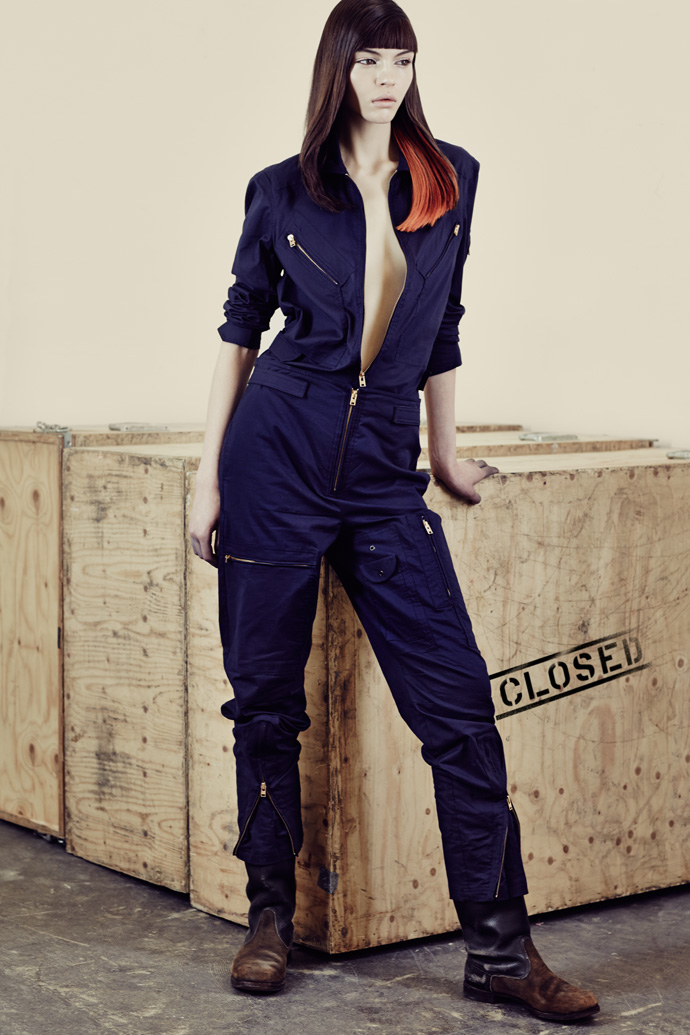
Right Side two pieces from the SKYWALK CAPSULE COLLECTION: Murkudis took inspiration from a vintage aviator suit, using the cuts and details to create a minimal wardrobe: a shirt, a blouson and pants for men and women. Boots: vintage DDR army. Photography by René Habermacher
„Earth is a delicate shade of blue“
Yuri Gagarin (Leitmotif for the colour codes to the SKYWALK CAPSULE COLLECTION No.1)
RH: Tell me a little more about the Skywalk Capsule Collection…
KM: The idea was based on the desire to bring the brand back to an international level, and the one of the brands defining aspects: the idea of unisex, that I thought very interesting and gave me also the possibility to explore menswear more, find a different angle and define their image more sharply.
Because the project was a very small range, I had to stay quite precise as well in material as colour and design, but it was the first time that I had the chance to show pieces that one actually can afford. If you look at the product, it appears at first sight quite minimal, even though its technology is actually very complex, which is something I wanted to put forward as well.
But because of all this, it was quite obvious to me to give the collection somewhat of a poetic moment.
RH: Yet here is also a practical thought behind it?
KM: Of course. It was to show the brand’s core, and a product that should function in the everyday life over long time.
Apart from that, the beauty of a product becomes apparent in its use, becomes part of our lives and our bodies. That’s what makes a jeans. It only becomes your jeans, and a great one, when it deforms on your own body, through use, through touch, through creases, through whatever. It becomes part of your being. That makes it truly beautiful when it is beautiful.
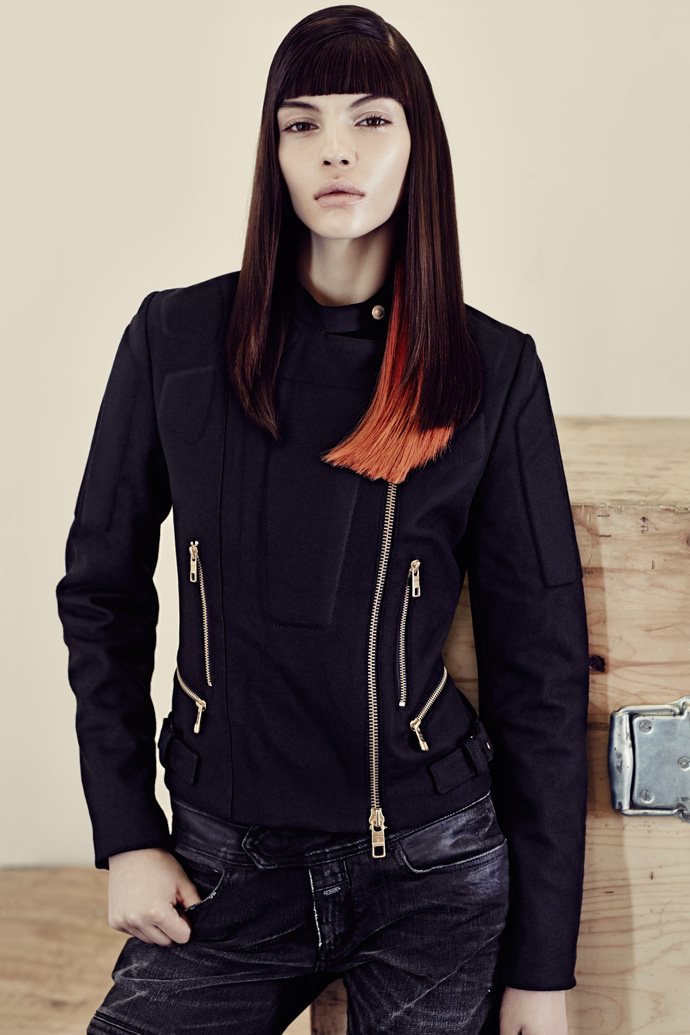
Felt Perfecto Jacket and Jeans, both FW 13/14 Costas Murkudis for Closed. Photography by René Habermacher
RH: With a clientele living in the most various meteorological conditions, does it really make sense today to produce season-oriented collections?
KM: This is a totally legitimate question. Also as we know that the big producers often deliver new products up to twelve times a year.
So for smaller brands it is indeed worth considering to orient themselves differently because they have no chance to stand up against this moloch of an industry.In a way we are overtaking ourselves with everything: when the sales start the season hasn’t even really begun, there is a resort collection, a pre-collection and a in-between collection- that is all a bit absurd. I see that with my brother, who says “I don’t need a pre-collection that is delivered in November when its perhaps snowing here and -30 celsius”. That makes no sense.
On the other side I am bound to the cycles of the classic way of producing 4 collections a year.
I think the problematics are there for everyone, but no one has yet found an ultimate solution, or takes the risk to say ‘I am going to position myself entirely new in this context.’RH: In your case do you do a presentation, or are you considering eventually a show?
KM: Right now this is not a real topic for us. Maybe next year or after that, it really depends on how we develop and what our expansion will bring.
RH: The one thing I find puzzling is with all the coverage on the shows, once the products are in the shops, you are already bored of them.
KM: I totally agree with you that three weeks after the shows you vaguely remember and when the products are delivered to the shops you practically forgot about it all. This wish and desire to own the pieces immediately is fading in that period.
But that’s what you have Zara for: they deliver within three weeks after the show a dampened version for those who can’t wait at all and never really got it anyway: those will buy the cheap copy (laughs).
By then the others just saw the newest collections and are wondering that they have ever liked the current one…. I look at this smiling.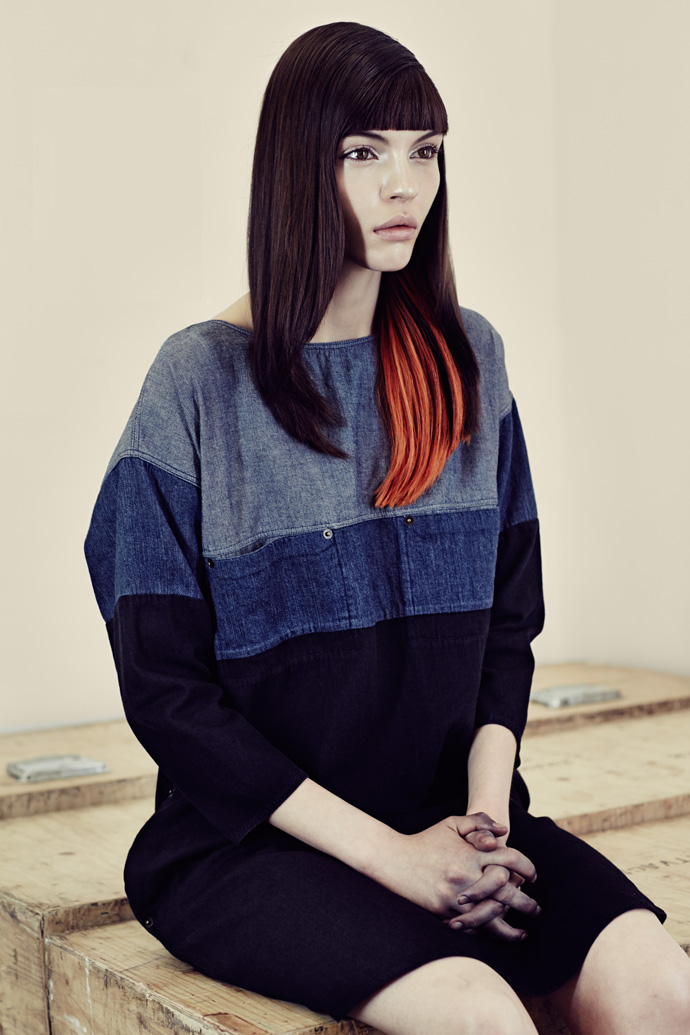
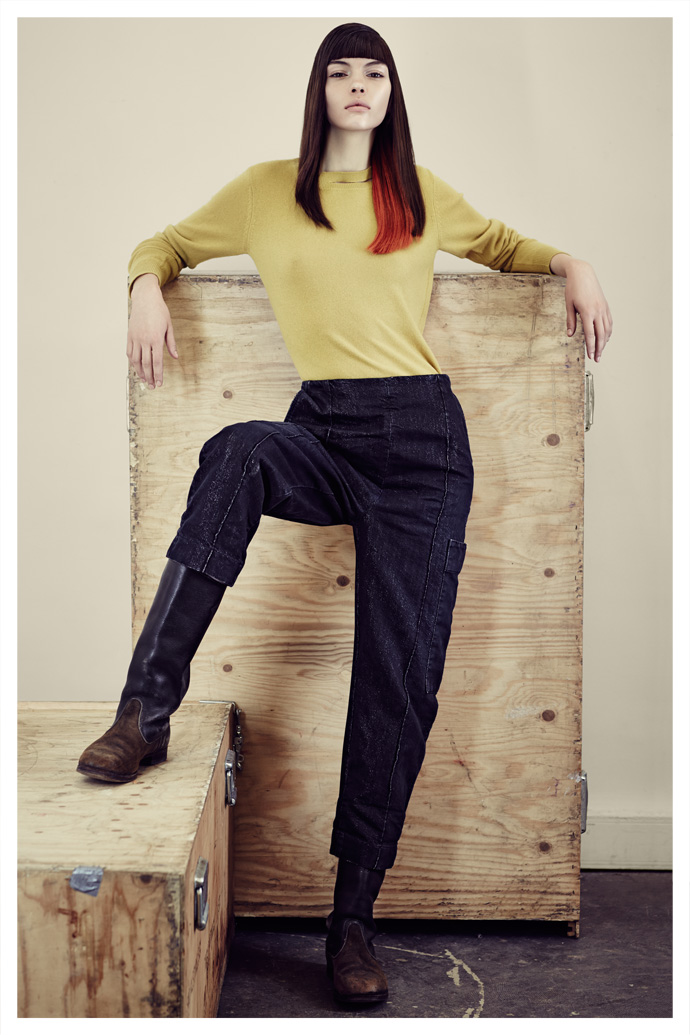
Left: Jeans dress, Right: Split neck pullover and Jeans, all FW 13/14 Kostas Murkudis for Closed. Boots: vintage DDR army. Photography by René Habermacher
RH: You do have a special relationship with Japan, is that right?
KM: Yes, when I was a small kid, I started to do judo. I had a fantastic teacher that I absolutely worshipped as a living hero.
I was excited to wear these suits, the belts. The scent of the mats, the bows, this outlandish language had fascinated me. To me it was of course an escape from my Greek moulded DDR prosaicness and the pressure to perform. I did virtually absorb all these words, ceremonies and preserve within for years.When I started to be interested in the arts I read a biography of Yves Klein, and realised he was a judo master like me, and eventually lived in Japan. I think his work was to some degree influenced by Japanese moments, in their simplicity and splendidness. This has really accompanied me ever since. The Bauhaus would have been unthinkable without the Japanese influence. In many aspects this influence has developed with me, the desire towards the exotic but as well the austere, the sophistication and the celebrated. The handling of colours, surface but also the poetic moments and the spiritual aspects behind.
I celebrated plenty successes in Japan and grew with these, so I owe a lot to the Japanese. We found each other. I was always fascinated and excited about it, to the point that Gordon, one of the owners of Closed, and I started to take Japanese lessons.
This hunger is not satisfied yet- and will always find itself in my work again.
RH: What is the last thing that stimulated you?
KM: I was very inspired by the exhibition of Martin Kippenberger: the incredible freedom of a man in dealing with the most different tools. I have great respect for his state of mind that moved me to tears of joy. I haven’t laughed that much for a while. All my senses had been spurred through this.
This interview and photographs are a Stimuleye exclusive
interview and photography RENÉ HABERMACHER
fashion editor SUZANNE VON AICHINGER
hair JONATHAN GEIMON @ AIRPORT AGENCY using Bumble and Bumble
make up MIN KIM @ AIRPORT AGENCY
model KATE B @ NEXT MODELS
thank you VERSAE VANNI @ NEXT PARIS
and LIBRAIRIE Ofr PARIS for your support -

undercover (and inside out)
-Japanese designer Jun Takahashi, the creative force behind the cult label Undercover has been a major influence in Japan’s fashion scene for more than a decade.
After vanishing for two years from the Parisian catwalk, he returned with a vengeance and presented his new collection to an audience that awaited his return, with mix of patience and restlessness.
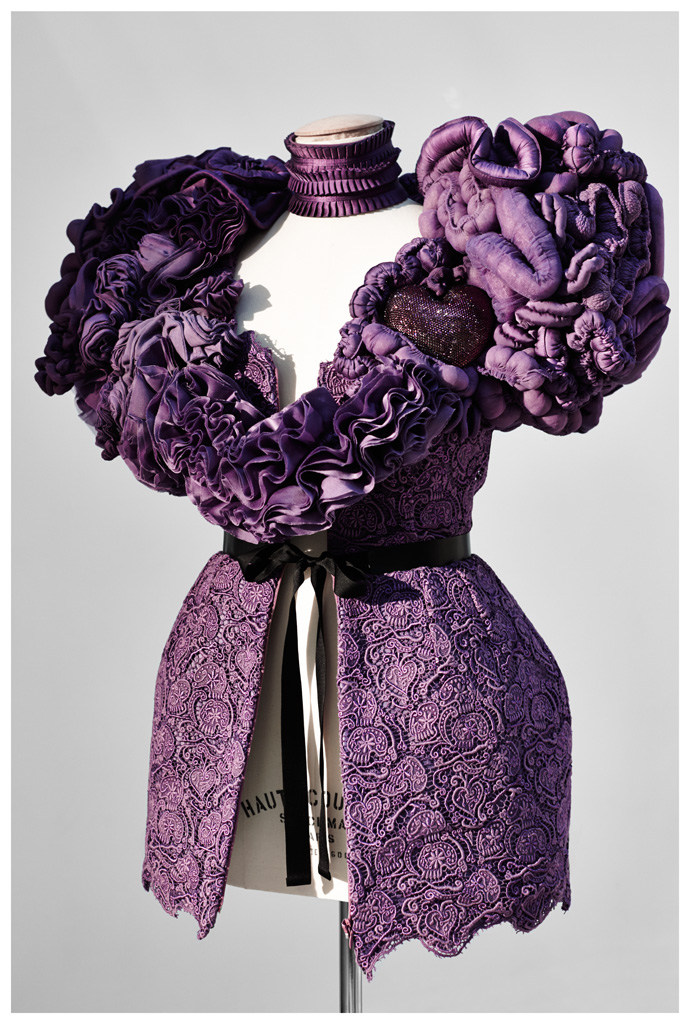
Inside out: Undercover dress with entrails, bone and skull lace, a heart on the right spot for the scary cute. Photo by René Habermacher.
The show at the intimate venue of the Institute Pasteur started with much delay, yet the undercover flock of disciples, among them the devoted Grace Coddington, awaited patiently what was to come from behind the antique glass-panelled doors: scary kittens with bunny masks on ponytailed shoes, wearing their insides out, ribcages and organs on outer display. Skeletal hands grasping waist lines, vintage lingerie elaborately piled-on to sleeveless evening jackets. Little dresses with what seemed to be ruffles at first glance, turned to be a romantic interpretation of entrails slung around the décolleté and a sparkling crystal studded heart.
Surprising,- or in the case of Jun Takahashi actually not- the arch from the drama of the unique pieces to the extremely wearable parts of the collection: googly eyes on a waxed trench coat, or the return of Undercover’s signature pieces, the perfecto, and the trench, with double collar and worn as a dress.
This is where the strength of Jun’s subversive vision lays: there is no friction between the everyday pieces and the elaborate constructed parts of his universe. Seamlessly he migrates between outfitter to the urban hipster to action art performer creating his giant Grace dolls from vintage plush toys in front of a bedazzled audience. The Graces, creatures from outer space were originally created for the presentation of the Undercover collection SS09 became somewhat of the labels mascot.
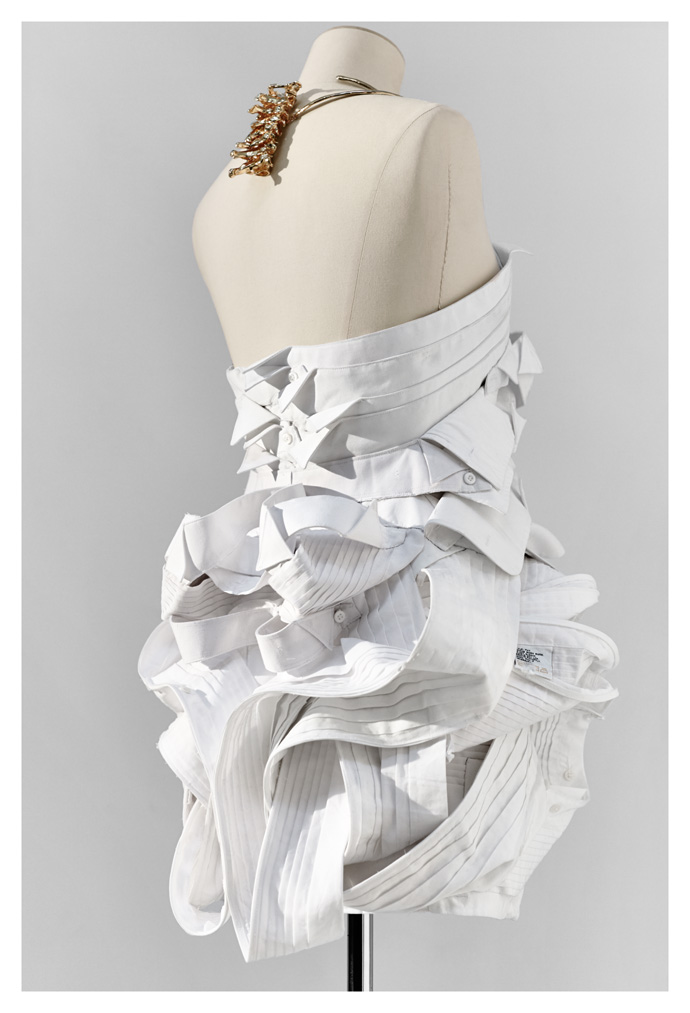
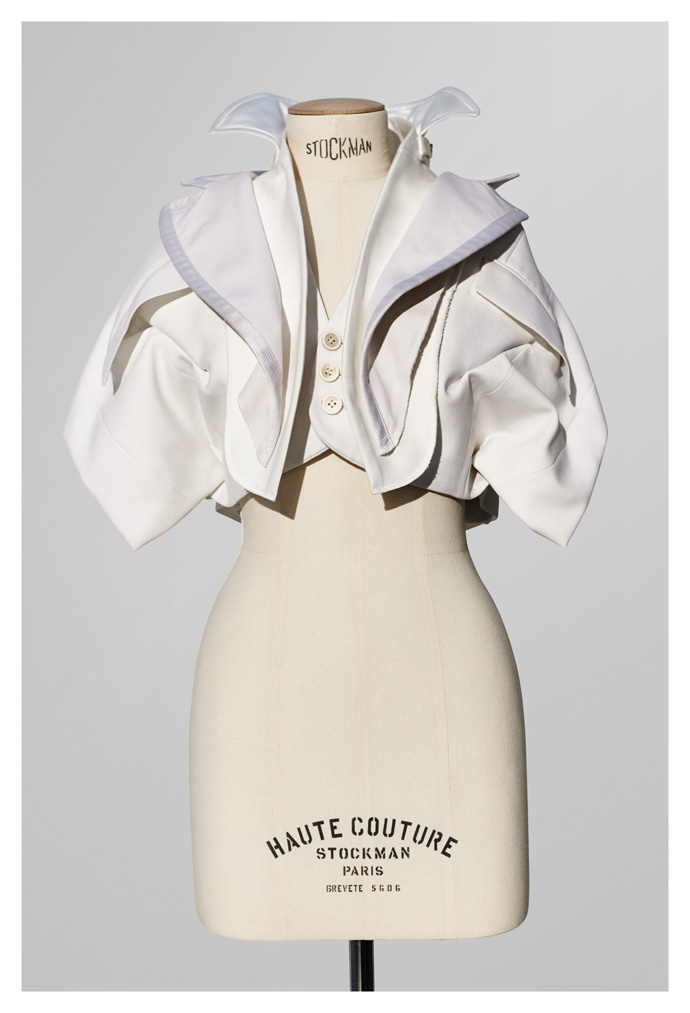
Starch undercover: special pieces made from deconstructed men's white shirt collars. Photo by René Habermacher.
René Habermacher: How is it to be back in Paris?
Jun Takahashi: It’s very exciting! Its been two years since we had the last show, so I am so happy!
You received well deserved great critics for this show of return.
how did you start with this collection, and how did it evolve and what is the narration?Last season when we came back to paris having just the showroom, I made seven special crafted pieces. It’s been a while since I’ve made such a creation and enjoyed it a lot.
It was just for the showroom, but this season i wanted to present a collection on the runway to show it to a broader audience. That’s how I started this collection.
The theme of the collection is about internal organs and bones, showing something from the inside exposed to the outside. Like lingerie that is usually hidden underneath, I used to make dresses and so expose them to the outside. That’s kind of the theme of the collection.Why did you decide at this moment to take the inside to outside?
I don’t know why (laughs). It’s been a while I wanted to show the “inside”. This is very undercover. It’s easy to express “Undercover”.
The motifs of organs and bones have something grotesque and scary in peoples minds. I take this and make it cute. It’s about both sides: not just scary, not just cute. we have both sides in the brand.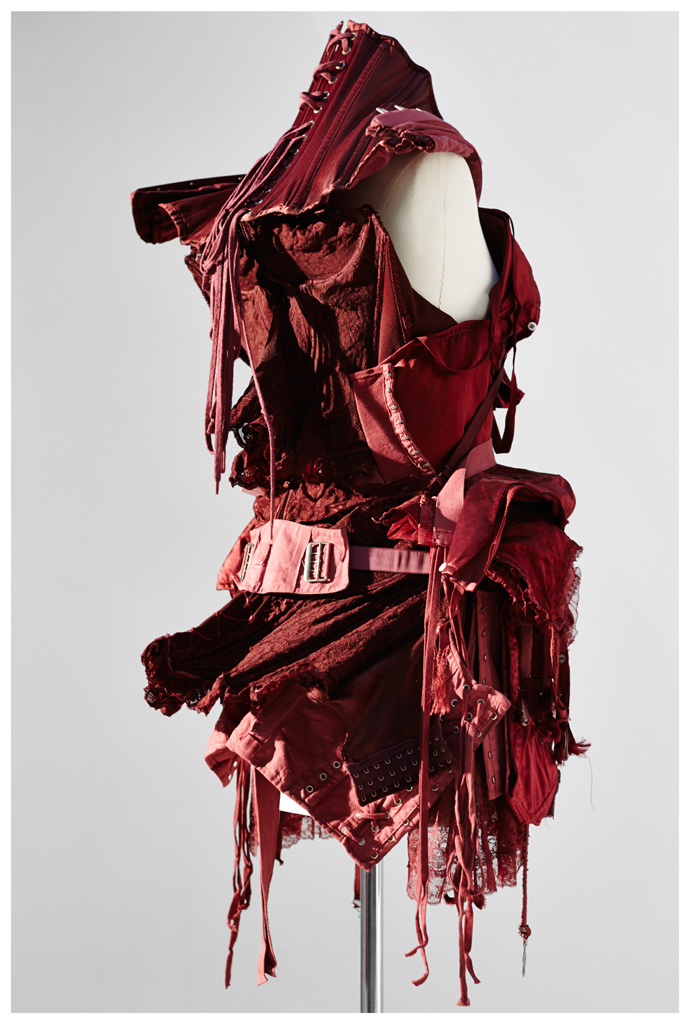
Pile-on vintage lingerie evening jacket. Photo by René Habermacher.
Are you a story teller?
(laughs) To me show is one big story, one drama, one stage. In a way I am not just making clothes, but one big tale, a story.
Since I was little I preferred the scary stories. I like Hitchcock movies. I am not necessarily into the ghostly but prefer the mental story.Another aspect is a strong sense of subculture evident in your work.
It is very different today then when you started off. What is subculture for you today?Most of he people surrounding me in Tokyo come from subculture, its a normal thing for me – its music, movies etc. not the mainstream. People in subculture are not specifically specialized in something – they don’t have mass-apeal. I like that. I source from this and then present my version in the “mass-area” like Paris.
Do you think exposure is dangerous for subculture?
The dark side of sub-culture! (laughs)
I take this positive. We always want to have information very quick- and I find this bloggers taking snapshots in the street very interesting, it’s really like I use the internet. How quick they are, it’s impossible for the print to catch up. Myself I like to post on Facebook and use the internet as a communication tool.Is the “season” still relevant to you?
When I design i don’t really think of the season. But when it comes to selling, we have to take this into consideration. For example in Japan we start selling FW collection in July, which is very difficult to sell Winter clothes because its still very hot for another 3 months until October. So we have to think about the balance between the creation and the business. So that’s difficult. We cannot completely ignore the seasons but not only thinking about seasons.
The runway shows’ timing are getting earlier and earlier and it takes time to actually get in the store.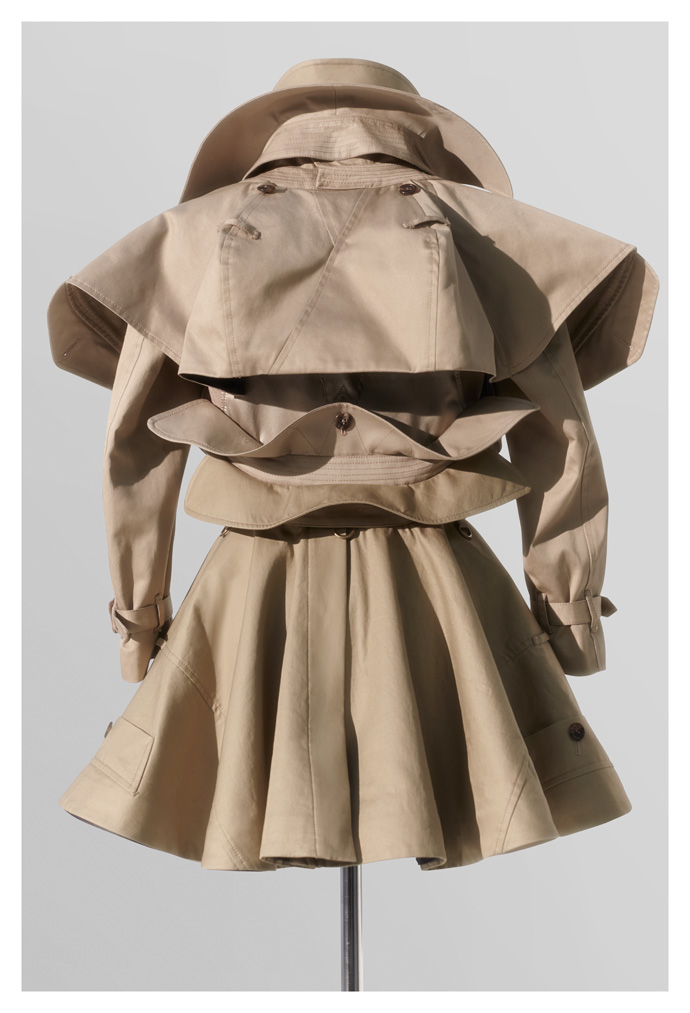
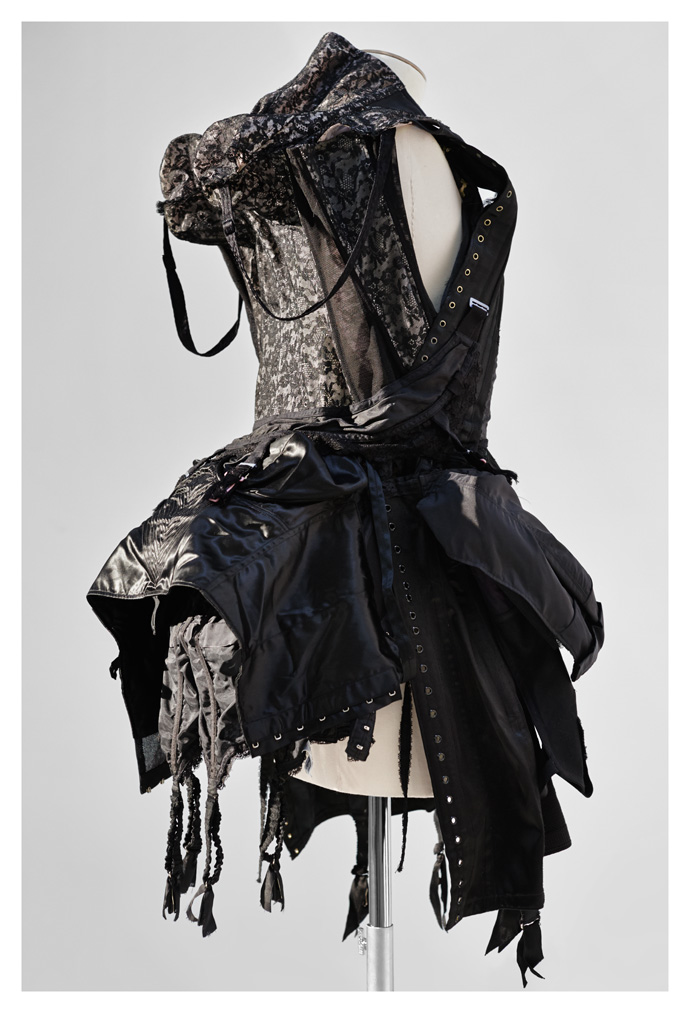
Undercover signature: the trench. Right: Pile-on vintage lingerie evening jacket. Photo by René Habermacher.
How is Japan to you today with the changes the country had been affected with the tsunami and the Fukushima incident especially?
Since the disaster was such a big thing and with the economical situation everybody’s feeling was like “hit the bottom.” We cannot be worse anymore. But now the people are actually trying to go up to be positive, they step back and reflect what can we do to recover from such a disaster. Maybe the government is not helping us that much, but people are trying to do something themselves, try to get the economy back and be positive.
How do you imagine the future your kids are growing up into?
They are little kids right now, but they are starting to have their own will where they wanna go. I am not so worried about them because they will find a way by themselves. We’re concerned about the future and the nuclear problem in fukushima, the earthquakes and what kind of effect this will have on us, but my kids will find their own way so I am not too much worried.
Are you still telling your kids stories of Grace? How is Grace, will we hear again from your creature?
I will continue with Grace- but Grace is not for little kids. They get a little scared… with one eye and all that.
I have a Grace doll in my house but at the beginning the kids were a little scared.But if you were a kid you would not be scared…
It’s scary – but there is an attraction too!
What’s next?
Showing the next collection in Paris again!
What is the last thing that stimulated you?
So many various things! conversations with friends – it’s not just one – it’s many different things.
I absorb everything. Family and friends are important. It’s important to have close friends that are straightforward in their opinion what they think about me, instead of just hiding things. It’s important to me to listen to them. A lot of my friends are creators, photographers doing their own thing. Their opinion is very important to me.
As I get older I get inspired and stimulated by more and more things. I can accept anything like a bus ticket.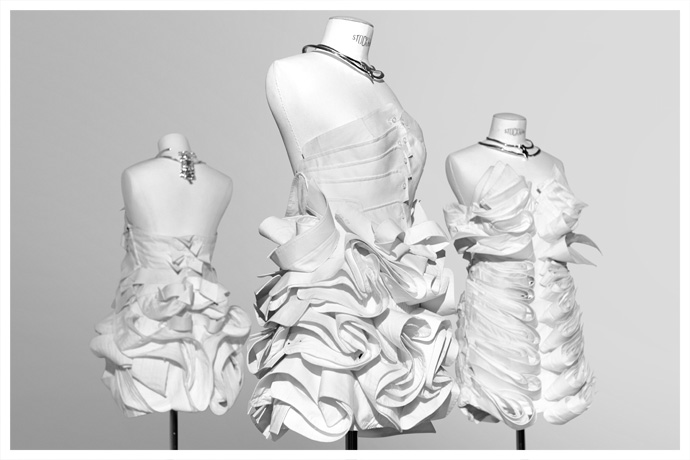
Trilogy in white starch: dresses from deconstructed men's white shirt collars. Photo by René Habermacher.
http://www.undercoverism.com
-

john lawrence sullivan : in the ring
-Tokyoite Arashi Yanagawa, the man behind menswear label John Lawrence Sullivan, has quickly become a fixture of the men’s fashion circuit.
The choice of name for the label is perhaps the most telling. John Lawrence Sullivan, the man, is a heavyweight boxing champion, also known as the “Boston strong boy,” and godfather of sorts to Arashi, who quit a promising boxing career to fight in another type of ring.
Ever since entering the seasonal arena of fashion week in Paris, he’s championed his collections in the eye of attention, with the likes of Suzy Menkes a constant follower. In this context, Arashi’s unconventional vision of the sharp tailored sportsman is most compelling.
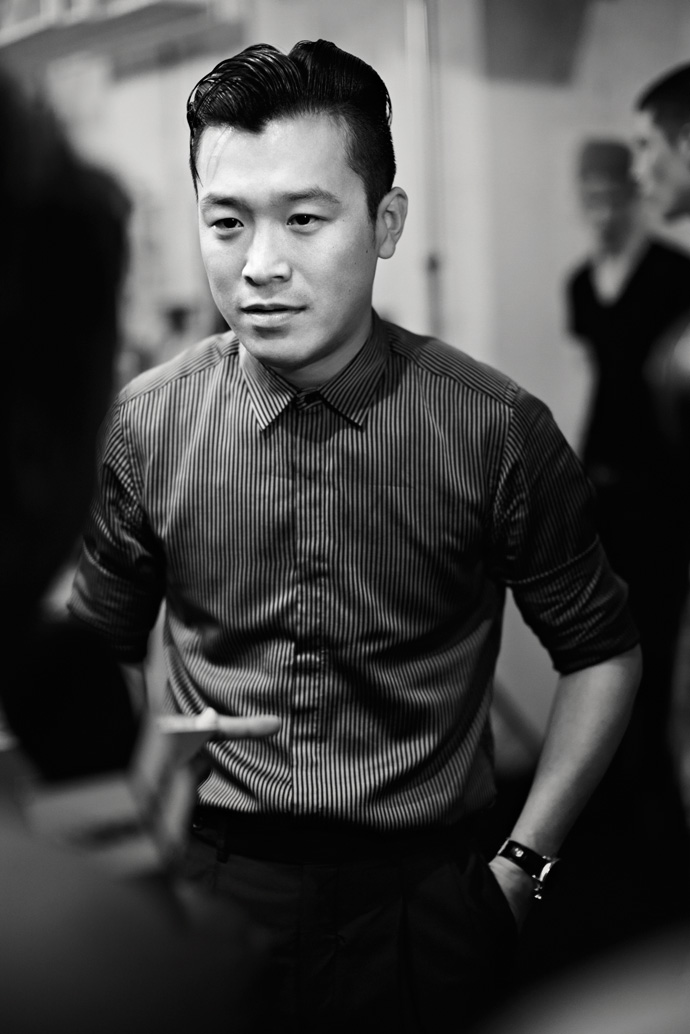 Arashi Yanagawa backstage after his John Lawrence Sullivan presentation. Photography by René Habermacher
Arashi Yanagawa backstage after his John Lawrence Sullivan presentation. Photography by René HabermacherRené Habermacher: Hello Arashi, how is it being back in Tokyo after your last show in the ring fight of Paris fashion week?
Arashi Yanagawa: I’m getting ready for the next match in June. While I’m always relaxed in the end, I also always begin thinking about the next collection right away. It’s exactly the same as in boxing.RH: In your work, specially your most recent collection, I sense a strong fascination with British culture.
but you’re successfully showing your 3rd collection, you chose Paris to present it…
AY: I believe Paris is the most important location for fashion in terms of the both the culture and the history of the industry. Paris has a special eye for beauty and elegance. No other place draws as many journalists, buyers, and fashionistas. All of this naturally makes Paris a very attractive city for presenters, but I also appreciate how strict everyone in Paris is towards creativity.RH: And what is it with you and London?
AY: London has street fashion just like Tokyo, but it also brings history and tradition into the mix. I’m impressed by the way all of this culture has just naturally rubbed off on the younger generations. Another example of something that has really moved me is the culture of the London market where you see young people today buying and even demanding clothing designed a century ago.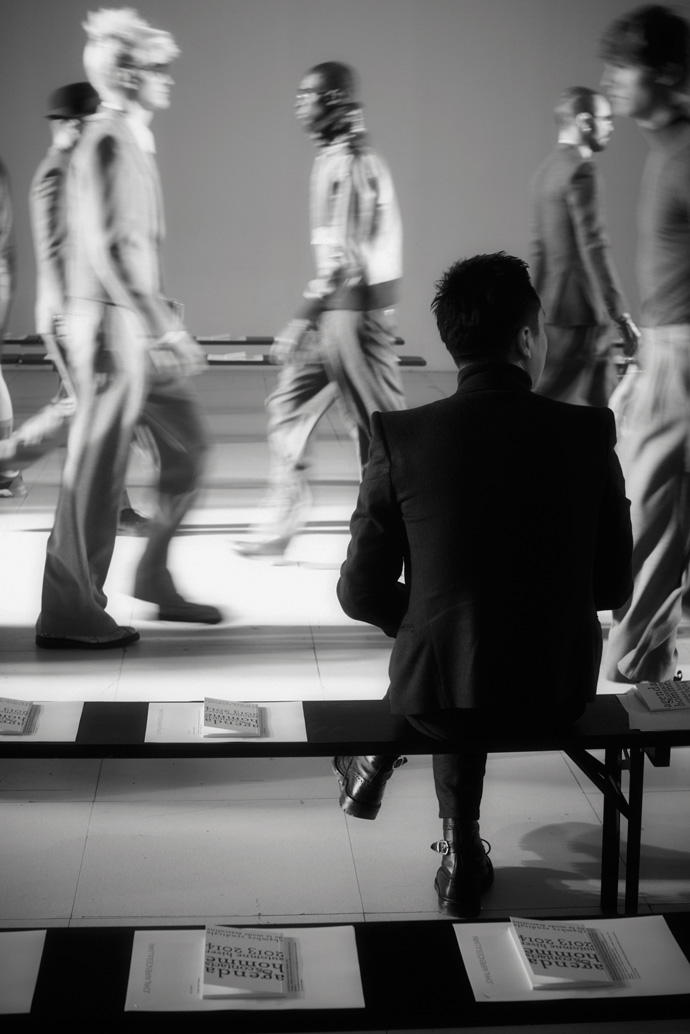
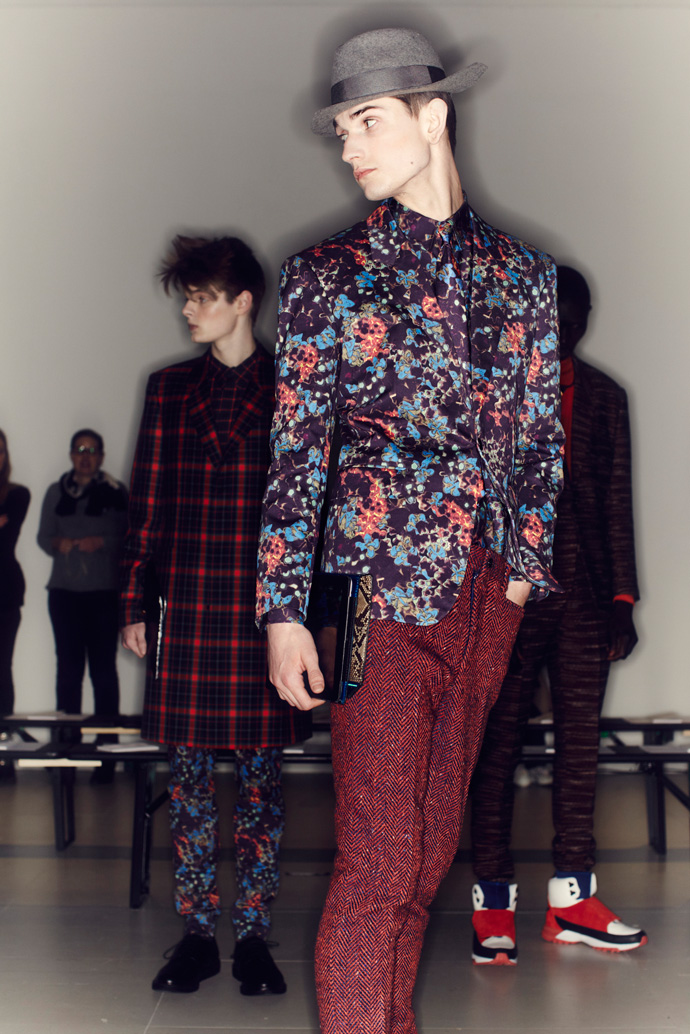 Rehearsals for John Lawrence Sullivan FW13. Photography by René Habermacher
Rehearsals for John Lawrence Sullivan FW13. Photography by René HabermacherRH: how do you decide for what you’ll go next? what is your creative process?
AY: I input the “sense” of the things I see or hear in my daily life and stockpile them. These could be colors, silhouettes, light, or even materials. But, I make an effort to express my own sense of the now rather than just making things based on historical research.RH: For the current summer collection the theme was influenced by the Bauhaus movement.
Why did you feel the urge for this now, and how did you translate that into the clothes?
AY: I had a chance to go to Berlin, so I paid a visit to the Bauhaus school in Dessau and took in the artwork there. I found the combinations of wood, leather, and metal used in the products there particularly interesting, and thought it might be fun to try doing the same things with apparel. So, I made the theme “Bauhaus” and began putting together the collection while referencing architectural cutting, artistic colors, and product techniques.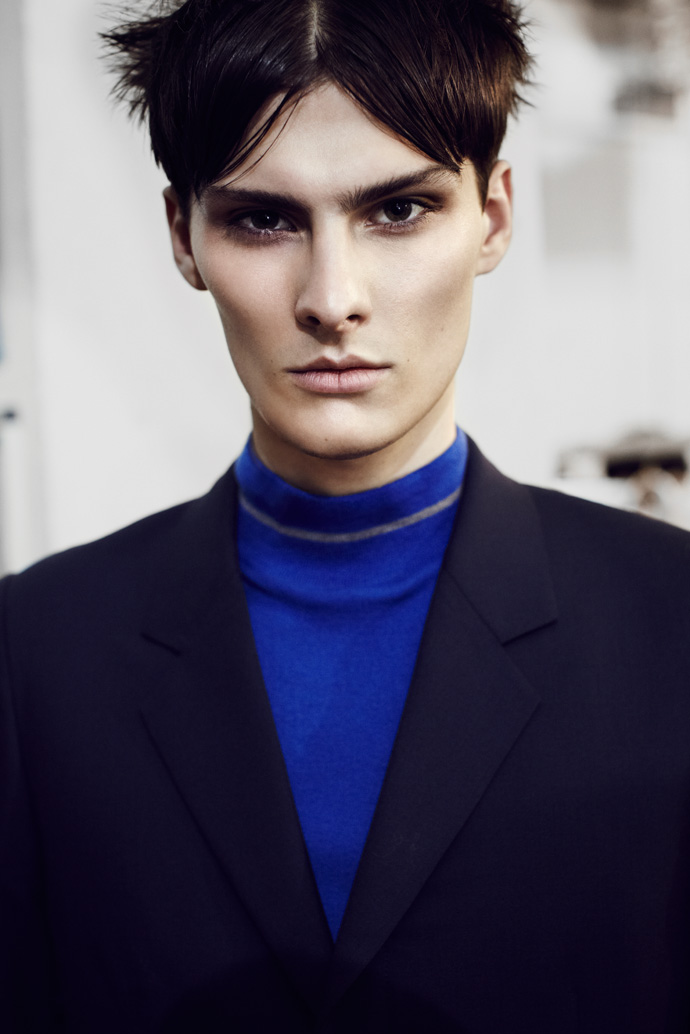
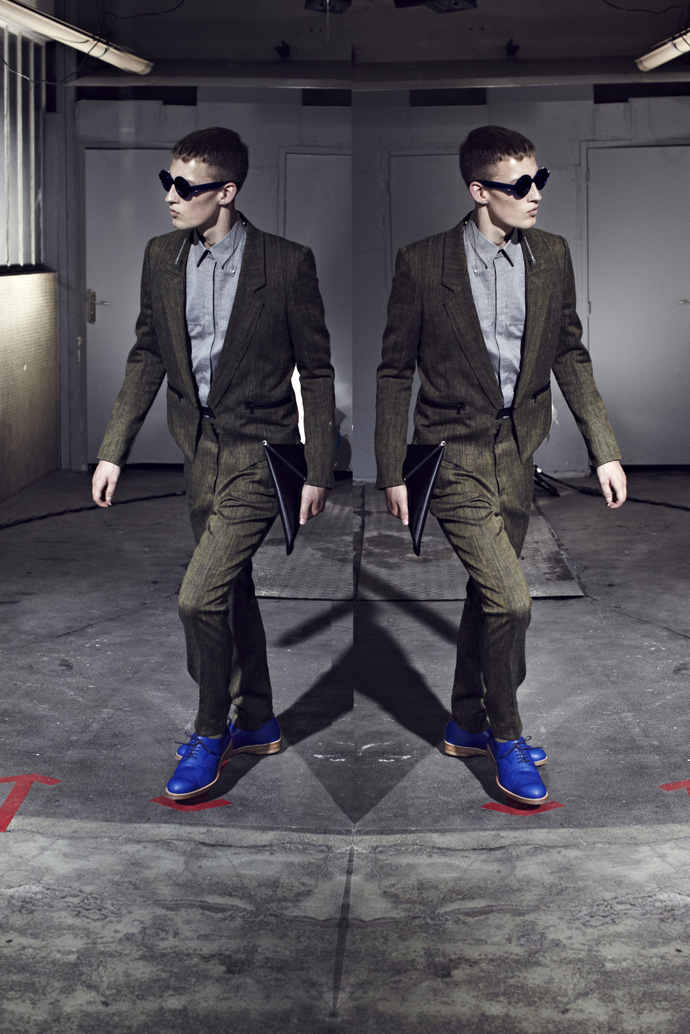 John Lawrence Sullivan's "Bauhaus" inspired collection, SS13. Photography by René Habermacher
John Lawrence Sullivan's "Bauhaus" inspired collection, SS13. Photography by René HabermacherRH: can you tell me more about “ELECTRIC AFRICA”: theme of the collection FW13/14, you just showed in Paris, what ideas are behind it?
AY: “Electric Africa” is a coined phrase. I had the idea to create a new, modern vision by combining tribal patterns associated directly with Africa with flashy colors instead of the standard earth tones. Tribal (triangular) elements were worked into various items and aspects like the cutting of the tailored jackets or the placement of the buttons. I also added a spacey essence reminiscent of the crop circles that suddenly appear in fields to the accessories, colors, and textures.RH: This collection also sports extraordinary footwear. Your sneakers have been hailed throughout. How did this design come together?
AY: I wanted create something akin to sneakers or trekking shoes, so I used Vibram soles. I also combined the base colors of the seasonwith highly contrasting hues in order to bring out a sense of Africa. I worked with a brand called ORPHIC when making the shoes.RH: Since you dropped your boxing for founding your label, fashion in Japan underwent quite some changes. How do you see the japanese approach today, what is your viewpoint and what influenced you over the course of time?
AY: When I started my brand in Tokyo my image was much more aggressive. I feel like back then many of the magazines adopted a fashionable approach, and that the buyers tried to answer the challenges the designers undertook with respect. But, as the economy got worse the magazines switched to much more easy to understand catalog-like appearance in order to make sales, which in turn influenced buyers, whose customers were influenced by this, to become much more conservative in their selections. So, there were a lot of negative things occurring in fashion here. The Tokyo runway shows were no different, as the focus shifted conspicuously to more “real” presentations rather shows with a bit a fantasy or elegance to them. Feeling all of this made me want to do my shows somewhere more stimulating, so I chose Paris.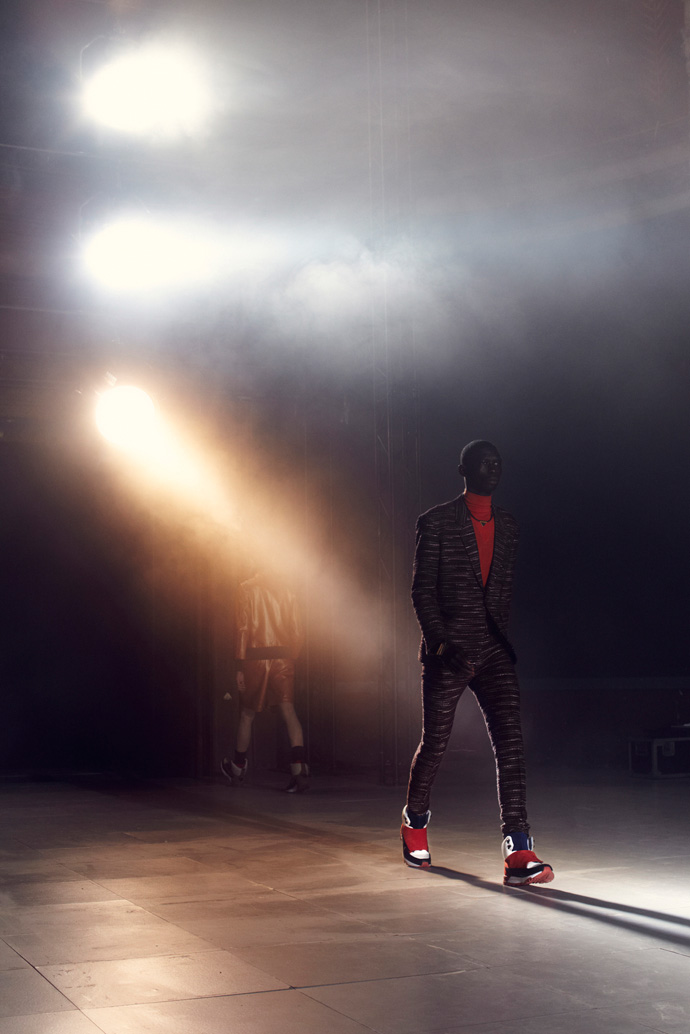
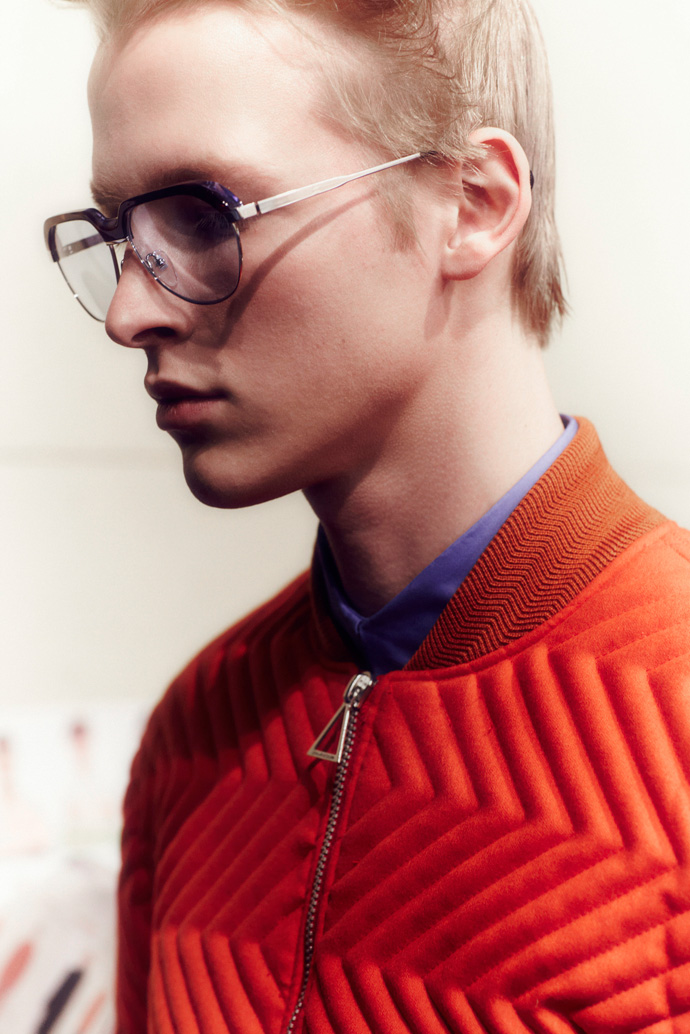 "Electric Africa", John Lawrence Sullivan FW13. Photography by René Habermacher
"Electric Africa", John Lawrence Sullivan FW13. Photography by René HabermacherRH: While developing your collection, are you having a specific type of man in the back of your head?
AY: I always imagine a man who possesses both beauty and strength in terms of appearance and mind. If I were to provide a sportsman as an example, there is a certain boxer who comes to mind…RH: Are there any parallels you can draw between your sports career and the one in fashion?
AY: One thing I realized when I first started working in fashion is that there is a common trait shared by boxing matches and fashion shows that only I seemed to notice. This was the way in which you worry over something that will last only few minutes on a single day for months in advance, battling with your anxieties and, as long as you don’t give up, preparing for the next match as soon as it’s all over regardless of whether you won or lost. The way everything seems so fleeting and transient once it’s all said and done is also the same.RH: The understanding of classic tailoring is a very strong element in your work. Now you started your women’s line: how does this apply here?
AY: Incorporating classic tailoring into women’s fashion is one of the most important elements for John Lawrence Sullivan. This isn’t something just any brand can do, so it’s something we will continue to actively working with in the future. One of the differences between men’s and women’s fashion for me was the way in which things like esthetic elements concealing points I had complexes about confused me a bit at first. Now I feel that I have learned to use men’s techniques to deal with these things.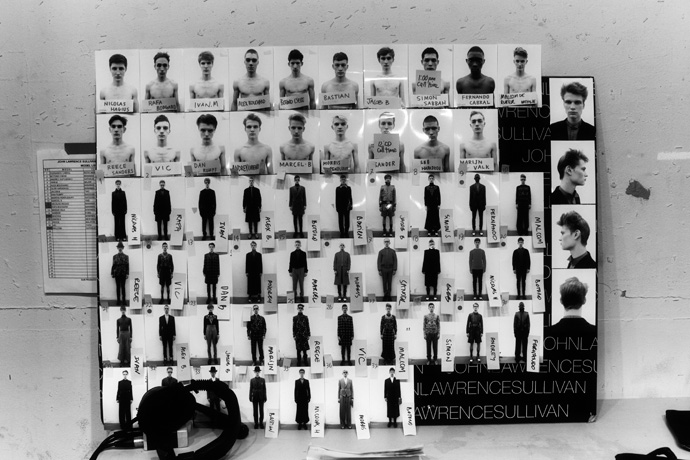 Showboard with looks and cast for "Electric Africa". Photography by René Habermacher
Showboard with looks and cast for "Electric Africa". Photography by René HabermacherRH: As you added another collection to your house – your work wheel must spin faster evidently, with 4 instead of 2 presentations.
AY: I always think of how I can break down the restrictions of the tailored look when I do my men’s designs. While there is the sense that I can be confident in breaking these restrictions down precisely because they exist, but with women’s my process is one of imposing my own restrictions on the things I design freely. So, there is a sense of mutual stimulation between my men’s and women’s lines that has been a good influence in my opinion. That said, I am definitely much busier than before…RH: Do you feel urged by the increasing numbers of pre-collections and cruise collections that the big houses lately launch?
AY: This is most likely just a sign of the conservative sales trends we’re seeing worldwide right now.The big houses are just doing this as a way of making sure they continue to pull in revenue. I too feel that JLS must do the same if we are to continue showing in Paris, so I’ll be considering various strategies for this in the days to come.RH: With clients all over the globe in different climate zones: do “season oriented” collections make still sense to you? (already the weather in Japan is quite different to the north american or european)
AY: Breaking things up by season allows designers to change up their mood and add depth to the presentation, so I most definitely think it has meaning. But, I also feel that in terms of actual sales it is often seasonless items that perform the best.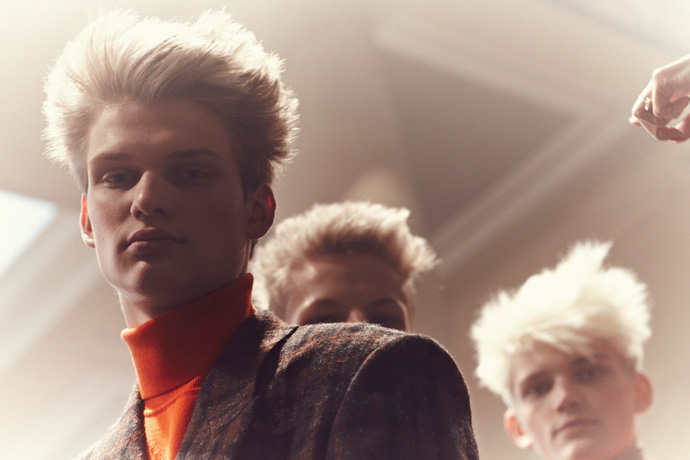 "Electric Africa", John Lawrence Sullivan FW13. Photography by René Habermacher
"Electric Africa", John Lawrence Sullivan FW13. Photography by René HabermacherRH: How do you perceive the present of fashion?
AY: I think what we are seeing is a mixture of various styles coming together.
This is also exactly why I feel that you can’t make it in this day and age unless you believe in yourself and keep making bold presentations. I guess you could say I feel we’re in an era where only the essentials survive. I want JLS to continue to be a brand that always takes up the challenge of presenting in Paris.RH: What is up next?
AY: The designs for my women’s exhibition in March and preparations for the 2014 S/S season.RH: What is the last thing you saw, read, heard or felt that stimulated you?
AY: Tadao Ando, James Turrell, Donald Judd, Taro Okamoto, Talking Heads, Pixies, David Bowie, Wes Anderson, Jim Jarmusch, Kinji FukasakuWebsite: John Lawrence Sullivan
-

The perfect muse: François Sagat
-In Carlo Collodi’s 1883 children’s novel “The Adventures of Pinocchio” it is the wooden puppet that possesses sentience prior to its transformation; it is the puppet and not its creator, the woodcarver who triggers the miracle of the doll coming alive.
With François one never knows who pulls the strings. It is him who invokes the sentiment for a story to become alive. Yet he hands himself over unconditionally to his collaborators, like an “instrument to be played”, as he likes to call it.
Film director Christopher Honoré once expressed that François Sagat “redefines the notion of masculinity”. François, the humble boy from Cognac has moulded himself to unattainable iconic status. Gilded with his blue inked crane, he is to conquer his righteous spot in the pantheon of pop culture…
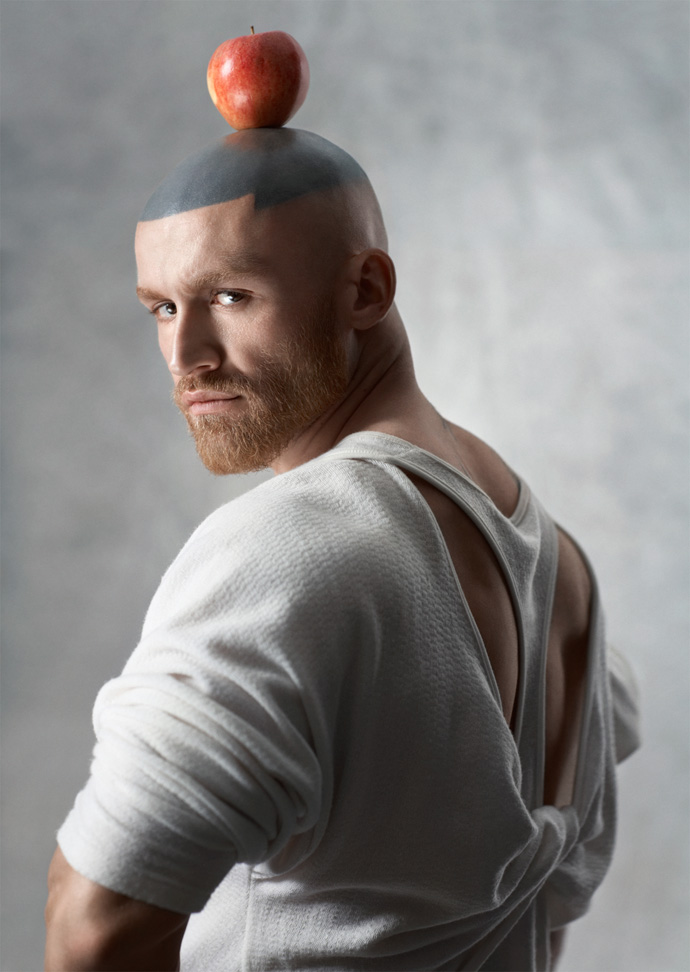 "François Sagat with Apple" Exhibition SPECTRE, Hyères 2010. Photography by René Habermacher
"François Sagat with Apple" Exhibition SPECTRE, Hyères 2010. Photography by René HabermacherRené Habermacher : you recently played alongside Chiara Mastroianni in HOMME AU BAIN by Christophe Honoré, and as well the lead in Bruce LaBruce L.A. ZOMBIE – how were your experiences?
François Sagat: L.A ZOMBIE was an experience which had very little to do with HOMME AU BAIN… The shoot for LA ZOMBIE was like a real porno shoot, scene by scene, it was mostly fucking, except that of course the porno version was censored for festivals…Beyond the sex scenes, LA ZOMBIE was a chaotic shoot, without a script, hasardous… but I’m still to this day satisfied with this participation and collaboration with Bruce LaBruce, from whom I still have much to learn, and who possesses a huge cinema and litterary culture… Despite what his critics say, I think Bruce has a real style.
During the shoot I really tested my capacity to resist “obstacles”, it was at times very difficult, I didn’t know where I was going, no direction, it was like being thrown in the lion’s den.
There was no script, the storytelling was weak and the whole plan was turned on its head by last minute changes and many cancelations, but that can be said about a lot of “cinema” projects.L'HOMME AU BAIN by Christophe Honoré, starring Chiara Mastroianni and François Sagat.
Regarding HOMME AU BAIN, the shooting was a lot more structured, but energetic nevertheless. It’s on this project that I realized that my abilities as an actor were limited, weak even, and felt like I was a big challenge for Christophe Honoré because of my “heavy” image, of the luggage I was carrying.
There were moments when I thought I terrified him, being everything except malleable. The project was constantly evolving due to the fact that we had planned it as a short, and that a lot of questions arose towards the end of shooting. It was finally released as a full feature film, and I have the feeling it wasn’t the right place for the film.It was an intimate project which to me, with hindsight, would have had a strong impact as a short. But I am neither director nor the creator of my own character. Rather than control the situation, I felt the blowback. But surely the imperfection of the final result makes it a real film, that can be remarked and criticized. I chose to shoot it and live the collaboration for the moment rather than think of the finished product.
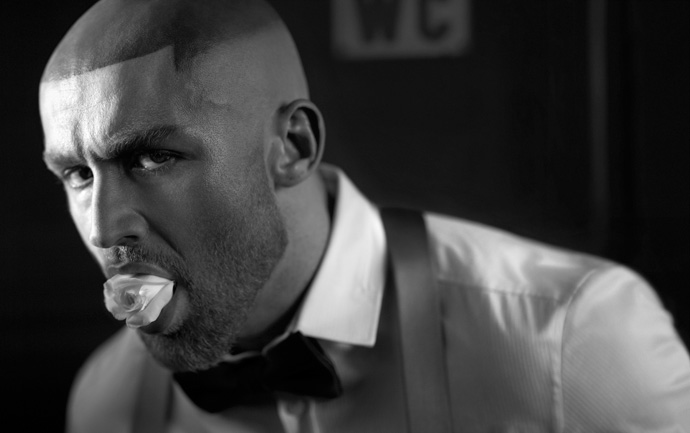 François Sagat for QVEST magazine. Photography by René Habermacher.
François Sagat for QVEST magazine. Photography by René Habermacher.What is the difference to you between acting in a porn movie or a feature film?
The difference ? Of course there are differences.
When you’re a porno actor, you’re in constant control of your carnal envelope and your physical aspect, whether you learn it or you have it from the start.
I didn’t know it as first but I am someone who has that ability. Porn is often an activity for people who are shy orally.
As a performer, you never really have to carry the more or less artistic responsabilities of a porn film, because there is no artistic issue to start with. You just have to be a good soldier fitting what the consumer desires to watch and what the production has decided, and that’s it.
I think also that I am someone who’s very sexual and exhibitiionist, but that’s not really giving you a scoop. Porn is like military service, it’s “my way or the highway”, and in my case, I’ve been and continue to be a good soldier.
The main difference is that you need a capacity to adapt and to lose who you really are, physically as well as morally. I created for myself a character in porn as in life, it’s difficult to let it go.
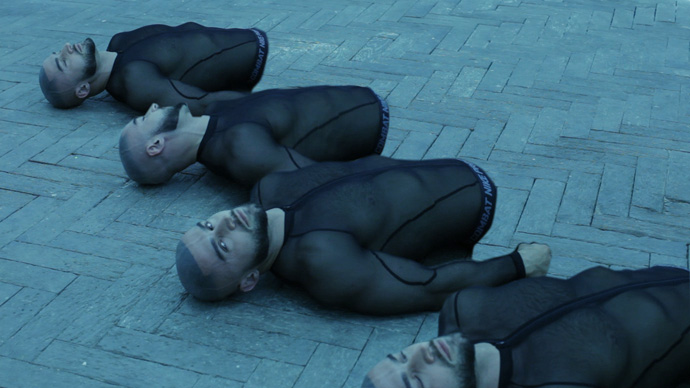 Video still from PILORI installation by Lynsey Peisinger & The Stimuleye. Villa Noailles, Hyères 2012.
Video still from PILORI installation by Lynsey Peisinger & The Stimuleye. Villa Noailles, Hyères 2012. -

HIGHER ATLAS – Marrakech Biennale
-The Arab Spring.One year later, the events seem so distant already, and yet an undeniable change has taken place in the atmosphere.
A special case: Marocco, where evolution, rather than revolution, is being encouraged through a revised constitution. And now, the Marrakech Biennale, HIGHER ATLAS, curated by Carson Chan and Nadim Samman under the patronage of Vanessa Bronson, opens its door.
A special case, a special place, in a special time… an interview with curator Carson Chan.
The Théatre Royal, under construction.
How was lunch?
Thanks for asking! There’s been little time for lunch these days, but the 6 dirham omelets across from one of exhibition sites, the Théâtre Royal, are great.Now that you spend so much time in Marrakech- what are your favorite places you hang out to get a fresh head?With my indispensable curatorial assistant, Marie Egger, we often duck away for an hour at the Cafe de la Poste, a beautiful colonial-era restaurant.
Did you accustom to the local rhythm?It took a few weeks, but I think I finally got a hang of how to deal with contractors, suppliers, interns, accountants and bureaucracy in Marrakech. This time around, I’ve been here for more than a month, and it’s been great to become familiar with some of the people in my neighbourhood. That being said, I’m still often my own tourist attraction!
So did you surrender? Or is it the other way around?I think everyone involved has surrendered to the biennial making process. I knew that logistics would be a challenge, but in the end, the exhibition, often spectacular, sometimes very quiet, was curated to appeal first and foremost to the senses.
How did your engagement with the Marrakech biennale and Nadim Samman come together?We were invited December 2010. I ended up meeting Vanessa Branson, the president of the Arts in Marrakech foundation at Art Basel Miami, and was hired after a brief presentation of my past exhibitions on my ipad! She had met Nadim a month earlier in London at an exhibition he made there.
You had initially planned the El Badi palace to be at the core of the Higher Atlas biennale. As I understand one of the challenges you faced with the change of administration was that at some point El Badi was no longer available. What were the consequences?The consequences of losing the El Badi palace was pretty great in the end! The show now spans five different sites in and around Marrakech, so when traveling from one location to another, visitors, both local and from abroad, will begin to see the city as part of the context of the exhibition.
The Théâtre Royal, a half completed opera house commissioned by King Hassan II, the old foundations and underground cisterns of the sacred Koutoubia Mosque, the so-called Cyber Park (it’s owned by Moroc Telecom and has perhaps the best wifi in the city!), the Bank al-Maghrib building in the historic Djemaa el-Fna square as well as an large scale sculptural installation by Elin Hansdottir in the town of Tassoultante about 15km outside of the city are all places where we have exhibitions.
Particularly in the urban public spaces like the square, the park and Koutoubia, it has been amazing to see visitors that have had very little exposure to contemporary art stay and take time to experience the work.
Installation by Ethan Hayes-Chute.
Did the “arab spring” affect you curating this project?The so-called Arab Spring (no one here would ever associate any kind of political unrest as a problem relating to other countries…) was definitely on my mind when I started conceptualizing the exhibition. Before spending time at in Marrakech, all I knew of Morocco was what I read about in the media – a politics biased reading if anything. The very fact that we made an exhibition of contemporary culture was a response to politic-heavy understanding of North Africa.
People here go shopping, go to restaurants, read books, watch movies and use the internet for YouTube just like everywhere else.
One of the biennales goals are articulating the blurred boundaries between historically discrete spheres, and the conjunction of local and global conditions. Which works would you allocate to this specific target, and how do you see their relevance?I would say Jon Nash’s work, Moroccan Drift, is a good example. When he was researching Morocco online, he came across several drift videos in which people would speed up their cars and turn in such a way that the car moves sideways. Inspired by Tokyo drift and other videos from around the world, young Moroccans made their own Moroccan drift videos.
In the end, it was the space opened up by the Internet, not, say, geo-politics, that shaped the cultural lives of the Moroccans making these videos. Morocco is used by filmmakers as stand-ins for several other places. Ridley Scott shot Prince of Persia here, and of course Morocco is no where near Persia. Large HDI balloons are often used as stand ins for the moon, and American artist, Karthik Pandian, decided to launch one of them in the Djemaa el-Fna square for one night. On that night, March 2nd, Marrakech had two moons, the real one, and the one Karthik launched, which was cubic in shape – a gigantic white cube, as it were.
Was it difficult for you to get rid of the post-colonial shades and orientalist romanticism?Post-colonialism and its echos are definitely here, but not unlike other cities like Hong Kong, Montreal or Mexico City. We worked with about 50 university students from the Cadi Ayyad University, and they definitely regard themselves as either Moroccan or simply world citizens, not products of post-colonialism. In fact, I consciously tried to bypass this framework by foregrounding art as a question of physical experience, rather than a communicator of historical conditions. Having said that, Leung Chi Wo, from Hong Kong, reflected on post-colonial identities in his work.
Right, Carson Chan, co-curator, and left, Vanessa Bronson, biennale founder.
I am curious to hear a little on the locals reactions in this context?The local reaction so far has been amazing! If anything, it has really gotten people talking. Thousands came to our opening, and we are being featured in the local media – radio, television, newspaper, magazines – on a daily basis. Our interns, who have worked for the past two months alongside myself and our artists, are our main ambassadors. They tell people on the street, friends, make their own ads and posters about the show.
I went to check up on the Koutoubia exhibition the other days and it was packed with people streaming in from the main square. At the Bank al-Maghrib, where Nine Eglantine Yamamoto-Masson curated video art as part of a walk-in screening room, I saw families sitting inside entranced by the videos.
How did you encounter the local support when approaching it?Not only do we have support from the mayor, the Wali of Marrakech and just recently the patronage of the King himself, the love and support we get from our contractors and workers has been immense. One contractor, Said Aakif, has been instrumental to the success of the biennale, and we’re all really grateful for his dedication.You recently halted your project PROGRAM in Berlin, what was the decision? And, in retrospect how do you see this curatorial experience has affected you?
Fotini Lazaridou-Hatzigoga and I ran PROGRAM for more than 5 years, and as a project that experimented in art and architecture exhibitions, we felt that we had had our run.There will definitely be more projects through PROGRAM, but the experience there has definitely shaped my work here in Marrakech. To start with, many of the artists I’ve shown there were also in the biennale.What are your plans after the Marrakech Biennale?I’m editing two magazines – editor at large for 032c, and contributing editor for Kaleidoscope – so that will take up much time. There are a few more exhibitions this year, talks and lectures, but I’m taking time to work on a conference at Yale University with David Tasman and Eeva Liisa Pelkonen about architecture exhibitions. There are a few books up my sleeve as well…
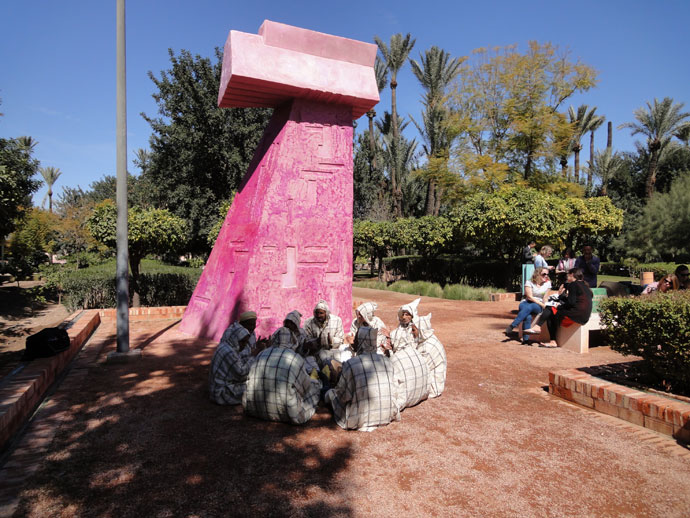 Aleksandra Domanovic's "Monument to Revolution" and the al-Ghiwane singers,
performing turner-prize nominee Roger Hiorn's untitled performance.
Aleksandra Domanovic's "Monument to Revolution" and the al-Ghiwane singers,
performing turner-prize nominee Roger Hiorn's untitled performance.
What is the last thing that stimulated you?
The most stimulating thing was the exhibition vernissage. To see people experiencing the artworks I spent so much time thinking about and considering, to see them take it in and take their time, to see people encounter things they may never have encountered before, that has been the most stimulating. -

An artist should not make himself into an idol
-Marina Abramović is everywhere lately.
A marathon performance at MoMa, another retrospective in Moscow, on the cover of POP magazine, hosting a star studded event at Jeffrey Deitch’s MOCA in LA and an exhibition at The Serpentine Gallery slated for 2012, the HBO documentary “The Artist is Present” just screened at Sundance. An ever growing list of projects that is taking her across continents…
Exclusive long form of interview first published in POP magazine FW2012
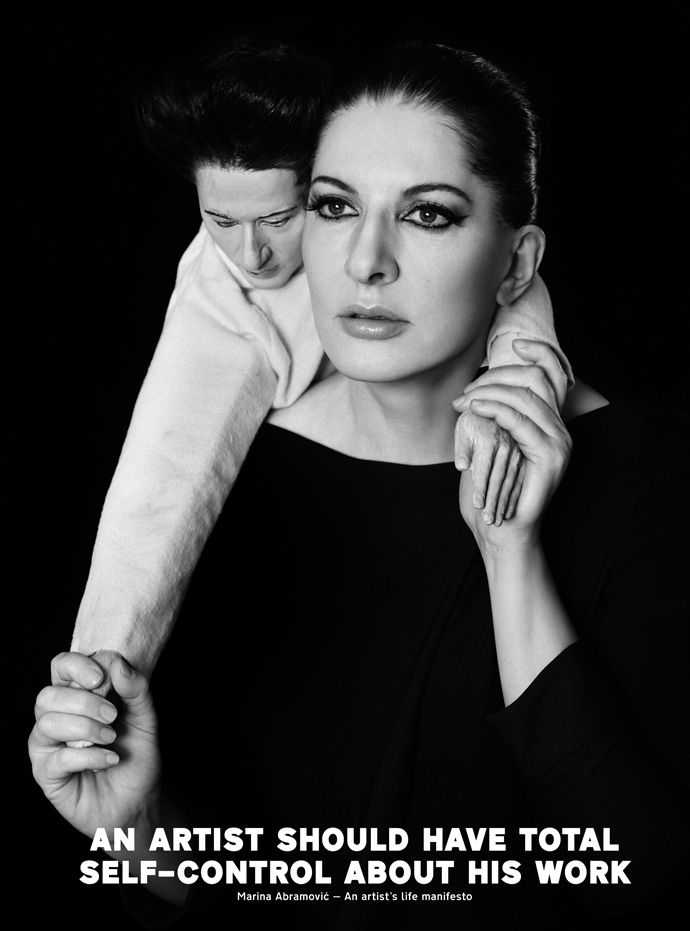 Marina Abramović with her "Mini Me". Photography by René Habermacher for POP magazine
Marina Abramović with her "Mini Me". Photography by René Habermacher for POP magazine
Marina Abramović is everywhere lately. She has emerged from what was considered an alternative section of contemporary art, Performance Art, to finally occupy an untouchable position in the Pantheon of Pop.
A marathon performance at the MoMa, another retrospective in Moscow scheduled, and an exhibition at The Serpentine Gallery slated for 2012, day and night filming of an HBO documentary and an ever growing list of projects. Marina is known for her works in which she tests and pushes her emotional,mental and physical strength, but her schedule takes its toll: Marina is exhausted.
Broad recognition has come comparably late for Abramović, who was often categorized as some sort of Exotic Serbian Vixen. Nevertheless, she has shaped a significant slice of art history like no other.
Today, less considered for her public sexual identity, and more appreciated for her timelessness and her bravery, one could unarguably call Marina “the diva of contemporary art”, were she not so grounded.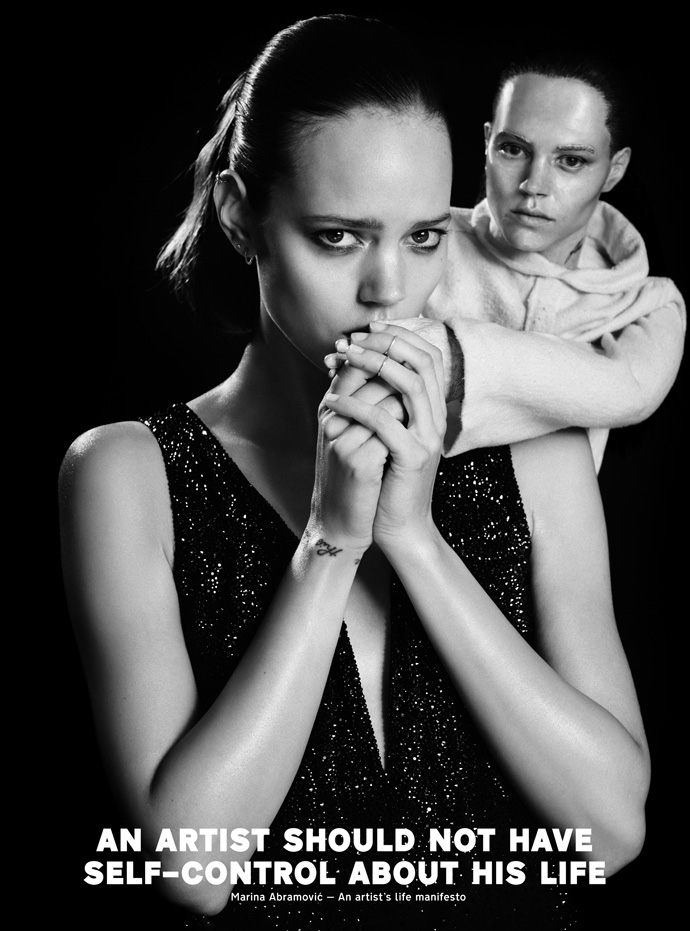 Freja Beha Erichsen with her "Mini Me". A collaboration by Marina Abramović for POP magazine
Photography by René Habermacher
Freja Beha Erichsen with her "Mini Me". A collaboration by Marina Abramović for POP magazine
Photography by René HabermacherOur conversation takes place just after Marina’s return to New York from Manchester, England where she spent six weeks collaborating with Robert Wilson on a new biography, “The Life and Death of Marina Abramović”. The play was staged with accompanied music written and conducted by Antony (of Antony and the Johnsons) and narrated by a ferocious Willem Dafoe.
The audience witnessed him meticulously rummaging through the details of her life chronologically. Marina has been clear about her lack of appreciation for theatre as a concept and this play marks a sharp departure from her concept of herself as a performance artist.She participates in what she used to essentially despise: “To be a performance artist, you have to hate theatre. Theatre is fake: there is a black box, you pay for a ticket, and you sit in the dark and see somebody playing somebody else’s life. The knife is not real, the blood is not real, and the emotions are not real. Performance is just the opposite: the knife is real, the blood is real, and the emotions are real. It’s a very different concept. It’s about true reality.”
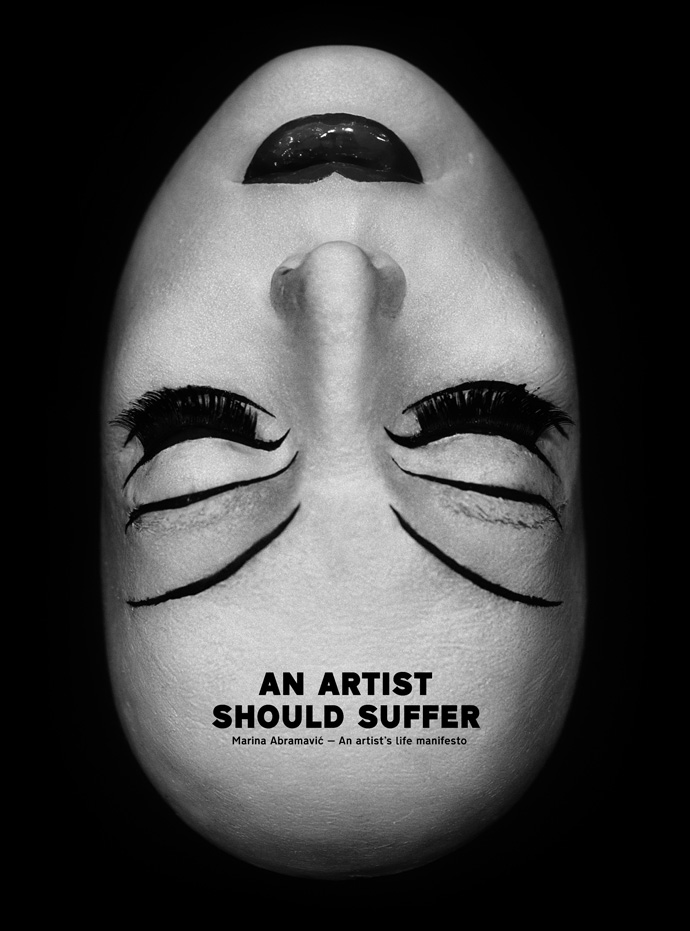 Death mask of Marina Abramović. Photography by René Habermacher
Death mask of Marina Abramović. Photography by René HabermacherRené Habermacher: With this piece you staged something that you call artificial theatre. It lacks the realness that is central to your work. How was this experience for you?
Marina Abramović: I am his material. I completely gave all the control to Bob (Robert Wilson). That is the only way to really be material for someone else, which is very interesting, because its just absolutely the opposite of what I do. This is first time that i have this really radical approach with Bob – he absolutely refused anything to do with performance. This was an amazing experience for me and very difficult, because his approach to rehearsal is like mine to performance, – but yet it’s just rehearsal! Just be there for hours and hours in order for him to fix the light. I lose my reason, I need the public, I need another kind of dialogue. This was a huge discipline not to kill him!
RH: How did this project with Bob come together? (more…)
-

new greek cinema: of WASTED YOUTH and “an old whore in need of love”
-These days we hear mostly troubling news from a country to which its citizens proudly refer to as “the birthplace of democracy”: Greece. Another spiral of economic turmoil unfolding in slow motion casts a spell upon Europe. And yet accelerated by the recent events, a very different wave reaches us from this troubled country: “The weird wave of Greek Cinema” as The Guardian’s Steve Rose titles. The Stimuleye talks to WASTED YOUTHS director Argyris Papadimitropoulos.
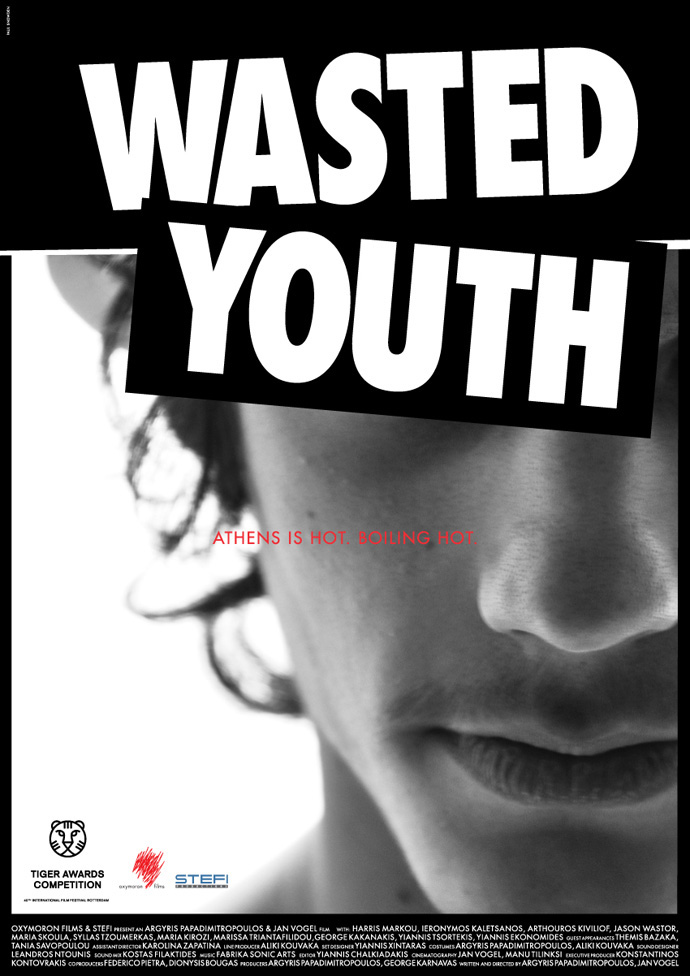 Poster for WASTED YOUTH
Poster for WASTED YOUTHIt’s the late days of summer 2011. A handful of Athenians, foreigners and expats mingle on Antiparos, a small island in the wide open of the blue Aegean. Athens is far and its troublesome agenda on a halt.
As the night falls scenting the breeze with jasmine, the open air cinema Oliaros, a local institution, announces tonight’s screening with notices on poles and walls: WASTED YOUTH, the film that earlier this year had opened Rotterdams Film Festival. The film’s director, Argyris Papadimitropoulos, hands stickers to the arriving guests: WASTED, MALAKA (wanker), YOUTH, LOVE….The film is set during a hot summer day in Athens. Much like the city itself, exhausted, confused, unable to make any progress, brimming with desperation and aggression, there is Vasilis, a middle-aged man struggling with the mounting stress to cater his family. On the other side Harry, a sixteen-year-old skater. He and his friends are amusing themselves and wasting time away. Their lives intersect in a contemporary portrait of the city of Athens and a society in crisis.
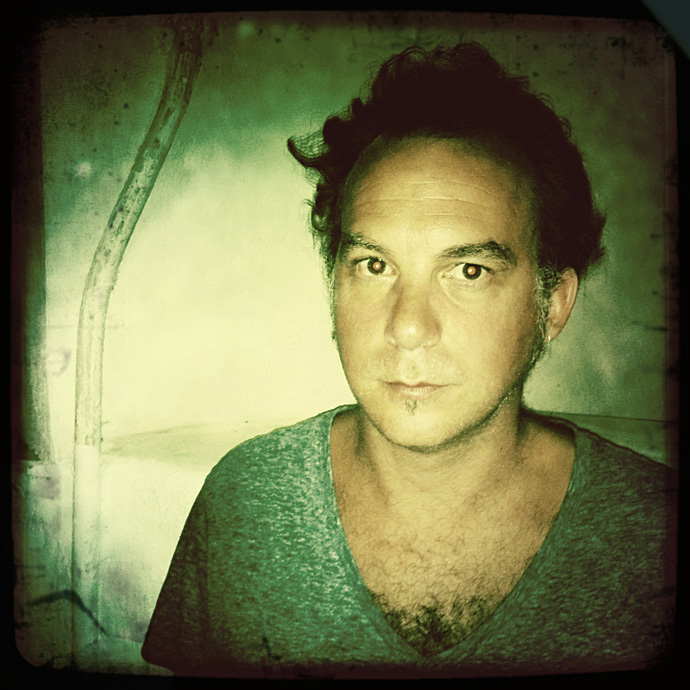
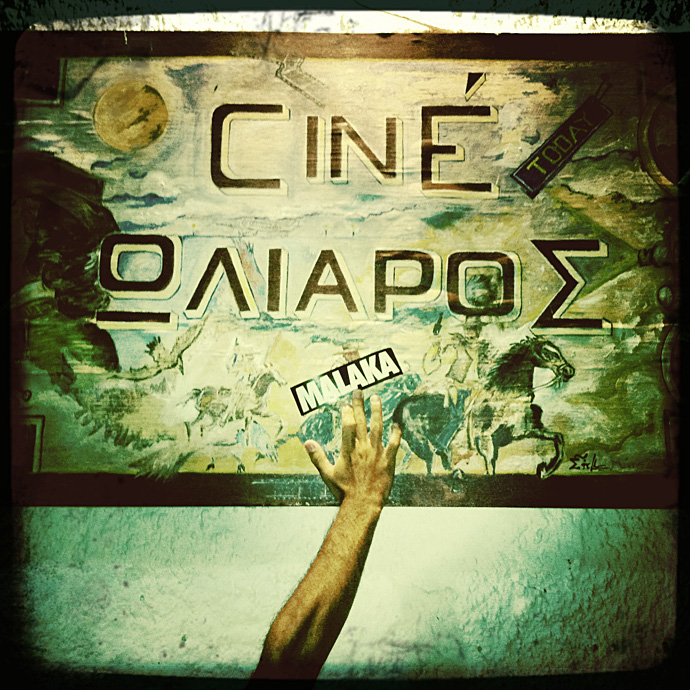 Left: director Argyris Papadimitropoulos at Antiparos and right: Poster of cinema Oliaros with MALAKA sticker
Left: director Argyris Papadimitropoulos at Antiparos and right: Poster of cinema Oliaros with MALAKA stickerRENÉ HABERMACHER: How did that screening at the open air cinema come together?
ARGYRIS PAPADIMITROPOULOS: I am a regular there so I know the guys of Oliaros cinema since… forever. They asked me to do a screening and although I was not allowed to do so by my distributors – In Greece films are supposed to have two runs since we have this open air cinema tradition still alive and very popular – I couldn’t say no. I just love this tiny cinema, and the fact that it is free for everybody to watch the films. There are Greek islands much bigger in population who do not have a cinema and that’s sad.
There’s such a huge part of me and my adolescence in WASTED YOUTH that in every screening I still feel kind of weird… weird in a good way. Since I re-lived my teenage years by shooting this film I feel so exposed. It’s strange telling unknown people so many things about myself. But that’s the magic of it, isn’t it?
WASTED YOUTH had its world premiere in Rotterdam Film Festival in January 2011 and was also honoured to be the opening film. Since then it was screened in more than 30 festivals around the world. In some of the best actually. It was a great year, I spent much of it traveling and presenting the film.
We signed with Elephant Eye Films in New York to represent WASTED YOUTH for world sales. For such a tiny budget film I can loudly say: we did great.Trailer of WASTED YOUTH
R: How was the film generally received by the international audience?
A: I’m more than happy with the comments audience and critics wrote about it.
Screen International described it as “lush, evocative and impressively shot” (laughs).By its career you can tell that the film was received excellent. The audience loved it and the few that hated it, were the ones that gave me the chance to talk, start a discussion, which back in the beginning was the main intention for the film.
I was with my friend and co-author Jan Vogel and we were saying that we need to make a film about these crazy days we are going through and that we need to do it NOW. Some films are made with a sense of urgency. We actually didn’t spent any time writing scripts or searching for funding, but found our amateur teen guys and a couple of good actors and started improvising on a few pages, something like a synopsis. WASTED YOUTH was privately funded by friends and is what you would call 100% indie.R: So it was pretty much a “hit and run”?
A: It was a hit and run urban guerilla thing but shot on film (!), not digital.
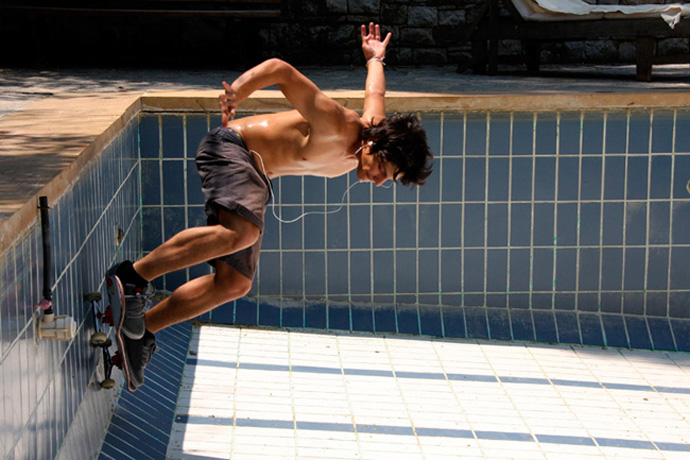 Over the edge: Still from the movie WASTED YOUTH: Harry (Harris Markou) skates in the empty pool of his parents friend.
Over the edge: Still from the movie WASTED YOUTH: Harry (Harris Markou) skates in the empty pool of his parents friend.R: I really liked the scene in the very beginning when the boy wakes up in the morning, somewhere in this modernist building…. that whole sequence to the skating in the empty pool felt really strong… like frozen time.
A: That was our intention. We wanted to go through all the different people, classes etc in the modern greek society.
So the kid wakes up in a house of a lady with what we call “old money” and starts his day under the surface of the earth.
We wanted to have our little symbolisms without making a mind-fuck film.
There a second levels, second readings etc but only for those who want to read them.
I hate the films that are so personal that you will not get them unless you are the person itself (laughs).
I love stories.
I hate smart ass films.R: In my eyes your film looked very authentic- which is quite difficult to achieve.
A: Glad to hear! That was what we wanted to do: a spontaneous film!
R: In a way it also gives a beautiful portrait of the city. How do you like Athens?
A: I love Athens. It’s the place that i was born and I know it as the back of my hand. Athens is a character itself in the film. Its chaotic , crazy and sadly neglected.
It’s the old whore that people love to hate but they love paying a visit. Athens needs a bit of love from the people that fuck her everyday.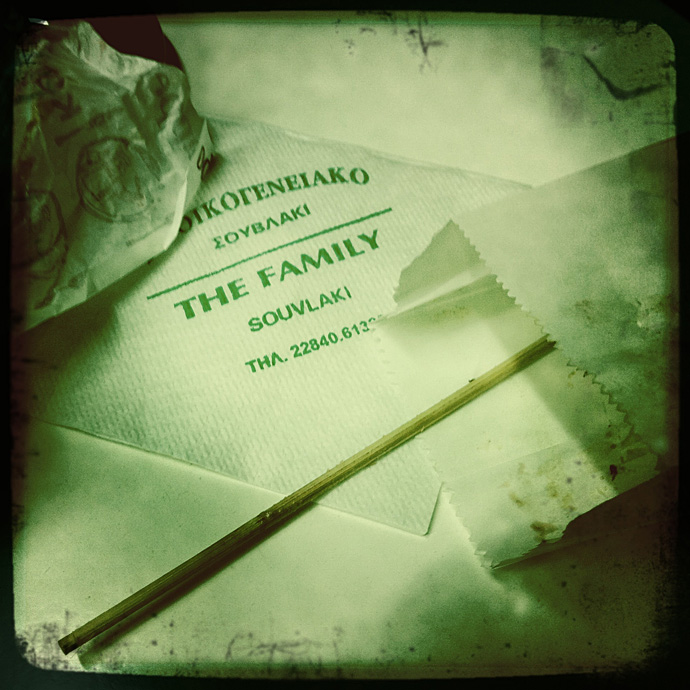
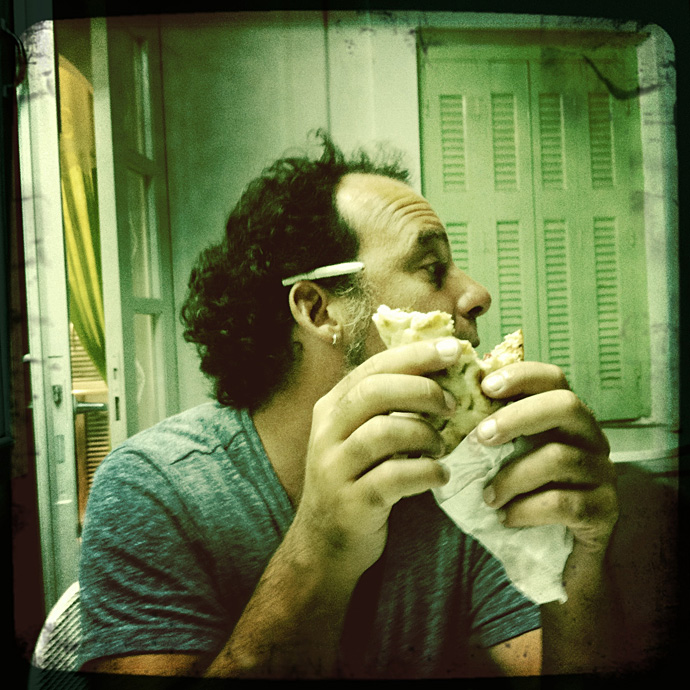 Argyris getting down with more from the spit
Argyris getting down with more from the spitSPOILER ALERT(for the affectionate reader who has not seen the film yet, please skip this part)
R: I was quite surprised at the end when the final “shot” was triggered by the other police man
A: by that I wanted to say that anybody would have done it.
I wouldn’t like the audience to leave the screening and feel sorry about a killer,
since the cops carry guns one day they will trigger them.R: Thats why you left him blank? as a character
A: True, if by blank you mean what I mean.
END SPOILER ALERT
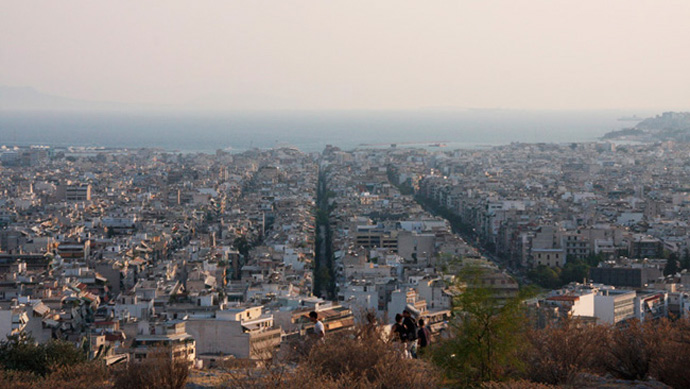 Still from WASTED YOUTH: Athens
Still from WASTED YOUTH: AthensR: The Guardian wrote an article on what they call the “weird wave of Greek cinema”…
A: the fact that the Guardian ran a huge piece on Greek films is already impressive.
A few years back they wouldn’t spend ink on this. That means that there’s something great being born here. I wouldn’t call it a wave and wouldn’t rush to give it names but you can smell something good is going on. There’s no surprise anymore when you see a Greek film in the list of a great festival.
Berlin, Rotterdam, Cannes, Locarno, Venice, Sundance, you name it.
Critisism is there and will always be, there are some people that are sceptical about whatever new is going on and others that want to kill it before it even gets born.
People are not ready for changes, you know.It seems like when societies are on the edge, edgy things come out of their arts. Remember Argentina, Romania and so on.
What was happening in Greece the last 25 years, let’s say from the early 80’s till the olympics was a fake paradise:
a fake prosperity with fake money, fake happyness, fake tits, fake, fake, fake …A fake new identity that never made it to the core of neither our souls nor our society – it collapsed in a few days.
One day they told people we are in crisis and people believed it the same day, so there were no solid foundations in this “new order” that was fakely established.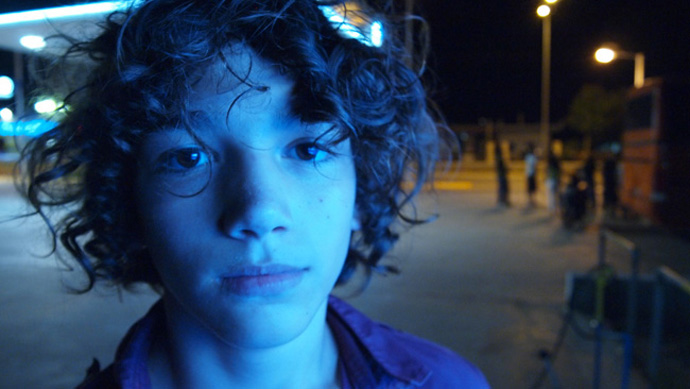 Still from WASTED YOUTH
Still from WASTED YOUTHR: To come back to one of the most interesting things about the article of the Guardian, it were the comments by fellow Greeks being often malevolent, accusing the directors of plagiarism in the case of Dogtooth, or calling the films “a product of mental health problems”.
A: hahaha! that’s great fun.
People cannot accept themselves. When somebody puts a mirror in front of them they can’t cope.
A product of “mental health problems” is the society we use to live in, so are the films as they are suppose to reflect the society.
As for the plagiarism: I would just say that there were very few people saying so, but they created a huge buzz. These people are the ones that do not like the success of someone else because they are stuck in their thing.The greatest festivals in the world are not stupid to have a work of plagiarism in their catalogue.
Also, plagiarism in art is a huge topic that it is almost impossible to discuss: almost every great artist was accused of that!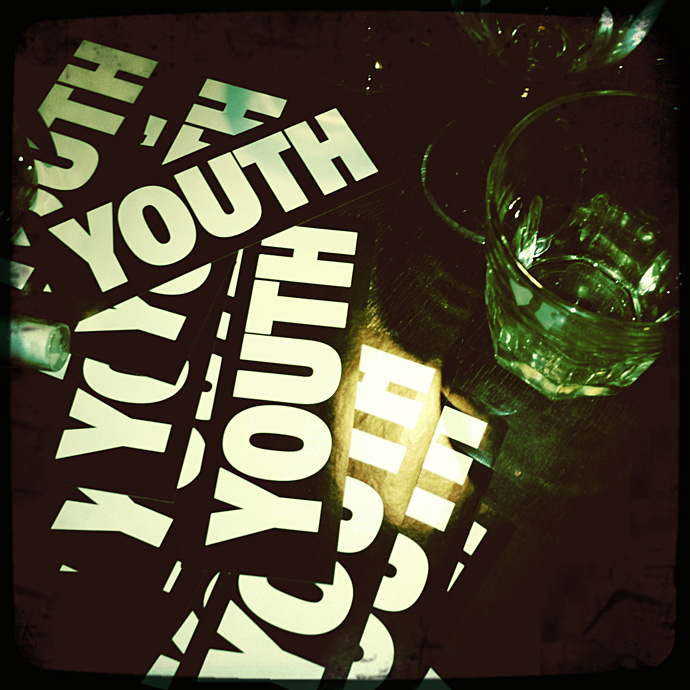
 Argyris at his favorite souvlaki place in Antiparos.
Argyris at his favorite souvlaki place in Antiparos.R: I thought this was a very typical reaction. In a recent article for Vanity Fair Michael Lewis puts it like that:
Individual Greeks are delightful: funny, warm, smart, and good company. I left two dozen interviews saying to myself, “What great people!” They do not share the sentiment about one another: the hardest thing to do in Greece is to get one Greek to compliment another behind his back. No success of any kind is regarded without suspicion.A: I wouldn’t agree. If you look at the end credit of all this films that made it to the great festivals the last few years, you will realise that everybody helped on each others work. Greeks are easy target to be accused for almost anything since we have this fucked up temper. But on the other hand you can tell that there is still solidarity and support between most of my fellow greek film makers for example.
R: What are you working on next?
A: I write a couple of scripts with friends. Things are hard these days but we’ll keep trying.
I would like every film I make to be so much different from the other. I would also love to make a film abroad, although I love Athens.
Paris, London, Berlin, New York, Rio, Buenos Aires – there are stories everywhere that i would love to tell…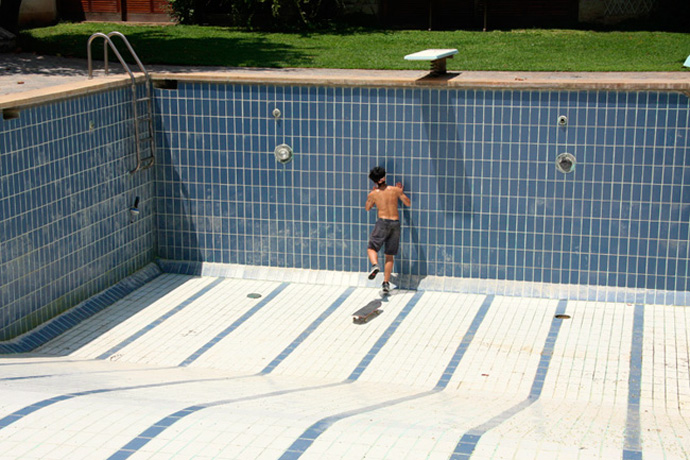 Still from the movie WASTED YOUTH: Harry (Harris Markou)
Still from the movie WASTED YOUTH: Harry (Harris Markou) -

HYÈRES is TOMORROW: RAF SIMONS
-“I do think the main thing when you start with what you want to do, is to find an audience.
And to find an audience, the main thing is to start up a dialogue with them and to find out what they want.”
Raf Simons speaks with The Stimuleye on Hyères. Contestants get ready for the next edition, register before 26th of November, and send your entry before the 5th of December!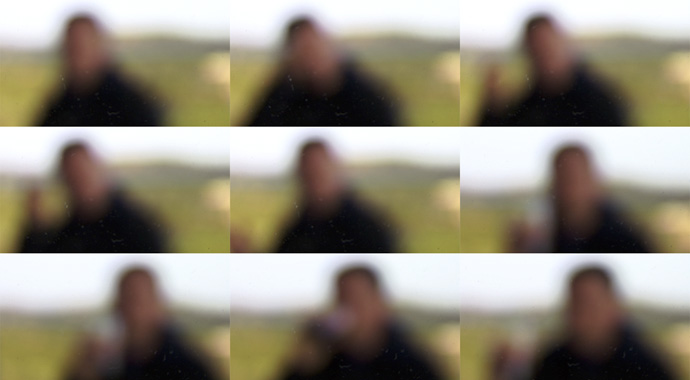 Mister Raf Simons likes it sharp but prefers his pictures in blur. Sequence by Antoine AsserafRAF SIMONS: With my exhibition at the villa, I wanted to show the form of extremity that can be the start of something and still be successful.
Mister Raf Simons likes it sharp but prefers his pictures in blur. Sequence by Antoine AsserafRAF SIMONS: With my exhibition at the villa, I wanted to show the form of extremity that can be the start of something and still be successful.To me it’s really important for the generation who enters into this context to realise what kind of platform this is. I think it’s enormous. The amount of press that is there and the staging of the garments on a super high level.
We selected 10 contestants out of 50 (of initially 800 entries), together with Christopher Kane, Michel Gaubert, Maida Boina and Jean Pierre Blanc.It was not easy. We had for each entry one single silhouette, which is complicated to judge with the dossier that is “flat” and has yet to be developed.I did see there were people who were working on their collection, from the moment they were chosen to the moment it went on stage, and there were people who did not. That showed also in the final result: the ones who had been working on, got better.
It was quite a discussion within the jury. We were not unanimous about the winner. There were mainly two, but there was clearly already a third person [Emilie Meldem] that all members of the jury found interesting to mention, so we had to decide to vote, which is also the honest way I think. when you start discussing like “yeah maybe less people like that and more like the the other, but let’s still make the winner the one that less people like”- I think that is not correct.Hyères Alive - Award Ceremonies
“Refined sensibility” – I think the winner [Léa Peckre] stood out for that at the end.
The second price [Céline Meteil] won for its purity. In relation to lots of other things the jury members thought that one was attracting because of the purity and of its honesty: to take one thing and kind of concentrate on that. One material, one process, one kind of shape. But it worked. It had something quite controlled at the same time something not too forced, not trying to be too special. Because we had quite some people who tried to be really special and it also went wrong. -

marc turlan: STAR NOTORIOUS
-First, he covered them up with a resin mask, then he cut their eyes out, with a scalpel and after with a laser. This is not Dexter, this is artist Marc Turlan, who always finds new ways of torturing magazines.With his latest solo show EXO STAR he is taking an artistic leap, opening this saturday at Galerie Anne de Villepoix in Paris.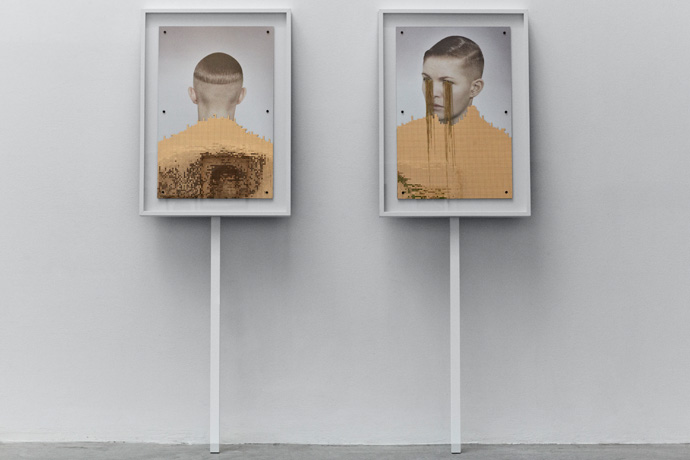 Marc Turlan: protest board 1 and 2, a collaboration with british photographer Timur Celikdag.
Courtesy gal Anne de VillepoixThe new sculptures of Marc Turlan conclude a logical extension of his appropriative work with the pages of glossy magazines:“The base of all i do is collage. The technique for my sculpture is the same way, it’s like 3 dimensional collages.”Right in the first room, the program for the exhibit gets clear: a gym workbench, weight bars in a stack, and 6 sheets of mirror, each with a word inscription of mirror mosaic, that serve as the commandments for this show: WORK – NOTORIETY – SINCERITY – POWER – LOVE
Marc Turlan: protest board 1 and 2, a collaboration with british photographer Timur Celikdag.
Courtesy gal Anne de VillepoixThe new sculptures of Marc Turlan conclude a logical extension of his appropriative work with the pages of glossy magazines:“The base of all i do is collage. The technique for my sculpture is the same way, it’s like 3 dimensional collages.”Right in the first room, the program for the exhibit gets clear: a gym workbench, weight bars in a stack, and 6 sheets of mirror, each with a word inscription of mirror mosaic, that serve as the commandments for this show: WORK – NOTORIETY – SINCERITY – POWER – LOVE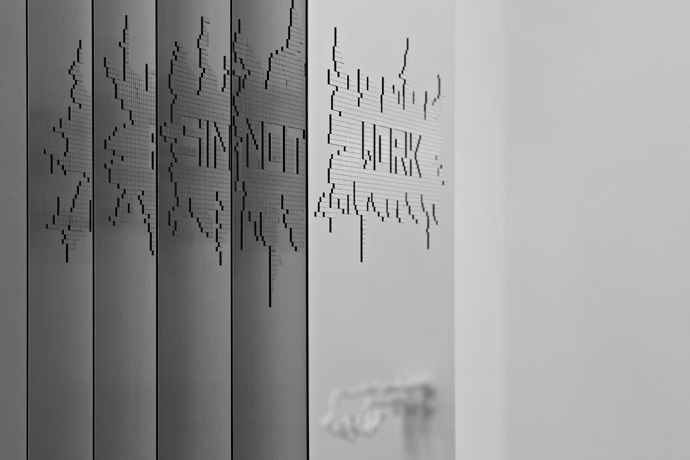 Marc Turlan: Statement Carpets. Courtesy gal Anne de Villepoix“It’s about the body. it’s erotic. Its a fetish to have in your mind to transform your body, to make a new image of yourself” he explains, next to two sculptures that look like snaffle headpieces with star shaped marble weights hanging from its leather thongs. It is inspired by gym gear to work your trapezius muscle. The materials surrounding us – leather, marble, mirror, wood. Marc Turlans recurrent structural elements are evident: eroticism, vanity, fetishism and notoriety.
Marc Turlan: Statement Carpets. Courtesy gal Anne de Villepoix“It’s about the body. it’s erotic. Its a fetish to have in your mind to transform your body, to make a new image of yourself” he explains, next to two sculptures that look like snaffle headpieces with star shaped marble weights hanging from its leather thongs. It is inspired by gym gear to work your trapezius muscle. The materials surrounding us – leather, marble, mirror, wood. Marc Turlans recurrent structural elements are evident: eroticism, vanity, fetishism and notoriety.Left: Marc Turlan's "Star Rack", and right: the artist himself
And there is of course, the star: “The star is the representation of the absolute, its a simple symbol for everyone. This desire, or fantasy to be recognised, to be famous, to arrive at this point… I use the star in marble.”In Marc Turlans “gym” you actually work out with the star as a marble weight, stemming the symbol of the desired recognition and thus transform yourself through and towards that idea.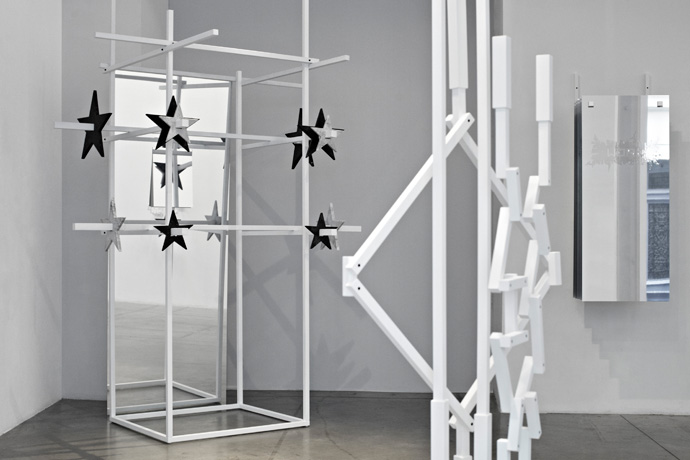 The first room of EXO STAR with "Home Star-Gym". Courtesy Gallery Anne de VillepoixThe second room is pitch black and only lit by pulsating light bulbs on a cluster of stars, an array of audio sculptures speak to the visitor with each a “collage sonore” (sound collage). Corresponding to the acoustic rework of a writers text hangs a framed object, containing a book of the same author with a mirror mosaic highlighting a sentence.“I keep a sentence very different to the audio collage. It is a proposition, an open invitation. I don’t work in an interactive way. I am interested in the object. It becomes a sculpture” he explains.
The first room of EXO STAR with "Home Star-Gym". Courtesy Gallery Anne de VillepoixThe second room is pitch black and only lit by pulsating light bulbs on a cluster of stars, an array of audio sculptures speak to the visitor with each a “collage sonore” (sound collage). Corresponding to the acoustic rework of a writers text hangs a framed object, containing a book of the same author with a mirror mosaic highlighting a sentence.“I keep a sentence very different to the audio collage. It is a proposition, an open invitation. I don’t work in an interactive way. I am interested in the object. It becomes a sculpture” he explains.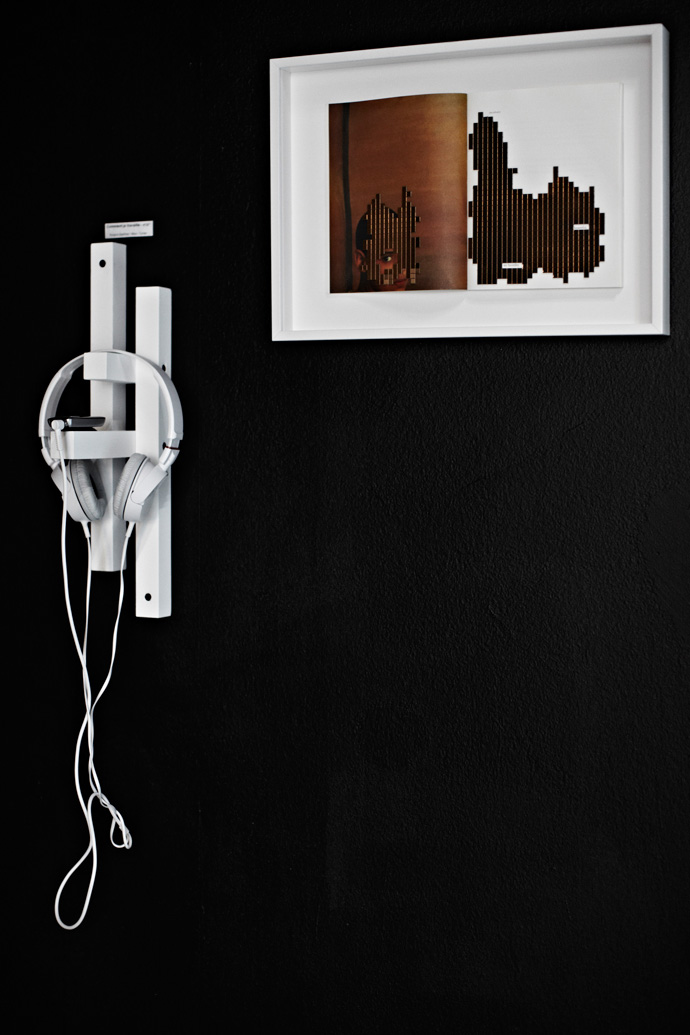
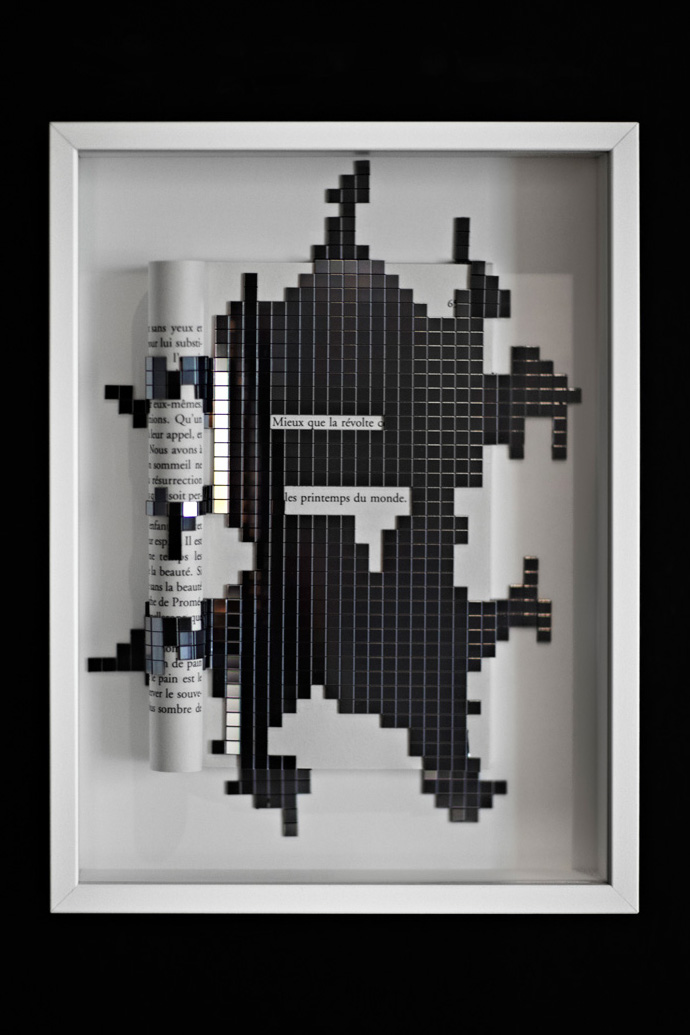 The collage sonore / sound collage installation in room 2. Courtesy Gallery Anne de VillepoixNear the pass to the next room the only book that depicts an image and with this marks the transition to the last complex of works. It’s all about stars and fashion magazines. But now the presentation enhances the fact that the magazines departed from being just the source of material. They become objects themselves, so does the frame and the fixture. It becomes altogether an installation: A cabinet of seven blocks present the works on shelves, hung, or in frames that at times can be turned and reveal a mirror. Mirrors everywhere. “Beyond, beyond, beyond the mirror”, as Patti Smith proclaims earlier in one of the audio collages.
The collage sonore / sound collage installation in room 2. Courtesy Gallery Anne de VillepoixNear the pass to the next room the only book that depicts an image and with this marks the transition to the last complex of works. It’s all about stars and fashion magazines. But now the presentation enhances the fact that the magazines departed from being just the source of material. They become objects themselves, so does the frame and the fixture. It becomes altogether an installation: A cabinet of seven blocks present the works on shelves, hung, or in frames that at times can be turned and reveal a mirror. Mirrors everywhere. “Beyond, beyond, beyond the mirror”, as Patti Smith proclaims earlier in one of the audio collages.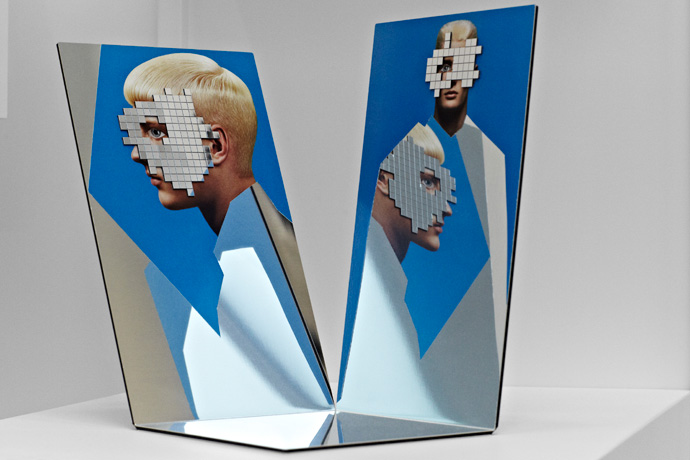 Object in room 3 at Gallery Anne de VillepoixMarc Turlan: EXO STARopening Saturday 10th, running to October 15th 2011at Galerie Anne de Villepoix, rue de Montmorency, 75003 Paris
Object in room 3 at Gallery Anne de VillepoixMarc Turlan: EXO STARopening Saturday 10th, running to October 15th 2011at Galerie Anne de Villepoix, rue de Montmorency, 75003 Paris -

editor MASANOBU SUGATSUKE : An edit of an edit
-Masanobu Sugatsuke is one of the most influential editors, publisher of magazines such as COMPOSITE, INVITATION or METRO MIN in his native Japan, and of books with Mark Borthwick, Elizabeth Peyton or Jeff Burton. Masa considers himself not exactly a trendy person, yet is always on a forward trail, much ahead of his time.
THE STIMULEYE talked with Masa on the outlook of publishing and the editors future role, but also his recent book EDITORIAL PARADISE in which he is looking on his past editorial work. A reflection in a radical manner, rarely dared by others of his guild.
An edit of an edit, a compilation of compilations?
He’d been advised by a fellow columnist that “When an editor enters the spotlight, he automatically announces that it is time for him to go” he was told, as well as “an expression reaches a deadlock the moment it becomes self-referential”.“But wait a minute,” he writes in his foreword, “Godard and Truffaut initiated the Nouvelle Vague with their filmic reflections on film; contemporary art has developed as a form of “Art reviewing art”, and Rei Kawakubo and Martin Margiela keep proposing dresses that inspire the wearers to think about dressing. Could it be that there exists a whole different level that self-expression can only reach after going through the painful stage of self-reference?”
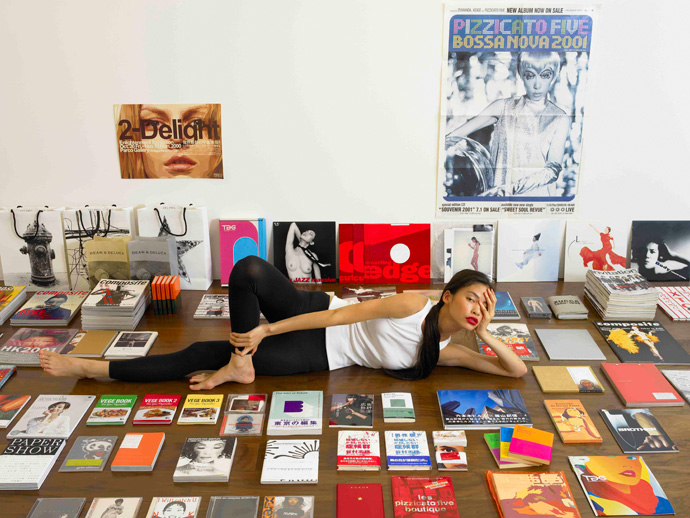 Works of Masanobu Sugatsuke laid out for EDITORIAL PARADISE.
Works of Masanobu Sugatsuke laid out for EDITORIAL PARADISE.When i visited you at you last time in Tokyo at your office – we had not seen each other for quite a long time.
Meanwhile you had halted “Composite” , and published your book “Editorial Paradise” revisiting your inventive editorial work of the last 25 years. Interestingly, this reflection coincided with a turning point, a time where the role of the editor is challenged through mechanics introduced by new media. To me it almost felt like a “katharsis” (精製) – in this context. Not only a personal one…
Talking about my book “Editorial Paradise”, I think that a retrospective book of a living editor sounds strange for everybody, even for me!
But to edit and launch it, it made me consider a lot about the role of editors and definition of editing nowadays.
I believe the role and definition of editors and editing has been drastically changing these days, because of the growing role of new media. But a few editors have been trying to define their new roles and public meaning.“katharsis” you mentioned is quite a suitable word to describe my time editing this title. Editing this retrospective is like confession for me. But confessing what?
I can tell you about it clearly now, I didn’t know the meaning of editing until that time.For this book you told me you’ve decided to include everything from the volumes that you’ve done, which is somehow “anti-editing” – was that part of making you realise the meaning of editing? What is your conclusion?
I’ve always aimed to expand the definition of editing. Through the editing process of this editorial retrospective, I recognized that the changing state of editing my thinking simple-minded.
So, what I came across through this process, – it was fun but hard for me to think deeply about editing all the time all day long and I felt like being ouroboros – is that editing is not about media.
I think editing is a way of thinking. It’s not like making film, designing a website. It’s a purely abstract idea to make something concrete.My definition of editing is quite simple.
1: Drawing up a project,
2: Recruiting a team of collaborators,
3: Creating something,They are the three basic conditions of editing, I think. If someone does something with these three conditions, whatever it is, I’d like to say “that’s editing”.
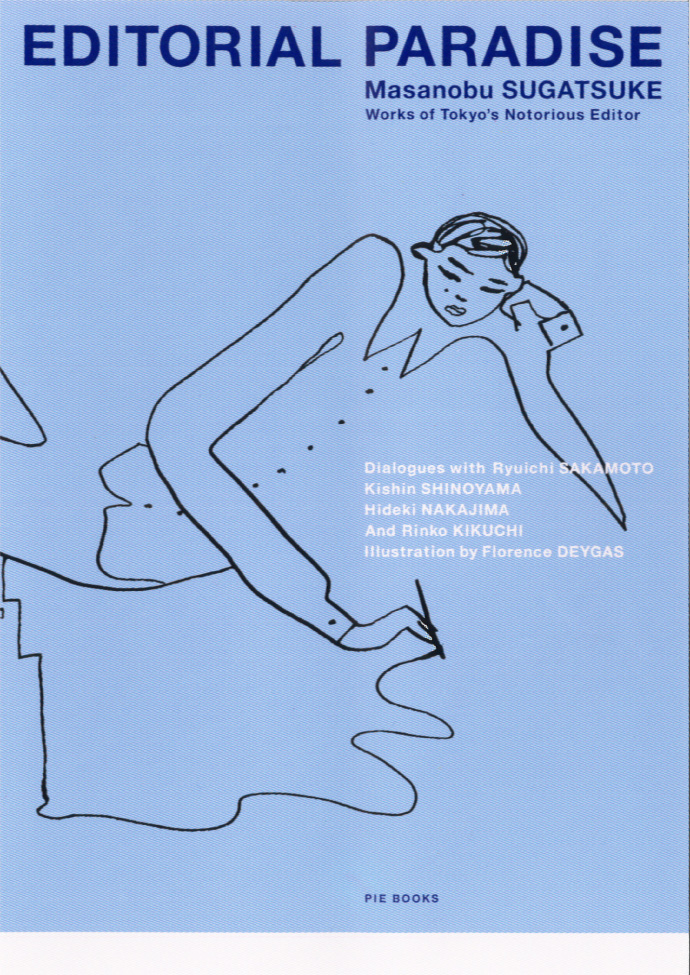
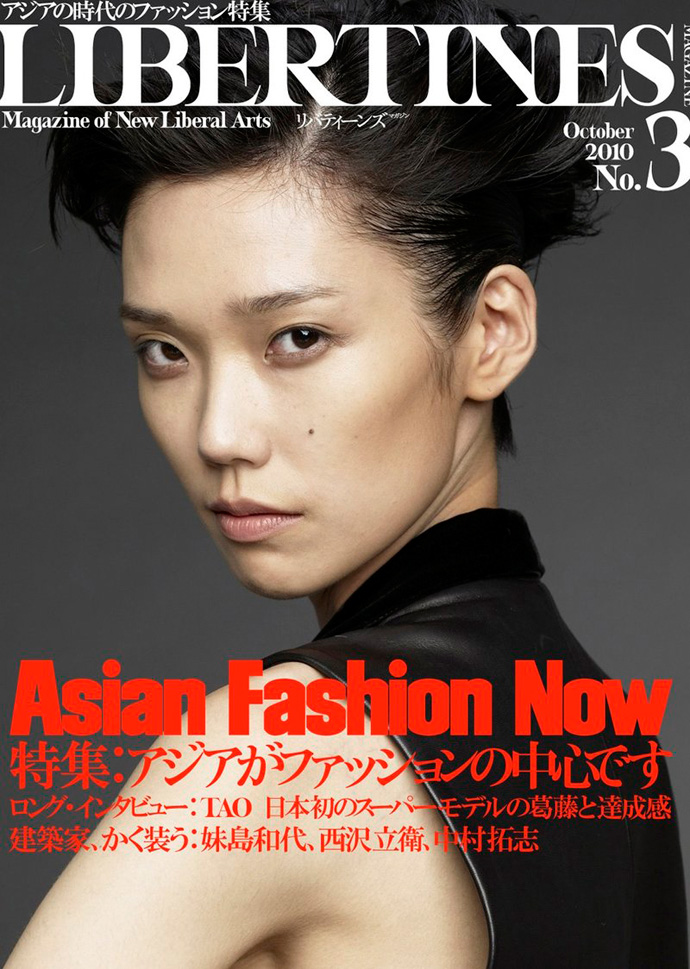 Sleeve of EDITORIAL PARADISE with an illustration of Masanobu Sugatsuke by Florence Deygas and a recent LIBERTINES cover
Sleeve of EDITORIAL PARADISE with an illustration of Masanobu Sugatsuke by Florence Deygas and a recent LIBERTINES coverIt’s something rare in this profession to put a focus on the act of editing itself, especially one’s own and in such a radical way as with your latest book.
As you can see, editors have been defined as interpreting someone to someone else, or something to something else. That means “Don’t express your own voice through your works. You are an in-between guy!”.
That’s 50% right. But there are so many high-profile advertising creative people all over the world. They are not behind the media at all nowadays.I believe editors are mainly present in-between and behind media, but sometimes they are beyond media, i.e, Anna Wintour, who is Cabinet Minister of the Ministry of Cool, Terry Jones, Everlasting Evangelist of Street Style and Olivier Zahm, the second Gainsbourg.
I believe we, creative people, have to label ourselves. In other words, we have to “transform life into creation”.
Because, in this 21st Century, our creative lives are almost viewed and leaked by web and twitter.
It’s been getting hard for creative people to avoid being watched or criticized by ordinary people now.Iconic editors from the past seem in this context like vanguards of another time to come:
Diane Vreeland (American Vogue) or, on another side of the spectrum, Hugh Heffner (Playboy), both transcended their editorial vision with their personal lives.Today’s ever more fragmented stream of information requests perhaps a stronger necessity of structure through the personal standpoint…
How do you think the element of today’s over-exposure is influencing the role of the editor?
Over-exposure is big phenomena in our world, not just for editors. Modern people are fame-addicted.
On the other hand, we can show our way of living as an art piece. Lady Gaga’s case is the most excessive one, and Haruki Murakami’s case is the most stoic.
But both are most successful presentations of life as art piece today.As I said, our creative lives are mostly viewed, watched by the media and each action are “timeline”d.
So if you can’t avoid it, you have to be determined to show your life as whole art piece, as if Andy Warhol presented us.
So, Warhol said “Everyone will be famous for 15 minutes” in the 60’s.
But now everybody became Andy Warhol, just like taking photo everyday, quoting somebody’s ideas and images and commenting as one phrase philosopher on twitter or blogs.Our creative works are slices of our creative lives. People nowadays have a tendency to prefer the real lives of creative people to their work.
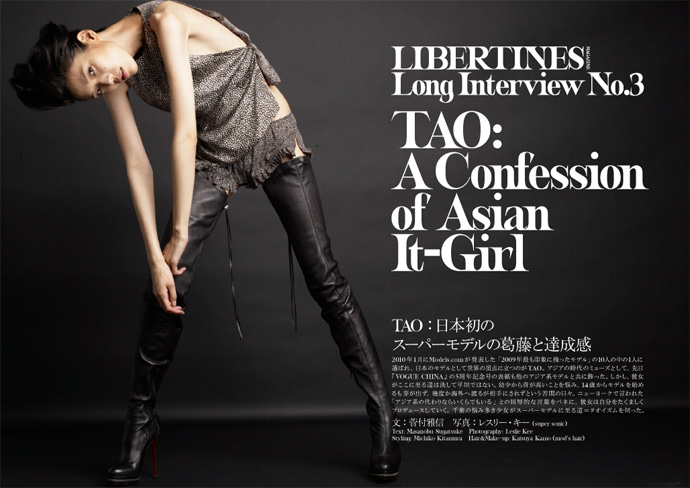 Spread of "AISIAN FASHION NOW" from a recent issue of LIBERTINES. Photo by Leslie Kee
Spread of "AISIAN FASHION NOW" from a recent issue of LIBERTINES. Photo by Leslie KeeIn these times, the stream of facebook statuses, tweets and re-tweets, tumblr and so on form a new way of consuming information.
You recently mentioned Paper.li to me – which seems like an attempt to “master” this stream almost a form of an “automatic generating editor”….Yes, “Paper.li” is a kind of semi-auto-updated personal web magazine. On the web, if you curate something, you can be an cool editor. Therefore “first hand” is getting more important for media and creative people. Audiences can’t get interviews of celebrities and take their photo first hand.
So, “first hand” sources and high profile people are the last sanctuary of professional media and creative people.
But if they are lazy to maintain “first hand” capability, audiences will rob it.The internet is certainly a big accelerator of this “theft”!
What we’re missing out besides “first hand” is the synthesis of information and its digestive analysis.
I am wondering how do you expect the print media to react to this and how you see its perspectives in the long run, in balance with the digital publishing?I expect that print media will live with digital media in symbiosis. I believe print media will survive, as opera and theatre play do.
But not mainstream in the media.
There are two kind of information, flow and stock.
Internet is a best media of flow information. Print media is a best of stock information.
For creative people, beautiful books must be great tangible assets.
In this 21st Century, tangibility and physical experience can be more important because internet cannot provide them.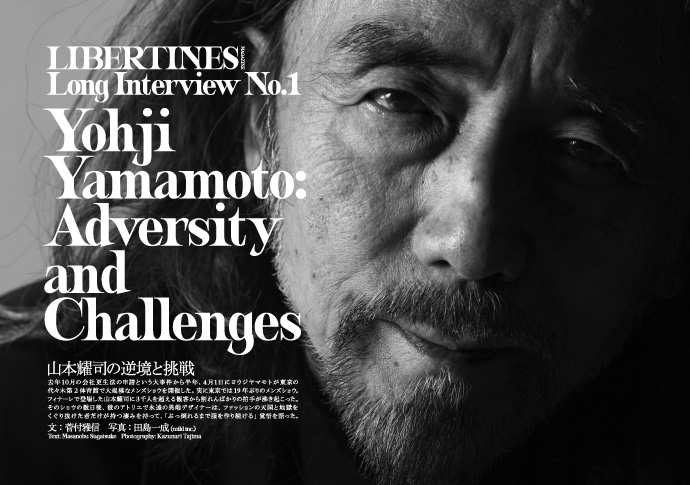 Opener of the Yohji Yamamoto Interview of LIBERTINES
Opener of the Yohji Yamamoto Interview of LIBERTINESYou have recently halted publishing your most recent print magazine “libertines”-
what was your experience with this? Were the reasons related to the shift in publishing that we’re talking about?Talking about the end of “Libertines” magazine, I think I was a little bit too optimistic about the advertising climate and today’s readers. It was my fault.
Advertising for magazine has been drastically decreasing. I knew it. But I had estimated that I could have get a certain amount of it when I started “Libertines”.
But I couldn’t. It was worst time to start a new magazine in Tokyo with a professional level of budget.Plus, I thought we could get a number of readers similar to what we had before. So, for the first issue of “Libertines”, we had a special feature about twitter culture.
We had exclusive report about twitter headquarters in San Francisco in it.
As you can imagine, we got big buzz on twitter and web when it came out.
BUT this buzz were not enough to sell magazine.It is a similar situation for musicians and the web. If some musicians get big buzz on twitter and facebook, but their record sales are not related with buzz unfortunately these days.
It happens in magazine world.I think “buying magazines” has become an old habit, or habit for people over 30’s.
If you aim to produce youth culture-medias and package contents, there are few actual youth consumers who buy them naturally.On the other hand, I’ve been directing another magazine “Metro Min.” for two years as creative director, it is quite successful because it’s a monthly free lifestyle magazine which is published by a major publisher.
So, it is hard to sell magazine to the FREE generation. I’ve been struggling with this issue.
I don’t have a clear solution for it. But I’m not pessimistic about the future of magazines. I think publishers and editors have to organize a new kind of structure to make profit not only to produce print medias.I believe there are great examples in the movie industry. The movie industry is not just about movie theatre nowadays as you know. It is an environment with movies.
I think that’s the hint for editors.

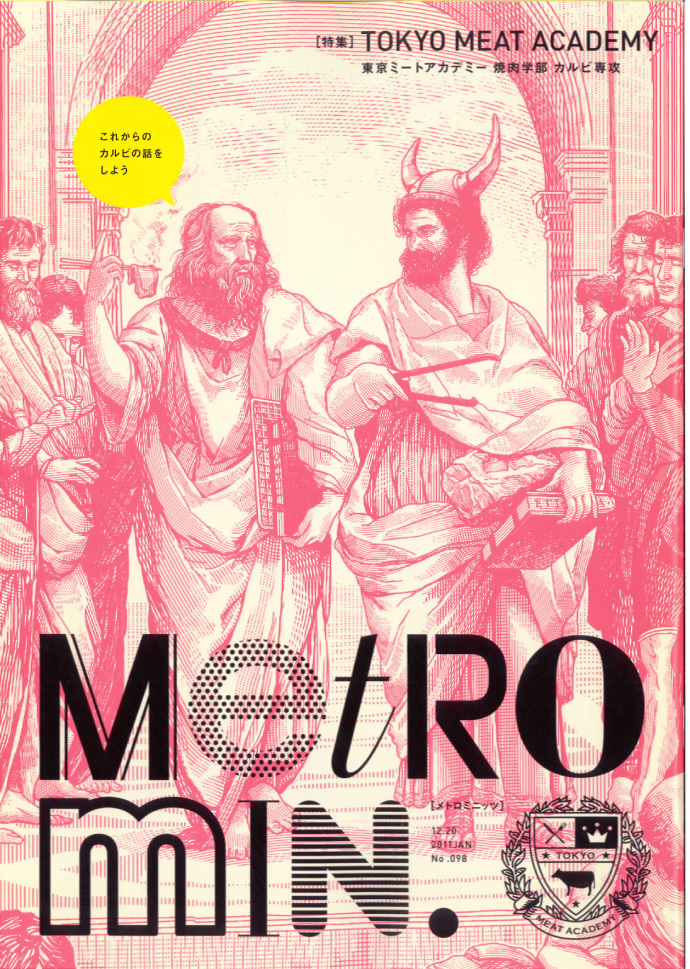 Covers of METRO MIN, the most recent publication of Masanobu Sugatsuke
Covers of METRO MIN, the most recent publication of Masanobu SugatsukeWhere do you see the future?
I’ve been thinking about the fate of both print media and new media all the time as I mentioned in our previous conversations.
And as you see, nobody knows. But there is one certain thing that I can say, that is if you love something, you’d like to own and touch it.
Same as your lover. That’s the human nature which will not change forever.People nowadays talk mainly figures and speed of modern media. But media are not only produced by them. Of course, these specs are important.
But images, sympathies, affections and favoritism are very important elements of media.
If these elements are all included in one media, then it will be a loved media no matter if it’s in the form of digital or print.I believe that creative people have to concentrate on how to produce a loved media to audiences. I think that’s the priority.
The last thing stimulated that stimulated you?
So many things and it is hard to answer to choose one particular thing.
Here is the list what I was stimulated after 3.11, the Great Earthquake in Japan.# Cindy Lauper concert in Tokyo on March 17th, just 6 days after Earthquake.
Cindy is a quite brave artist who did Japan tour in such a catastrophic situation and she commented during each break between songs to encourage audience in Japan.
She sang her masterpiece “True Colors” in encore with mix of John Lennon’s “Power to the people” and almost the whole audience, including me, wept.# Takashi Homma photo exhibition at Tokyo Opera City Gallery in April
Homma’s biggest exhibition in Tokyo which shows his conceptual landscape in Japan and Los Angels which was collaborated with Mike Mills.# Jane Birkin Charity live at Shibuya Club Quattro, April 6th
Jane Birkin is not just an actress or singer. She is a role model of modern women.# Anti-Nuclear Demonstration in Koenji, Tokyo, April 10th
Most biggest and joyful anti-nuke action in Japanese history. So many musicians joined it and I participated in it. People have the power!# Saburo Teshigawara dance performance at Kawasaki City art center, May 6th
It is a final answer to the question “How can movement of human body be radical and beautiful”. Teshigawara does European Tour this Autumn. Must-See!# Henry Darger exhibition at Laforet Museum Harajuku, Tokyo, May
Legendary outsider artist’s big retrospective. So innocent and scary.# Yohji Yamamoto’s 30th anniversary party of his brand at Y.Y boutique in Tokyo, June 1st
Yamamoto is a last samurai of cutting edgy couturier. Congratulation!
-

MARIOS SCHWAB
-MARIOS SCHWAB TALKS TO FILEP MOTWARY
PHOTOGRAPHS BY RENE HABERMACHER
Marios Schwab is known for his unique interpretations of natural forms and his ability to dress the female body in a way that he only knows.
While the world of fashion turns its attention to ephemeral trends, we decide to interview Marios and hear him analyze the Schwab philosophy, his position at Halston and the analysis of his very first Resort Collection, one day before its revealed to the public and press.
His collections are based around reflecting the inner structure of a garment on the outside, a theory that helped to define him as one of London’s most exciting designers – a position he continues to hold.
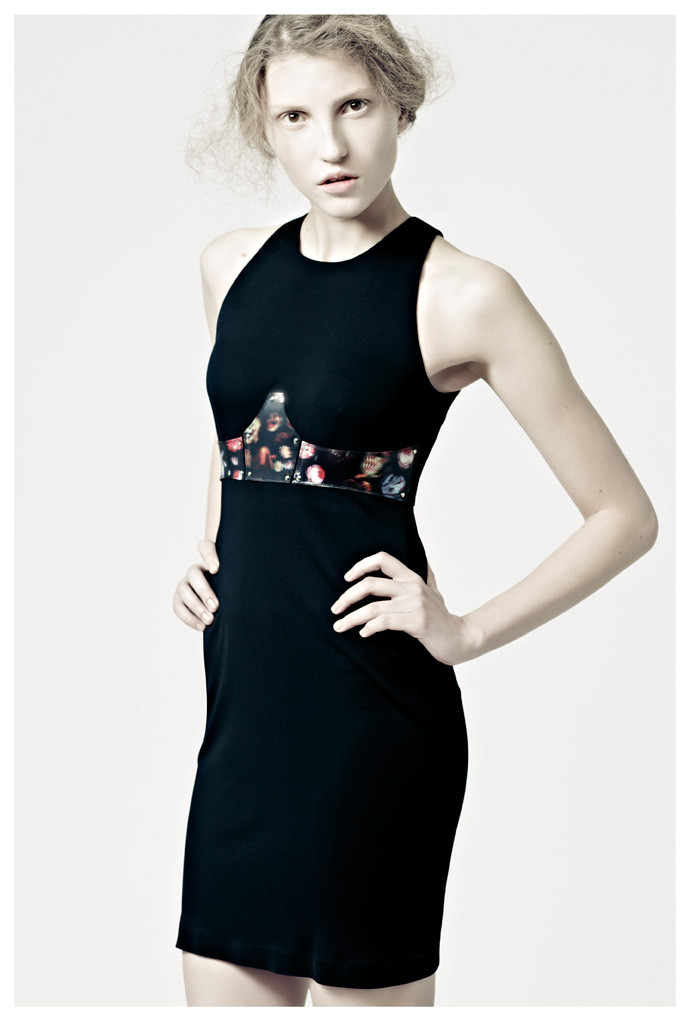 Marios Schwab resort collection 2012. Photography by René Habermacher
Marios Schwab resort collection 2012. Photography by René HabermacherA distinction and Best Student Award graduate of Esmod, Marios moved to London in 2003, where he completed an MA in Womenswear Fashion at Central Saint Martins, studying under the guidance of the formidable Louise Wilson.
Two years later 2005 saw him launch his own label, showing for two seasons with Fashion East before making his on schedule debut at London Fashion Week for SS 2007
Since the Spring of 2009, he was appointed as the creative director of HALSTON in New York.
Schwab’s designs are sold all over the world, in shops ranging from Dover Street Market, Harvey Nichols and Browns in London, to Maria Luisa in Paris and Barneys in New York.
Photographer Rene Habermacher met with him in London for the creation of the pre-collection’s look book
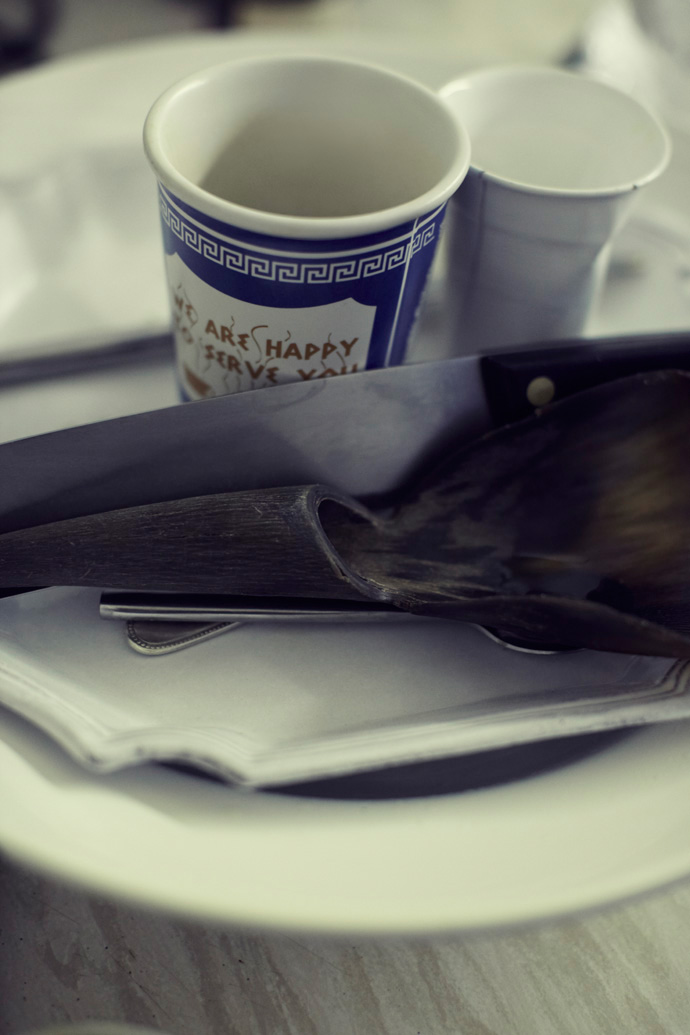
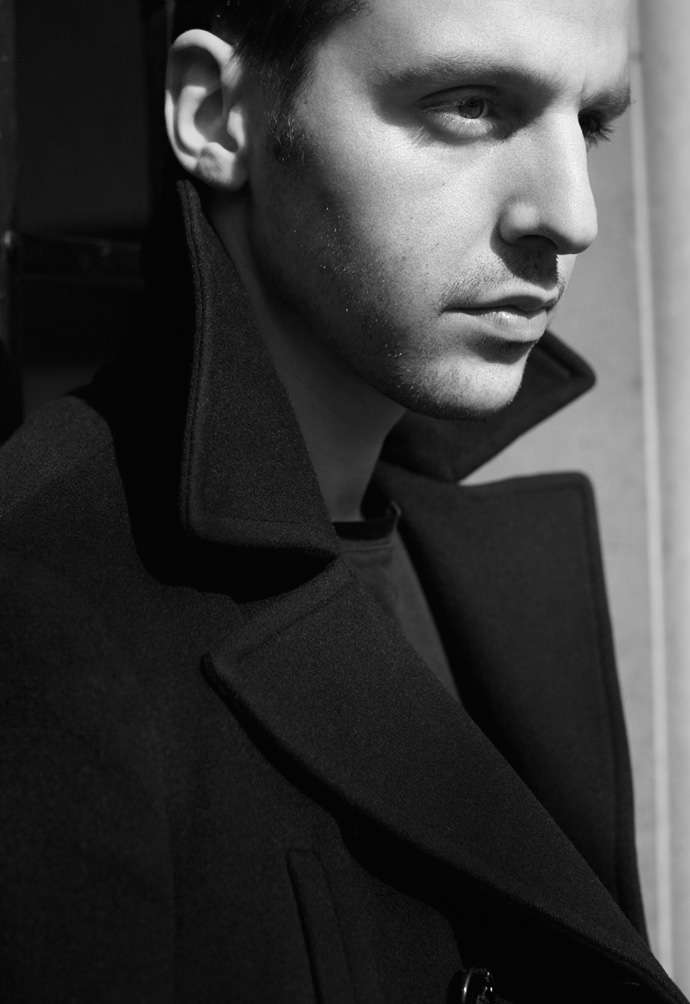 Marios Schwab and his Greek coffee set at his studio. Photography by René Habermacher
Marios Schwab and his Greek coffee set at his studio. Photography by René HabermacherHow are you today Marios, what have you been up-to since this morning?
Pretty much like I came from Paris and immediately started working on the main line…It’s a non-stop situation right now because I just did my first resort collection which was in a way an experiment in terms of getting in right with timings and deadlines, a completely new experience for me. Also we are producing this collection elsewhere outside the UK.
You just photographed your first pre-colection for Summer 2012 yesterday with Rene Habermacher?
We started shooting on Friday; he came over to London and shot the collection in my Studio.
What is your pre-collection about?
I went to Vienna for a weekend where I visited Kunsthalle and saw these amazing series of Vanitas paintings from Dutch painters. For me they always have this feeling of seduction and mysticism that I really like and the hide-reveal again which I am so obsessed about. I wanted to create a print that kind of works color but still within a black background…
It all started with creating the print with artist Tom Galland, who is a friend living near by and with whom we work on numerous collections together. The outlines pretty much echo shapes that have a classic sort of detailing from Maris Schwab, torn down so it becomes easy to wear and accessible for the younger girl that wants to buy, but not necessarily can afford. It’s about clothes for someone who doesn’t want to wear something that is too tailored.
How did you decide to add a pre-collection in your work? Was it after popular demand? What it the aim of a pre-collection anyway?
Yes first comes the “demand” as you said because the main line concentrates on tailored pieces, cocktail pieces mainly, and has the element of fabrics that are more sculpted. There was an easy-wear-feeling missing. You know, easy things that make more sense in a resort collection rather in a mainline. Fabrics like jersey, which is great to wear, in a good quality and good price. Its something that was requested from the top floor but also the feeling of having to return back to something that is a little bit younger was very very important to me.
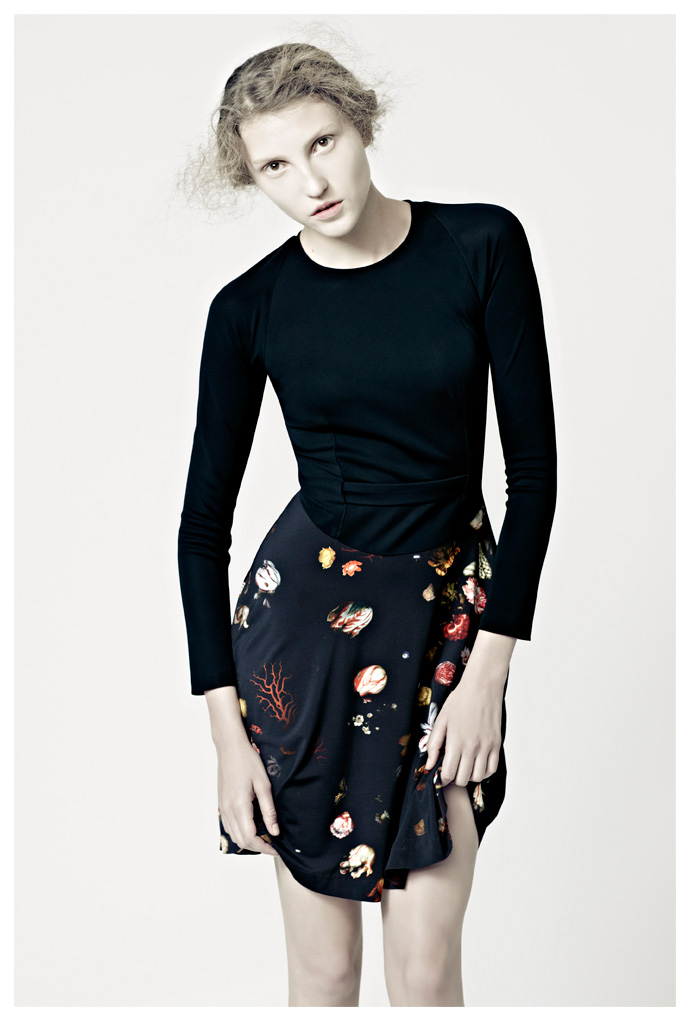
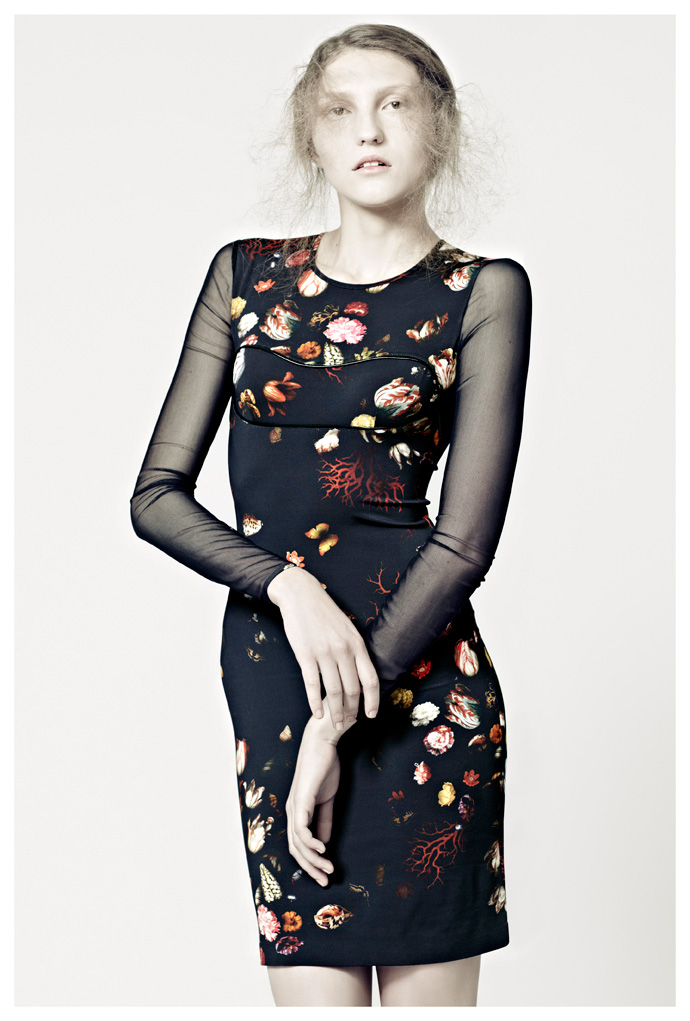 Marios Schwab resort collection 2012. Photography by René Habermacher
Marios Schwab resort collection 2012. Photography by René HabermacherHow is this collection pricewise?
Well it starts from 200 GBP and reaches s 750 GBP. That was the main point, to put very interesting detailing from the DNA of Marios Schwab-keeping the outline and fit on a friendly price. It is quite an interesting thing to do I guess because when you start a collection with this thought pros-mind-set becomes automatically an interesting project. I was concentrating on dresses that you can put on daytime and also in a club or to go travelling with and I think this is something I would like to concentrate on at this point and turn it as the signature of the resort
Marios, it often seems that you manifest an idea way ahead of its time, even two seasons before others pick your ideas later. How do you work, develop these ideas and where you withdraw your inspirations?
Well it’s a lengthen process because I always like to bring in the surroundings of my own life, or what I hear in any sense politics, stories, everyday life, as its an emotional story developed into garments. I don’t know how to explain it really. It usually starts with materials and then it develops into proportion and sectioning of the body in a certain way.
Last season how it started for example, was after a documentary I watched about ancient Greece and the oracle temples. There was this amazing building- I don’t remember where it is now-but it was saying that “nothing in excess.” And it kinda gave me the idea that basically its very much about what we are right now: overloaded with information but also we want so much out of everyday life, some can afford it, some cannot. For me, the process of it was to take this theme and create something that is beautiful with craftsmanship.
So I started reading essays about craftsmanship, then I came across the work of Adolf Loos, an architect from Austria who worked on finding the meaning of decoration and its meaning in society.
To cut the story short the collection was based on minimized craftsmanship and how it becomes an over precious part of each garment. So really framing the details on specific parts of the body that becomes precious at the same time.
I like to place things where they don’t belong from time to time. Broking was one element but also the status of symbols like a pearl necklace and how it can be re-translated in a modern way. Within this season, the Vanitas paintings for me meant life, beauty but at the same time possessions and darkness. It’s so beautiful and it reminded me of Victorian wallpapers, bursts of flowers with a dark background. All these harmless detailing in the collection like elastics that wrap around the body and create the draping reminded me of my earlier works since Spring Summer is very much about the inside outside, how you can retranslate draping without looking like a retro reference, you add a utilitarian element to it but then it’s a little bit more modern.
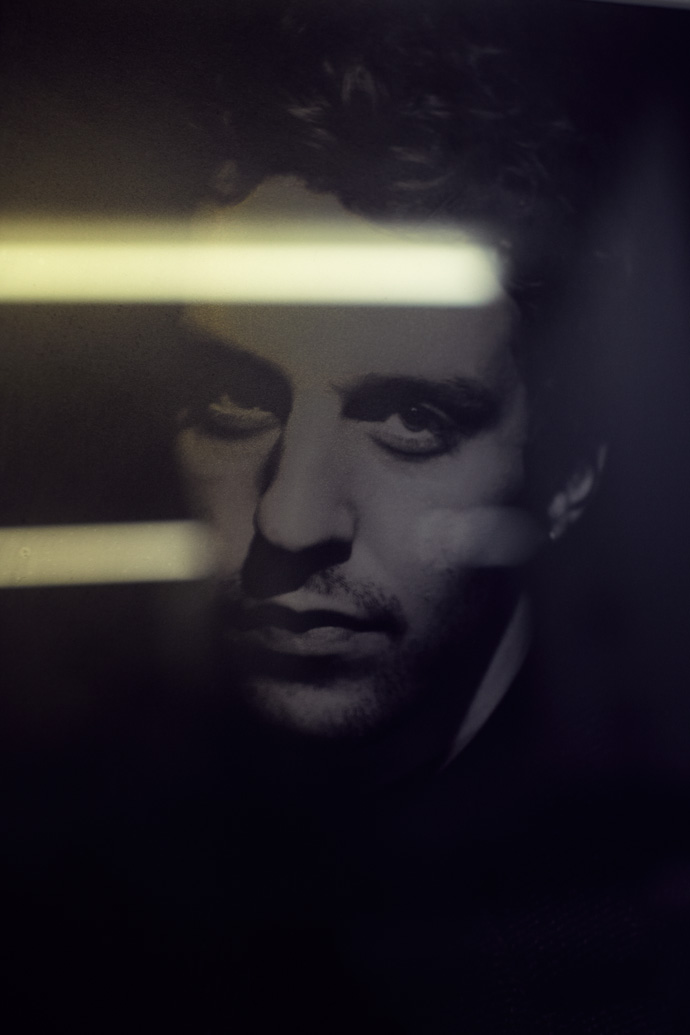
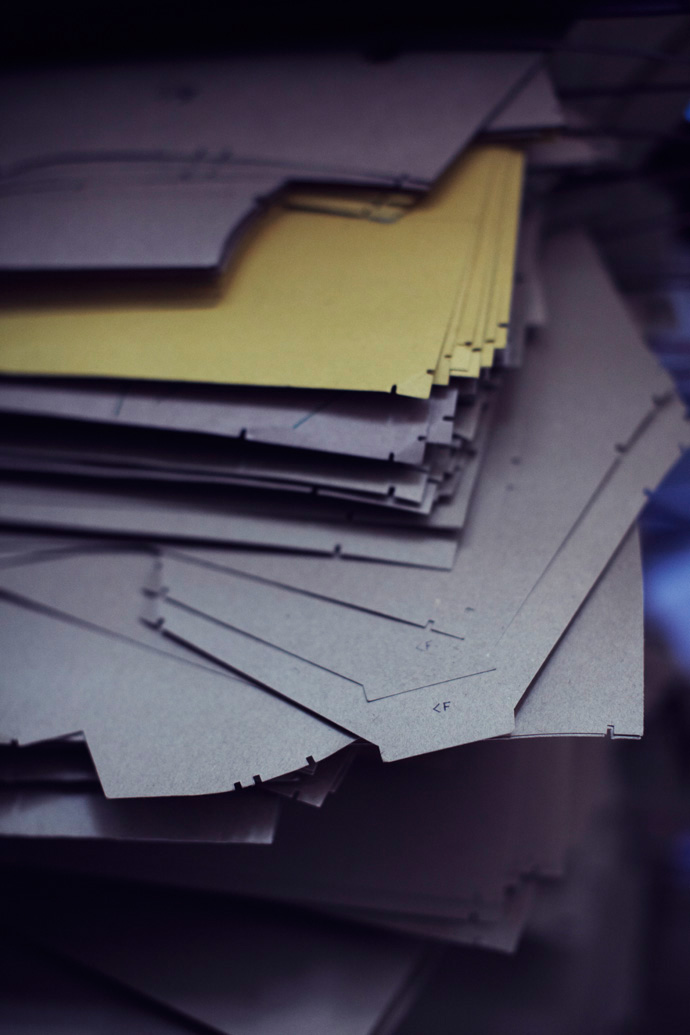 Vintage print of Marios portrait by Paolo Roversi, and Patterns at the studio. Photography by René Habermacher
Vintage print of Marios portrait by Paolo Roversi, and Patterns at the studio. Photography by René HabermacherIn the last five minutes you used the word “craftsmanship” for more than five times. How important is craftsmanship in your work?
It’s the most important thing for me. The way I learned the trade was going to Austria at the age of 15, surrounded by manic women, teachers that knew everything about traditional techniques, probably not very used these days unless of course you work for a couture house. It became my obsession and also something I am very much fond of. I like the humbleness of a craftsman and the sound of craft. I feel so comfortable sitting next to a person that is s specialized and so focused into his work. There is certain romanticism in it that I always go back to. I like sitting in a studio surrounded by the fabrics I just got from the manufacturer and then turn them upside down doing things I didn’t even suspect. I get a kick out of it, not to buy something that is finished but apply something to it.
I guess that can be said about women or the girls that inspire me. It’s a woman with personality- I don’t like women with no character. I don’t see a woman only as a body to dress. I see her as a strong persona that has a little bit more that just attitude. For me, women should be running the world at this point.
I like women who are intellectuals and private at the same time …I make a subtle story each time for them that does not overload their personality, enhances their personality.
While having a closer look at your past collections, I noticed that you continue to focus on the women’s body structure, emphasising on the waist and shoulders. Though now, your work has become more confident and much more strict than before…Do you agree, how do you see your work through the years?
Basically the starting point of a collection is always a naked body –in that I draw around the bodylines that are very much continued over the years I have been working. Whenever I dress a body I like to reveal what I also hide under a garment. From an architectural and proportional point of view it’s the most interesting part for me. What you cover you can reveal in a very sophisticated way on the surface of the fabric but also the cut.
There was certain toughness in your winter 2011-2012 collection with the use of leather and all…
The winter collection indeed had a feeling of toughness and that’s a classic element I guess in Marios Schwab that contains this femininity within something that is the good girl and the bad girl together. There is the prettiness and a sexual element within something that is sometimes quite strong and tuff. And I like to mix leather in a sense that you take the lady completely away from clothes. I don’t like ladies. I like to have a non-pretentious woman and I think that when you look closely to the garments you can see that they are not pretentious and that’s very much about the aspect of Schwab. My dresses need to be appreciated close by and I like that they don’t scream aloud but at the same time with a closer look you learn to appreciate them, their line and the detailing.
Taking elements that are very lady like and gentlemanly, for instance the broking and the pro necklaces kind of annoy me when I see them on women cause they are just too preppy.
I use them in a way that they become almost irrelevant of their status, hidden behind seams or they grow out of a seam either the are attached in a different way and become a utility, not just decoration. This is something I like doing also, using decoration at the same time in a functional way.
Remember the metal piece from an earlier collection of mine? The point wasn’t to create something shiny with a reflection in order to simply impress the guests of the show.
I thought of it as a garment that gives you this extra support when you dress up and feel you are wearing “something”. Psychologically, in some dresses this is missing, also in fashion these days. People used to take time to prepare themselves, so I tried to modernize this vintage routine within this shiny dress.
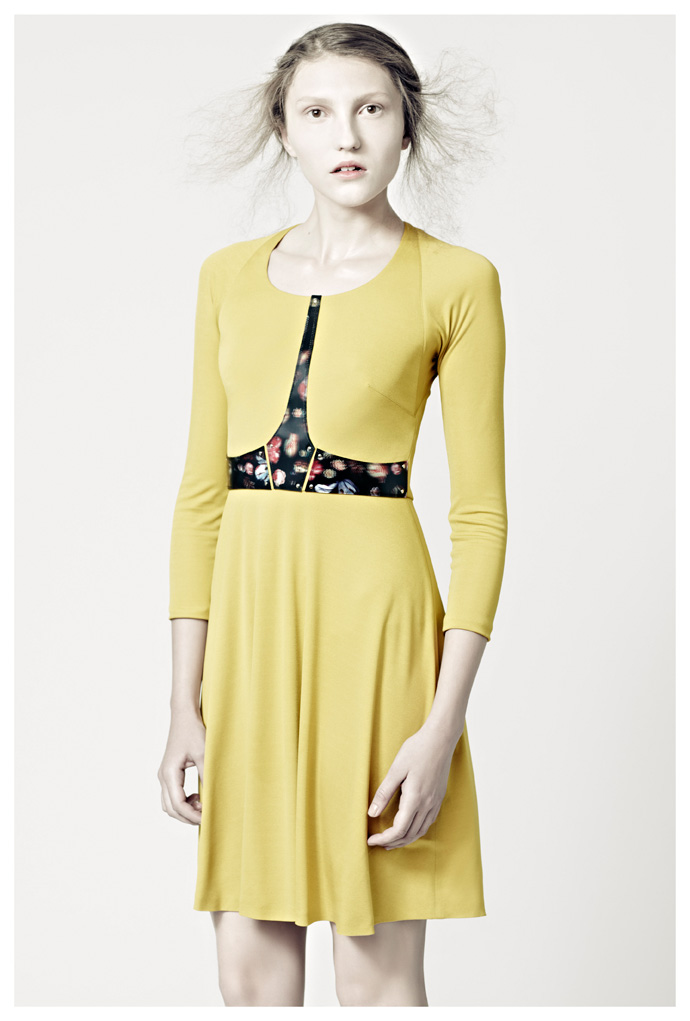
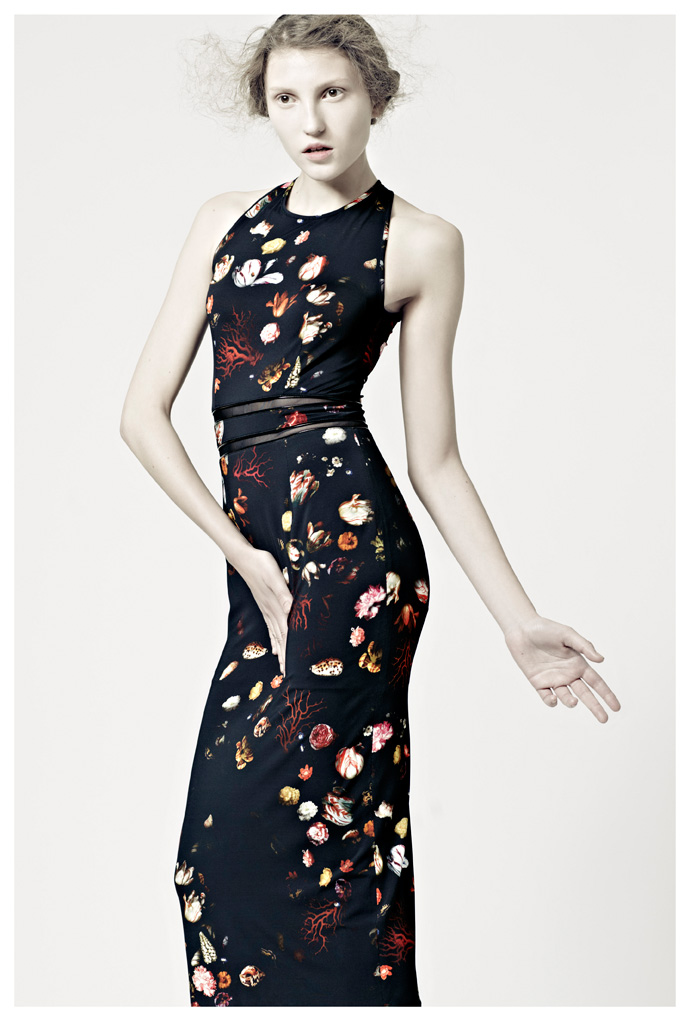 Marios Schwab resort collection 2012. Photography by René Habermacher
Marios Schwab resort collection 2012. Photography by René HabermacherHow has your involvement with Halston help your own brand you think?
I think it is such an interesting thing to work for another brand, with another team, travelling in a different country to produce a collection, which proved to be such a precious part of my Halston commitment. Basically you have a team that works abroad, that you are not very close to most of the time, you have different deadlines than your own. All these made me feel much more strong. You know also since I am the only designer there, I don’t have a team that designs alongside me which is exactly the opposite from what happens at Marios Schwab. It surprised me quite a lot. I always thought that it was going to be hardcore, working for two brands at the same time. It is hard but not as difficult I had in mind it would be.
Crazy in what sense?
Meaning the sense of “switching off”. I was surprised on how I could switch off from my collection, going to Halston do something else and then back again and back again… I felt a little bit scared before taking the job. It’s indeed a huge responsibility but you learn to do it, that’s it. Its pretty much like “you have to get on with it”!
What made Halston such a rarity as a House?
Halston as you know was concentrating on enduring fashion and I’d love to see Marios Schwab doing that,..
Halston encloses a story behind it that you can always see something else if you try looking closer. At his time Halston was creating, he offered something that was a very subtle, a minimal way of looking glamorous by wearing something simple and yet looking beautiful and seductive and expensive and clean. He had a very modern way of making clothes. The principle probably is the attractive one, what it was all about. But it was also attached to Studio 54, a very special place of that era and it was in everyone’s expectations. People just love it and for them Halston is attached to Studio 54.
Do you think your customers understand you better than your critics? Also how do you respond to bad criticism?
I don’t read reviews anymore because it just confuses me. After a show you are very tired and very emotional and personally the last thing I want to do is read criticism, good or bad. One critic can lift you up or drag you down which sometimes its not very relevant to a person that works in a very personal way and in private. I go meet people, the consumer, and the woman who wear what I create. You want to hear both at the same time, it normal but when you are still conquered by the after show adrenaline, you can’t just bother with that.
You belong in the Kane, Katrantzou, Pugh and Pilotto generation. It’s somehow like the “Antwerp’s Six” story. What in your opinion, all of you offered in fashion that was missing at the point you appeared?
I think quality, good fit within something that is very special and still acceptable and wearable. London at the time was about things that were more phantasmagorical..
So you are saying that you guys made the difference?
I’m not speaking about the rest, but yes I think that was what was missing at the time without pointing out someone specific.
Let me do that (laughs) all you have to do is agree or disagree (laughs). You all came at a point where as you said everything was very phantasmagoria and finally we had some wearable clothes coming from London, which was not the case before.
Yes, London started having a good balance. More than anything, the overall look was a little bit overwhelming. But I have to say that London is very special on that and supports all kinds of new developments, new ideas in fashion. It has to be said; you can’t really find that anywhere else’s in the world. Many people wonder, “What’s this thing about London, anyway?” But its true, London within this experimental nonsense or sometimes good sense it creates certain movements and in a way creates the platform for all of us to stand onto tomorrow..
What would be a designer’s weakness you think? What’s your weakness in that case?
Deadlines (laughs), free time. I can never organize myself to have a life. In this business you become very critical about what you do. It’s the mentality of living in your own bubble, creating for somebody else can be quite intimidating at some times, for others as well..
How difficult is for a designer to cross lots of different ages in one collection?
It’s a matter of confidence of the client. If you see a curvaceous person that wears a skin-tight garment, regardless of her age, whether she is a young girl or a woman and she has the confidence and attitude that matches the whole personality and appeal its instantly a success. This equals that the designer must have done something right.
Would you tell a client if she doesn’t look good in your dress?
Yes if she would ask me I would definitely tell her my opinion. If she didn’t, then why I would I tell her if she is happy with it? It’s her choice and one needs to respect that.
How do you see the present of Fashion?
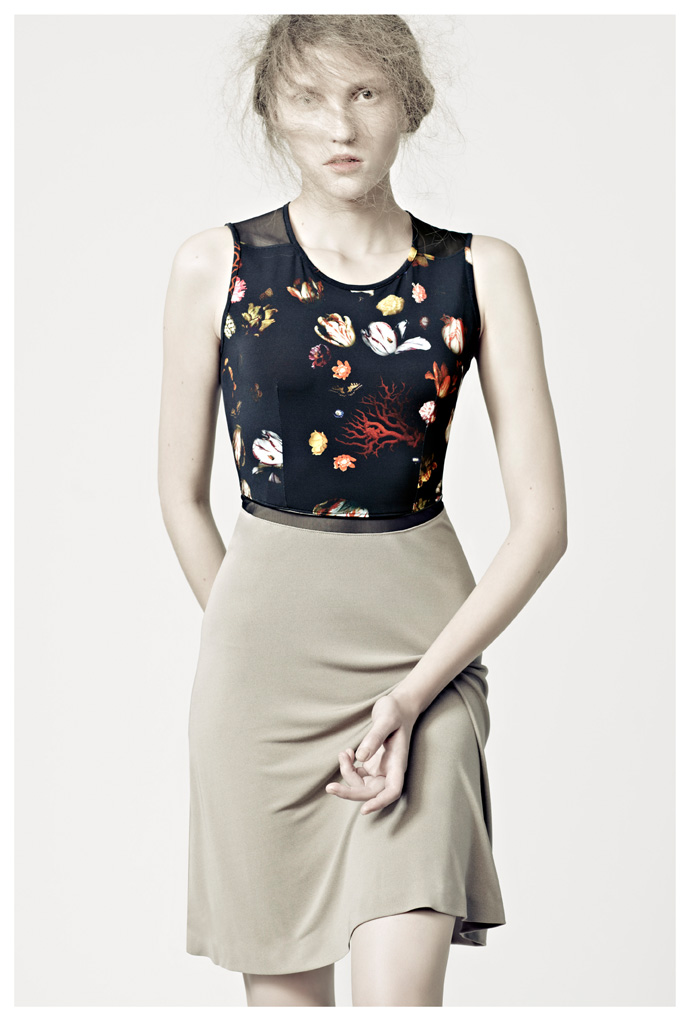
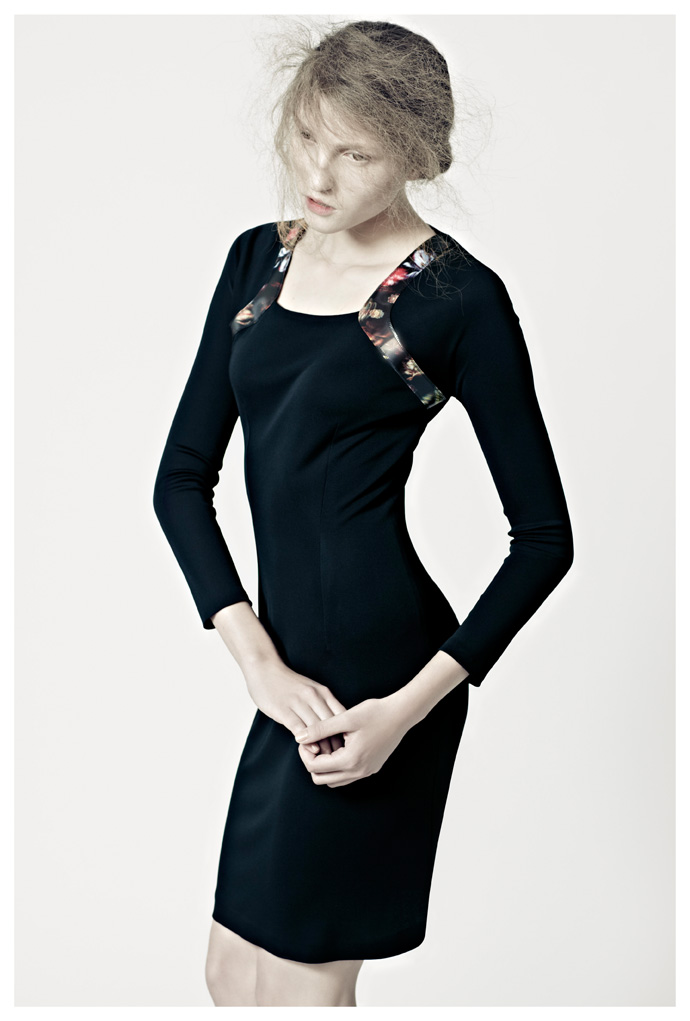 Marios Schwab resort collection 2012. Photography by René Habermacher
Marios Schwab resort collection 2012. Photography by René HabermacherShall we move to the next question? (Laughs). It’s interesting because it’s changing and its not changing at all. I think what changed is the way we get informed, how we advertise, and talk about things, how we buy things.
Everybody has a question mark about what they are doing these days…
The non-interesting part of this global change is throughout this financial downhill, the how quickly we gain information around us can make things very boring and very …
Things are supposed to be fast in fashion and although it seems that way, there is no new development in music and so many other creative sectors; and that is a shame because people stopped thinking unnaturally and they want to get into so many different characters since there are surrounded by so much information and don’t know how to handle it. They don’t have the time to study the new, see it from a distance, observe it, analyse it. It’s not a concrete period, there’s no certain opinion about things. You want to dive into so many different things because you have no other option.
It takes one bad collection to take a designer out of the spotlight you think?
I don’t know how it is but I wouldn’t see it that way I don’t know. You can have a bad collection because you decided to go on extended holydays and have a bit of a life.
Its interesting to mention that fashion can be such a fluff in the air. People think Balenciaga is amazing and next season they think Givenchy is the most interesting thing…sometimes it can become a little…I don’t know how to explain.. Do people have an opinion at the end? In previous decades or centuries this wasn’t much the case. Things were very specific. I’m talking about how people dressed, the way people reacted on fashion, art, their opinion…It was about dressing up your own way, to look pretty your own way and the way they looked upon things. Its not about buying the total look its about buying items from a collection in order to combine them with what you already have and make your look your own.

 Marios at his favorite afternoon stroll and part of his butterfly collection. Photography by René Habermacher
Marios at his favorite afternoon stroll and part of his butterfly collection. Photography by René HabermacherYou own your own company—nobody owns you. How’s that for a responsibility considering the reality of the fashion houses today?
I don’t think it’s necessarily a bad thing, no. The point is that our times as it is, its quite difficult to increase your team members, the structure, to tap into things you always dreamed of, like the way you want your company to spread out…
It’s not easy to do it by yourself without investment, or being helped by another source. It would be a shame to only be able to create clothes and not a whole product, that doesn’t only concentrate on fashion, not being able to communicate it right. Sometimes you don’t have the time or the money or both. But help must be welcomed.
I am curious to know, how many people work for you?
Hold on I need to count…Five full timers, mainly administrative and office work. I have one assistant that concentrates on fabrics and the boards.
Do you give chances to interns?
YES!! Yes!! Interns are so important, I like teamwork and when I refer to the team as always say “we”. It’s confusing for people. Who’s “we”?
I see myself as a craftsman, as I said before, I like to work within like a team that creates something that needs to be educated to us , to find our how its done and how its made and it takes a team of people that are special and committed to do that .
You can drive people crazy when you just give directions and not get involved in the making with them. For us especially, as we make all the samples in-house and it can get a little crazy. Students and the team that is here for years working with me seems like a family, we get emotional and fun and relaxed at the same time.
What I want from a student is to learn something special while running around in all the sections of the company, doing things, the boring jobs even,.. They need to have a complete idea on what it takes to be a designer because their time will come to open their own business.
Fashion is not a fantasy nor a party…
Do you ever let yourself go? Is there anything in your personality that you really have to keep a tight grip on?
The most important thing for me is family. They are part of what I do. My dad and mother enabled me to leave home at 15 to do what I wanted to do, feel free. They are critical about my work, which is very very important for me. Sometimes my mom doesn’t like certain things as she is a woman with style and she was the first who gave me the inside of quality and aesthetics.
In my private life I collect images I find beautiful. I like a variety of things, I love the impactful emotion when I sit on a beach somewhere in Greece, or sitting with old women on an island’s quiet little street, hearing them talk …Easy things and simple like that…
I like creating through emotion and experiences, history, the women I met n my life, their attitude, character. It can be very cinematographic. I build up a whole fictional character, created from my acquaintances with different women throughout my life.
What was the last thing that Stimulated you?
…my boyfriend..
-

-

TOO FUNKY to last: the mini decade
-The other day, Stimuleye Erotokritos Antoniadis swung by with a little treasure: when working as a stagiaire at Thierry Mugler, he was asked to snap some backstage pictures of George Michael’s TOO FUNKY video shoot.
And here they were – George, Thierry, the Lindas and Naomis, Shana, Eva, Rossy de Palma, Ivana Trump, Diane Brill, Lypsinka, Jeff Stryker and so on.
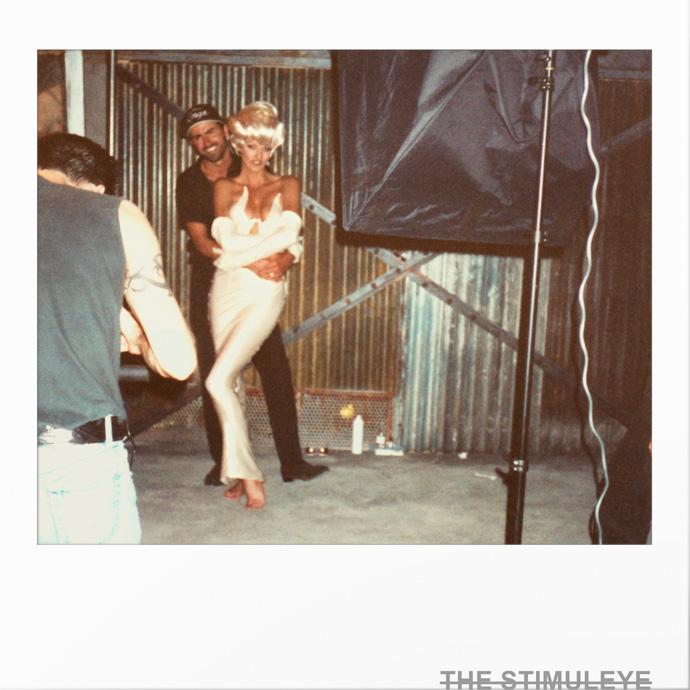 George Michael and Linda Evangelista on set of TOO FUNKY posing for the official picture. Photo by Erotokritos
George Michael and Linda Evangelista on set of TOO FUNKY posing for the official picture. Photo by ErotokritosThe song features a sample from The Graduate; Anne Bancroft’s line of “Would you like me to seduce you? Is that what you’re trying to tell me?” – and YES we were, then and now, instantly!
When this video was released in 1992, it was both the epitome of a glamorous era stretching from 1988 to 1992,
and a marker for the end of said era.An era that was no longer 80’s and yet not fully 90’s. What to call it ?
“80’s and a half” ? that would suggest that this era was an extension of the 80’s, when in fact it was more of a break…
We settled for the “Mini Decade,” a 4-year period with visual, musical and cultural codes so unique that they deserved a decade of their own.
As a teaser for our Mini-Decade series, here is a teaser, pictures which have been sitting in a box, unseen, for over 2 decades…
Stay tuned for more.
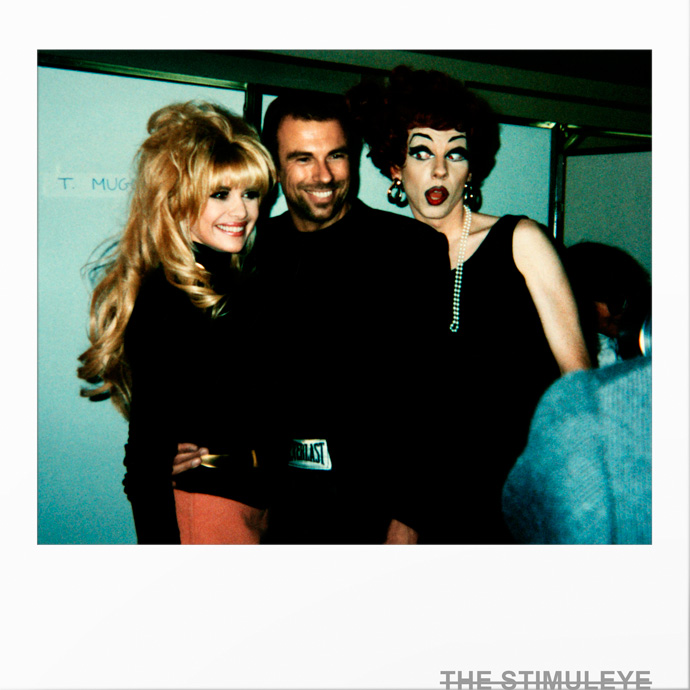
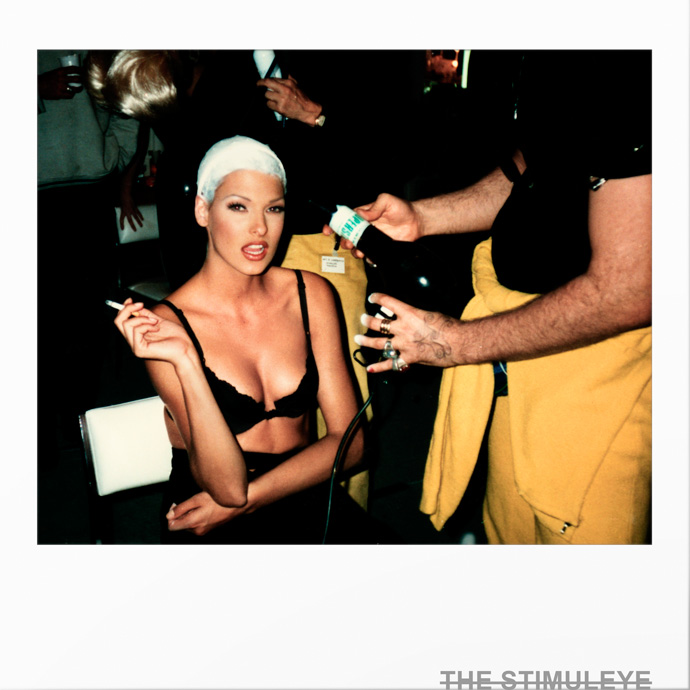 Left: Ivana Trump, Thierry Mugler and Lypsinka stand in for another snap
Right: Linda Evangelista, always ready for her 'look'. Photos by Erotokritos
Left: Ivana Trump, Thierry Mugler and Lypsinka stand in for another snap
Right: Linda Evangelista, always ready for her 'look'. Photos by Erotokritos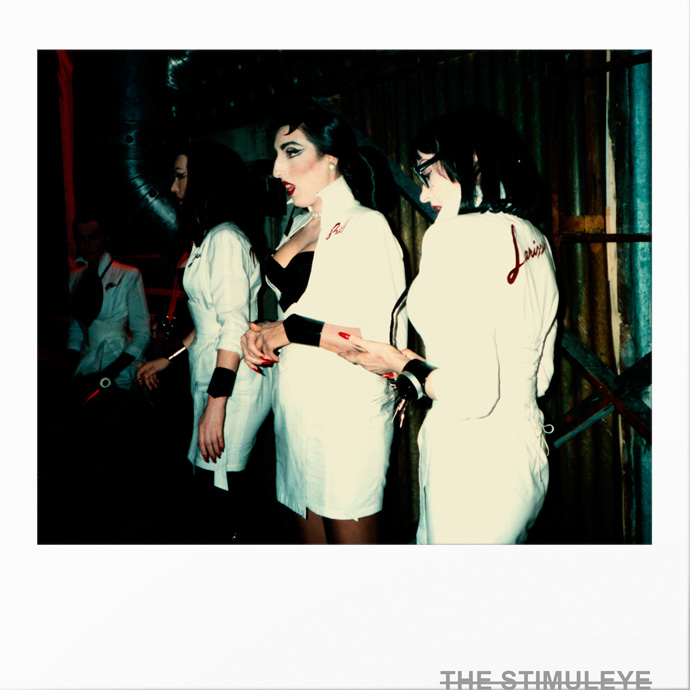
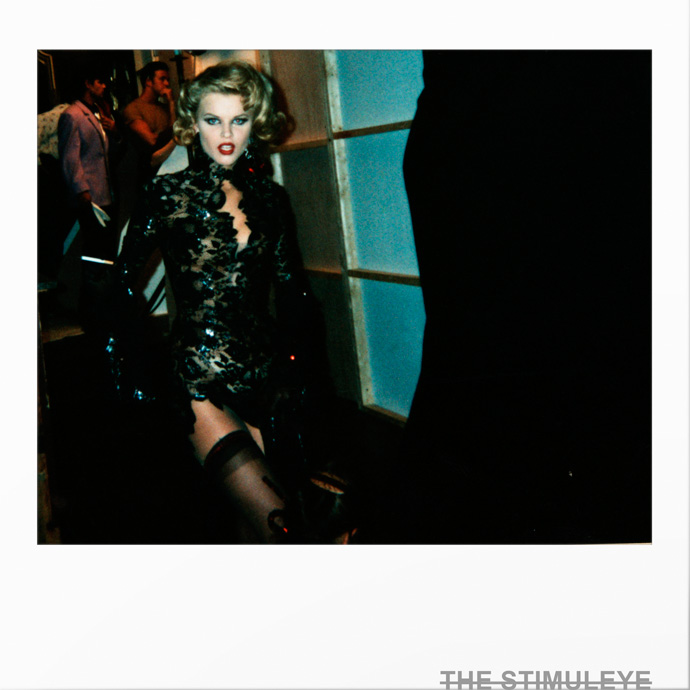 Left: Fierce Trio with Rossy de Palma, and Right: the very young Eva Herzigova. Photos by Erotokritos
Left: Fierce Trio with Rossy de Palma, and Right: the very young Eva Herzigova. Photos by Erotokritos -

-

MAX SCHELER: from Konrad A. to Jackie O.
-The exhibition “From Konrad A. to Jackie O.” at the Willy-Brandt Haus in Berlin will show for the first time a cross section of the work of Magnum photographer Max Scheler. On display throughout June and July are 140 images that document the distinct view of this artist who preferred to stay in the background. From this intimate eye-level position, he witnessed his time and documented its events with impeccable framing and allure.
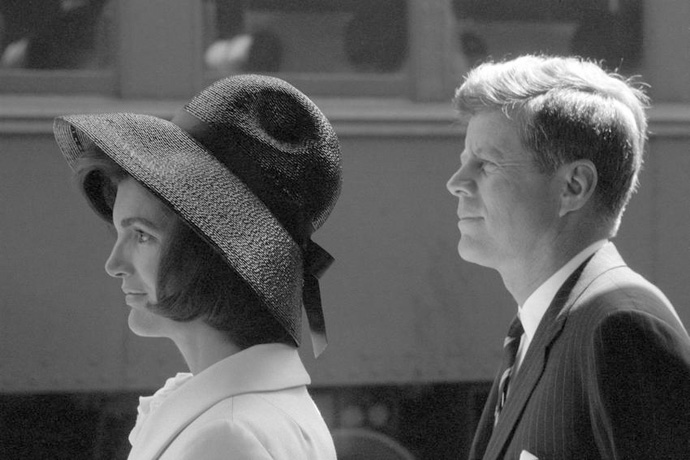 USA, 1963, Washington, John F. Kennedy and Jacqueline Bouvier Kennedy receive the Moroccan king Hassan II
© Max Scheler Estate, Hamburg Germany
USA, 1963, Washington, John F. Kennedy and Jacqueline Bouvier Kennedy receive the Moroccan king Hassan II
© Max Scheler Estate, Hamburg GermanyI remember Max Scheler with one of his beloved Davidoff cigarillos smoldering away nearby. He was an impressive character, with an elegant dryness that one would be tempted to account being Hamburgian, yet he was born a boy from Cologne. In his later years Max had dedicated his time entirely to taking care of the Herbert List estate – the iconic work of the photographer who shaped and mentored him. On one of my visits to the archives we went through folders and boxes of photographs and came so across prints of Max’ work for the first time, almost by accident. I had not been aware of his photography then, though i knew he had worked at Merian and founded the magazine GEO at Gruner & Jahr, introducing colour reportage to the wider audience.
I’ve talked with co-curator Olaf Richter, head of the estates of both Herbert List and Max Scheler about Max, his background and the relationship to Herbert List and the current exhibition
RENÉ HABERMACHER: How did this exhibition come together- and why right now?
PEER-OLAF RICHTER: The idea of this show was born in February 2003 – the month Max Scheler died. It took us about 6 years to finish this project. Why did it take so long? Max Scheler was humble if not neglecting his own work. He stopped working as a photographer in 1975 and since then had turned the tables. He rather worked to publish other photographers work, than his own.I took quite a bit of effort to rediscover what was going on in his life as a photographer. The negatives from the late 50s until the mid 70s were in a rough chronological order, but before that, the first 8 years, were all over the place. For us the first period was especially interesting, because it told us something of where he was coming from. He learnt photography from another photographer: Herbert List.
Herbert List printed the images that he considered important. The Estate had a rich base of vintage prints that covered all the projects he worked on in his life time. These prints were frequently titled on the back. The main books on List that had been on the market had all been made with these prints as a basis.
For Max Scheler things are very different. There is not that much vintage material, and it is hard to say if these old images reflect his personal choice or some editors preference. So we went back to the negative and contacts and researched there. Unfortunately the negative have only a rough labelling, and therefore it took a lot longer to make a selection, research locations and titles.
Max would always put Herbert’s work ahead of his own – which was something that I never understood. Why this hesitation?
I guess he felt that his work of that period, was the work of a pupil, while the work of his teacher, was really what was worth remembering. It is interesting how close the two worked together. After an initial year or two as an assistant on the road and in the darkroom, Scheler started getting his own assignments, gained some respect, moved from Munich to Paris, met Robert Capa and even became a junior member of Magnum.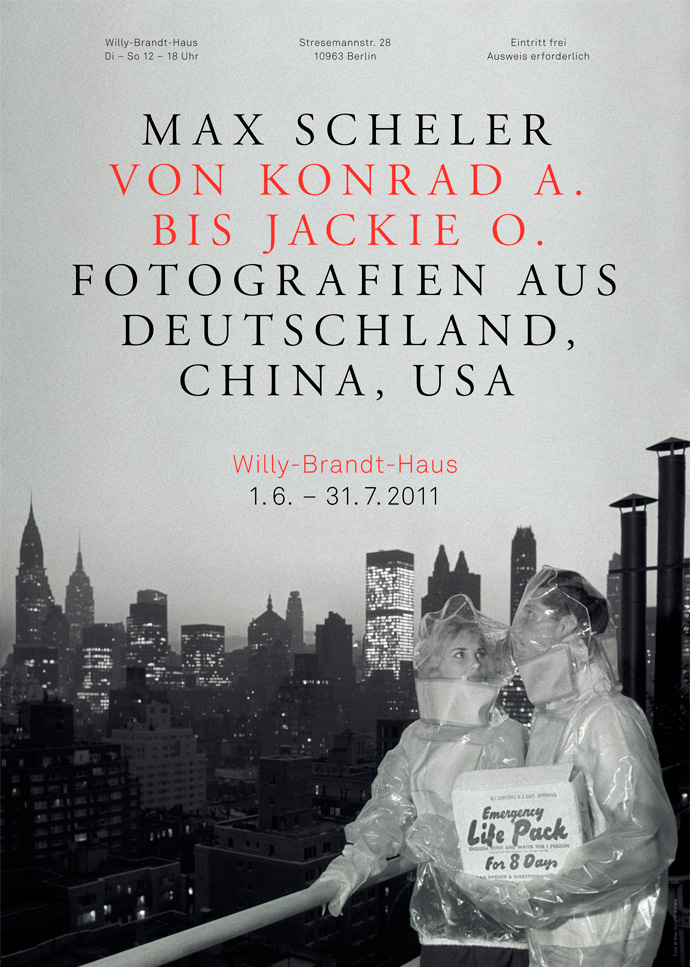
How did the relationship of the two evolve after the first meeting during war in Munich: personally and professionally? I am also asking that as I have a special interest in the idea of the “stimulating” mentor.
I guess stimulation needs at least to prerequisites. At first the receiver of the stimulus needs to be in a situation of wanting to open up, receive a certain change in her/his perception and possibly even her/his life. And the stimulus must also be desireable and fit the pattern of interest of the receiver. If the stimulus is too foreign or threatening it might be rejected. I think these things fell in place when Max Scheler met Herbert List.He was very young then- it must have been the shaping experience…
Max and his mother left Cologne in 1941, when Max was 13 or 14 years of age. Around the same time List left Athens, because Germany invaded Greece. He had tried to immigrate to the USA but failed and had to return to Germany. Max was raised without a father, since he died the year Max was born. The sudden presence of a male person of authority in the life of Max and his mother was quite welcome. Not to be misunderstood all three of them were very liberal, unconventional and forward thinking persons. None of them wanted to construct a classical family. It was more the realisation of his mother that this very sophisticated photographer in his forties did spark some certain interest and outlook in the young max’ life, that she possibly could not, because the was too close. She of course realized that he was gay and therefore no husband material. But she might have also understood that the conventional reaction of a mother to not allow her son to have contact to a 25 years-older gay man, would have been rather short-sighted.
So through the turmoil of the war they kept close contact.
The stimulation we talked about earlier, that caused Max Scheler to learn a craft, languages and a certain ‘savoir vivre’ from Herbert List, developed through that time.
And I think that it was manyfold. I am not sure if photography was really the most potent influence here. And I am not sure what was going on between the two of them emotionally. Did they fall in love? That is speculation, but I guess it safe to say that a certain amount of love and trust is necessary to allow oneself to be stimulated.
(more…) -

MAREUNROL’S
-Mārīte Mastiņa and Rolands Pēterkops, the minds behind fashion brand MAREUNROL’S pulled their strings for the installation TENANTS which just closed at the Villa Noailles in Hyères, France. The Latvian duo from Riga had already won the two biggest prizes at the Hyères fashion festival in 2009, made a stunning return fashion show in 2010, but his year’s exhibition proves not only their virtuosity in fabricating elegant and wearable pieces of clothing, but also their ability to create a much broader, often dark and poetic universe.
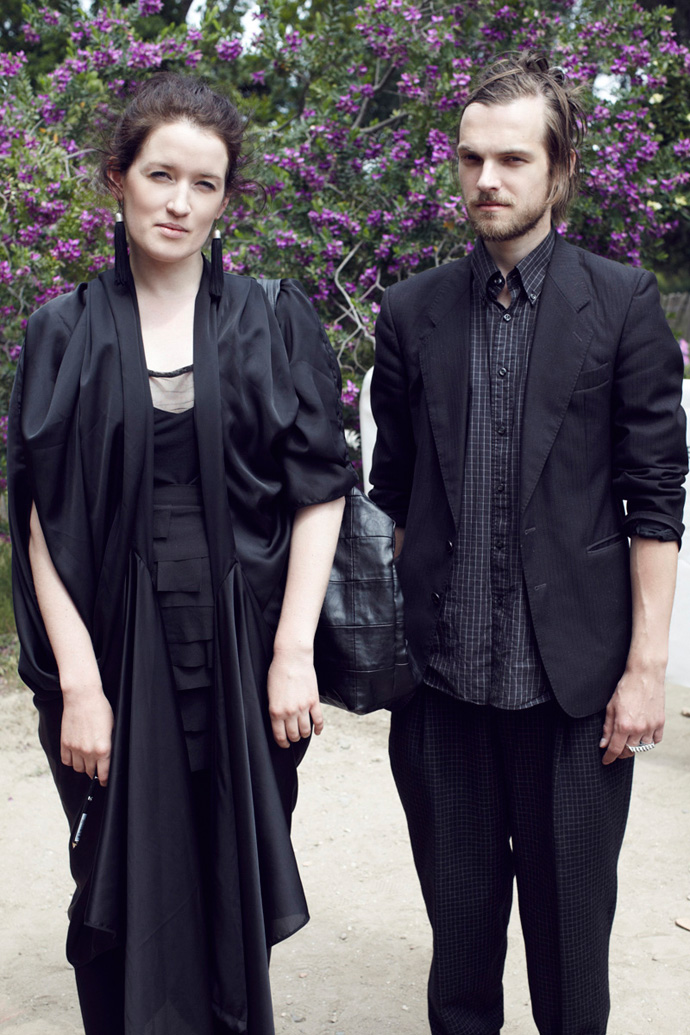 Mareunrol: Mārīte Mastiņa and Rolands Pēterkops at the garden of the villa Noailles.
Mareunrol: Mārīte Mastiņa and Rolands Pēterkops at the garden of the villa Noailles.RENÉ HABERMACHER: what was the point of departure for this installation and the inspiration behind it?
ROLANDS PETERKOPS & MARITE MASTINA: When we start to work on a new collection, we always make the designs first to fit on miniature mannequins. And each time we both have discussed the idea of beautiful dolls as models so we could our ideas of garments to shoot as small style photos and to show them as the newest collection. That is why this idea came naturally.The advantage of the small scale is that we have the freedom of implement anything, all our ideas without leaving out any of those costing an absolute fortune to make. Visual inspiration came in recent years moving from one apartment to another. That’s why our project is called TENANTS. As any of our works, this work also reflects our experience.
The inspiration for the installation came from artists’ constant moving from one apartment to another, from one neighbors to others, from one room to next and due to moving to new environment always makes you get used to new mystical noises, strange objects, loud or too quiet neighbors and other peculiarities connected with the apartment. But of course, with time you get used to all that. However, that all provoked thinking of how space influences those living in it and vice versa, and whether all these things in one way or another influence people and whether one imperceptibly starts to change, and whether this oddity is just in one’s mind, not reality. This is how emerged the idea for the installation with people/ tenants who dwell in their apartments and become as one with it. All their belongings are like a huge enormous shell/ attire which tell all their peculiarities, interests, specific hobbies and many other things.
These stories are made as small installations which show short sketches from character’s daily life. They communicate through costumes, scenography, sound and light. It is important that not only costumes and puppets are made for the installation, but also environment/ scenography, where they can express themselves and show the intended story, by forming a figurative composition which is combined with a surreal fantasy, mystique and a pinch of wit.
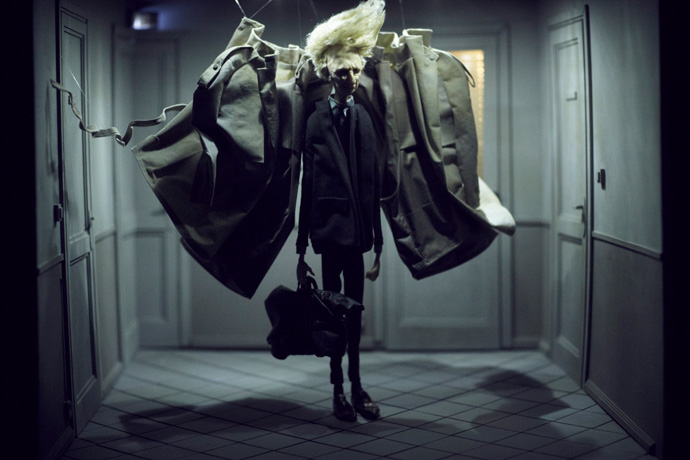 Mārīte Mastiņa and Rolands Pēterkops: Tableau from the exhibition TENANTS.
The dolls character is inspired and modeled after Keith Richards.
Mārīte Mastiņa and Rolands Pēterkops: Tableau from the exhibition TENANTS.
The dolls character is inspired and modeled after Keith Richards.Can you explain me the process of planning and making the installations?
First we had a few visions of the project, then we started working on sketches slowly crystallyzing the characters. At the same time we started looking for people who could make the puppets we had envisaged. It was really important for us to find a puppet master who could make the dolls with movable head and arms. It is really important for our Prague project.
(more…) -

NEXT: MAREUNROL’S
-“The last theater performance which we saw about a Latvian poet Imants Ziedonis directed by Alvis Hermanis. It has left a great impression on us.”
-

SAVE TOKYO CREATION
-This week, under the helm of curator Takafumi Kawasaki, 18 hot Japanese fashion brands and 10 photographers team up in Tokyo for SAVE TOKYO CREATION. As the official Tokyo fashion week was cancelled due to the recent events, stylist Takafumi Kawasaki initiated this show to give young designers an opportunity showing their collections from May 27th to 29th at EYE OF GYRE, Omotesando, Tokyo. Accompanying the show, artworks by Tokyo Posse ENLIGHTMENT will be on display, and a fanzine produced.
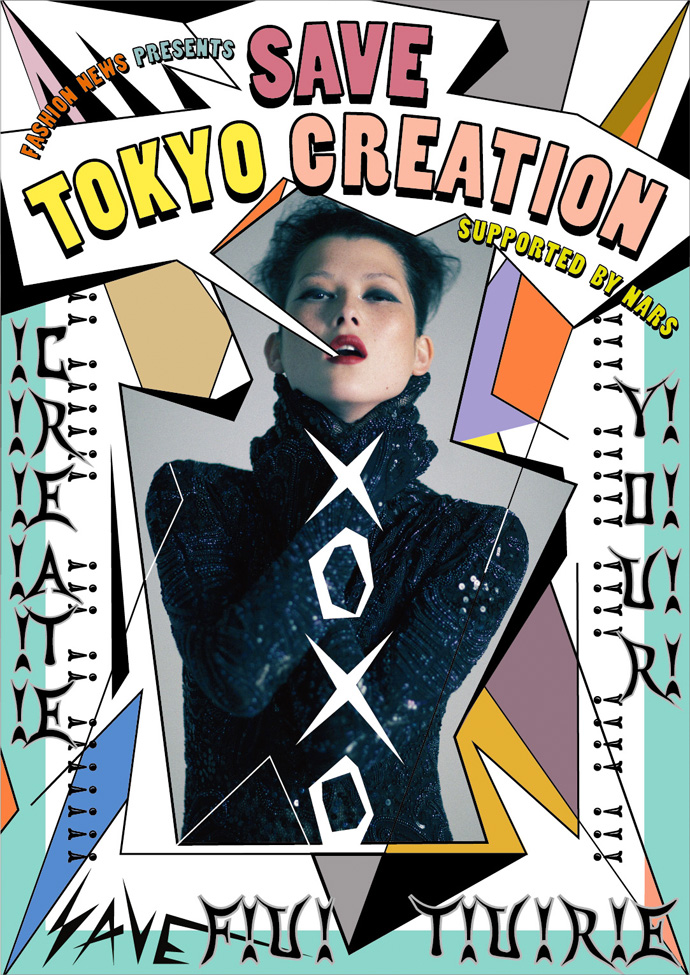
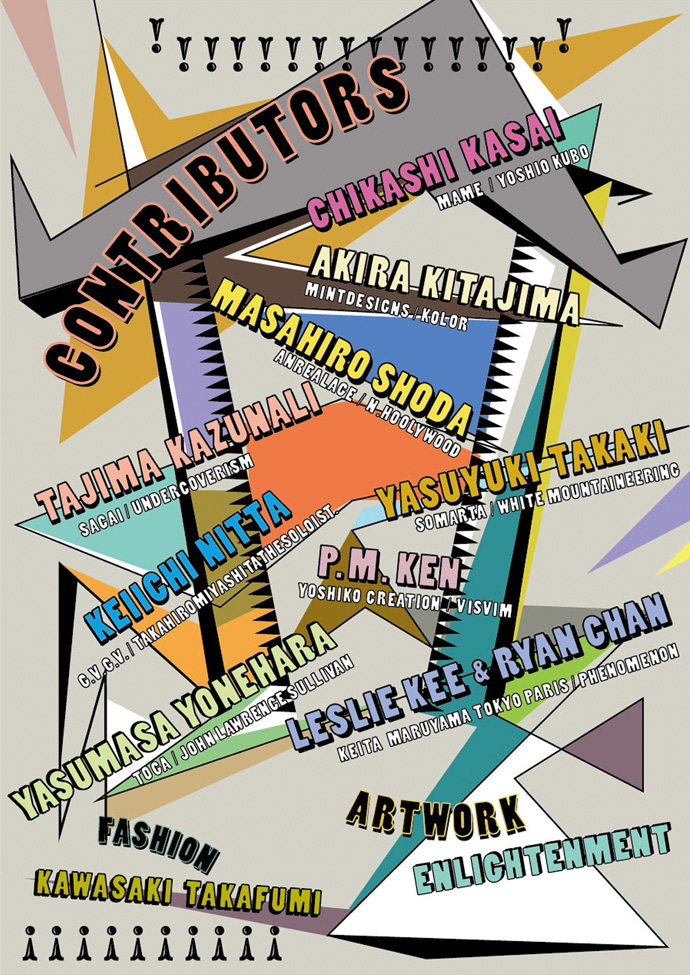 Poster of SAVE TOKYO CREATION by ENLIGHTMENT. Photography by Yasuyuki Takaki
Poster of SAVE TOKYO CREATION by ENLIGHTMENT. Photography by Yasuyuki TakakiThe 18 designers produced special pieces for the project to be auctioned for donation. Among the designers showing, is much beloved Jun Takahashi for UNDERCOVER, YOSHIKO CREATION, famous for her unique pieces to Lady Gaga, TOGA, N.HOOLYWOOD and emerging designer JOHN LAWRENCE SULLIVAN, among others as ANREALAGE, G.V.G.V., KEITA MARUYAMA TOKYO PARIS, MAME, MINTDESIGNS, SACAI, SOMARTA, KOLOR, PHENOMENON, TAKAHIROMIYASHITATHESOLOIST, ISVIM, WHITE MOUNTAINEERING and YOSHIO KUBO.
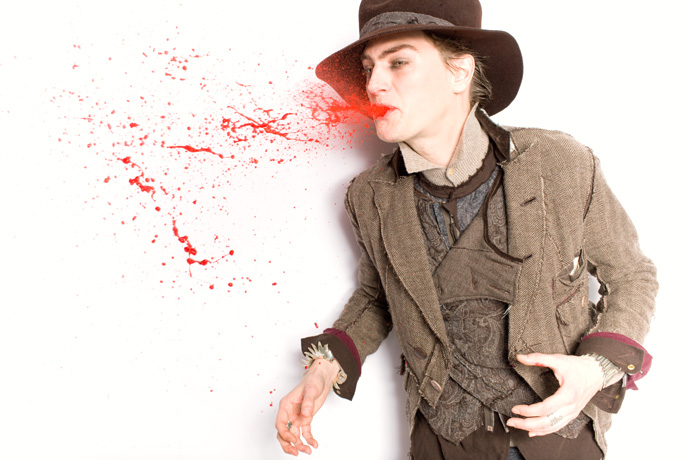 SAVE TOKYO CREATION Photography by Keiichi Nitta
SAVE TOKYO CREATION Photography by Keiichi NittaThe designers AW 2010 designs were picked up by Photographers and lensed especially for that show: Akira Kitajima, Chikashi Kasai, Tajima Kazunali, Keiichi Nitta, Leslie Kee & Ryan Chan, Masahiro Shoda, By P.M. Ken, Yasumasa Yonehara and Yasuyuki Takaki.
The Stimuleye spoke with Takafumi Kawasaki
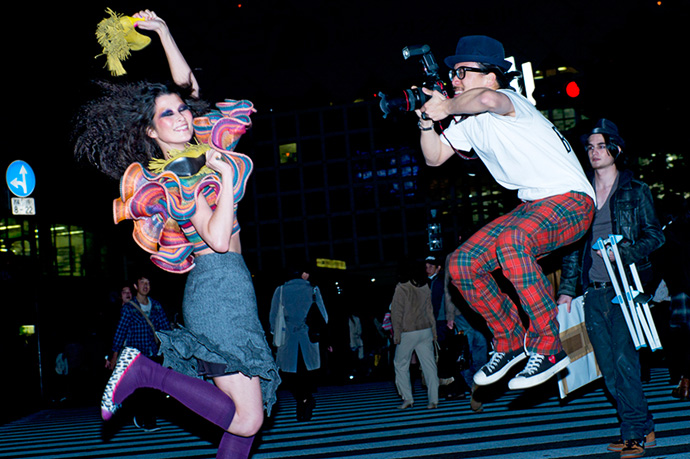 SAVE TOKYO CREATION Photography by Leslie Kee & Ryan Chan
SAVE TOKYO CREATION Photography by Leslie Kee & Ryan ChanRENÉ HABERMACHER: What was your intention with this exhibit?
TAKAFUMI KAWASAKI: SAVE TOKYO CREATION supported by NARS is a big feature of Japanese fashion designers, most of whom lost a chance to exhibit their 2011AW collection because of the earthquake impact.
It’s a charity but not a money-donated oriented.
I wanted to provide Japanese fashion designers a chance to show their 2011AW collection that could not be shown on catwalk because of the earthquake.
As a fashion director & stylist, I believe it is a form of charity that only I can produce to provide those designers with the opportunity to present their creation in public.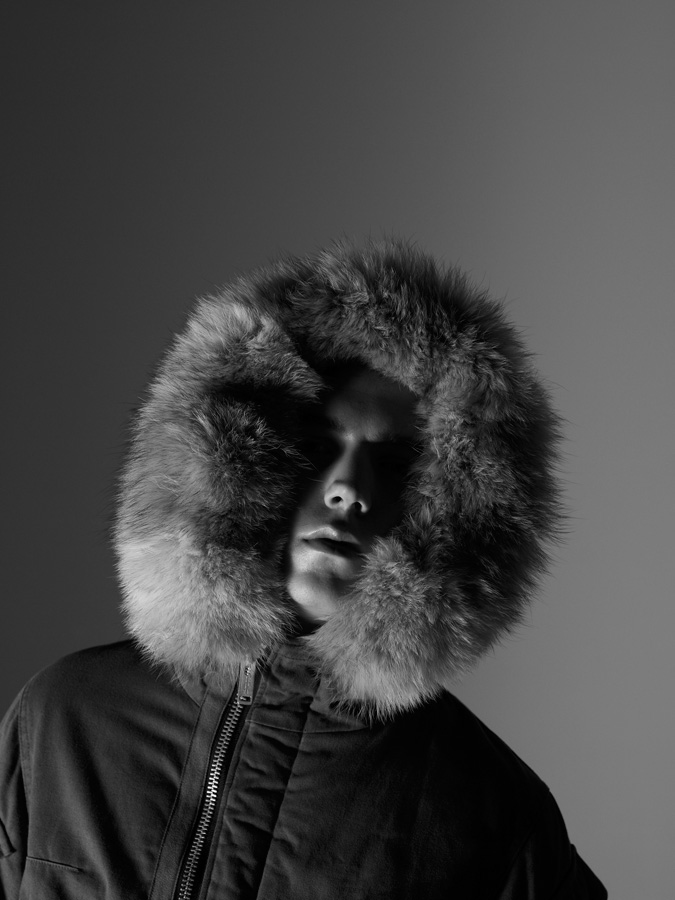
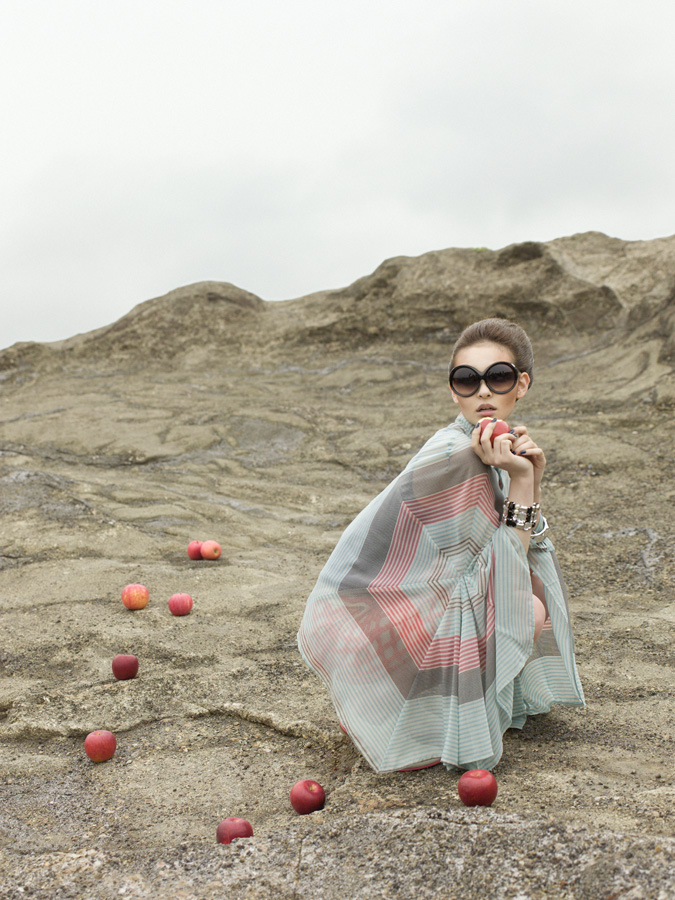 SAVE TOKYO CREATION Left: Photography by Kazunali Tajima. Right: Akira Kitajimat
SAVE TOKYO CREATION Left: Photography by Kazunali Tajima. Right: Akira KitajimatHow did the earthquake and its aftermath affect you personally?
The earthquake made me find the huge scepticism about Japanese government and the power of citizens. I would say I feel my approach to fashion and my styling works became more clearer and straight forward.
It may sound a little funny but I became more optimistic about the life. What already happened, happened, even if it’s a massive tragedy, there is no way to change or dismiss it. I feel there is no point to keep crying over that. But what we should do now, is to step forward.
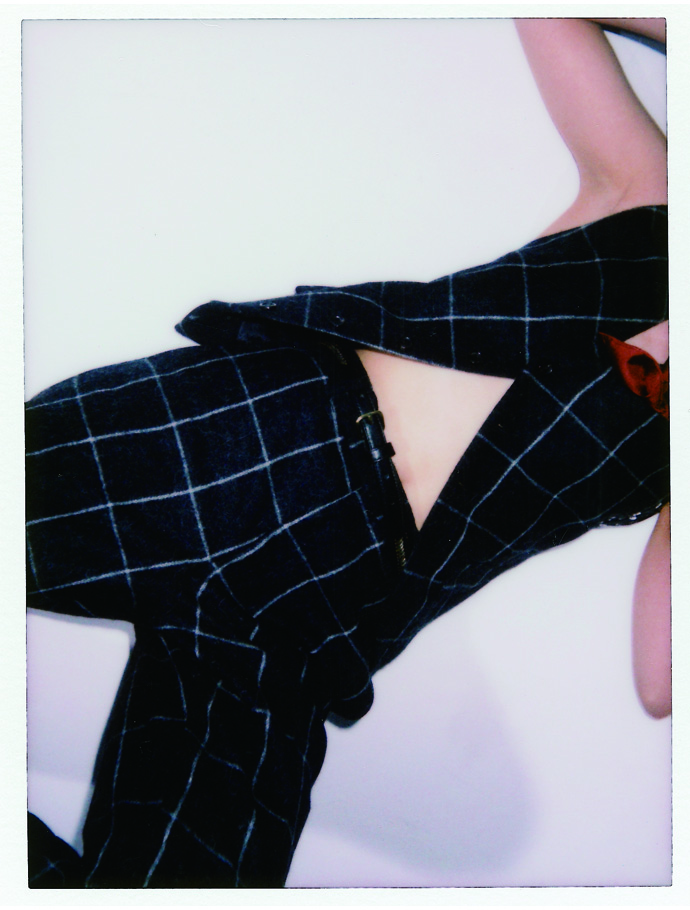
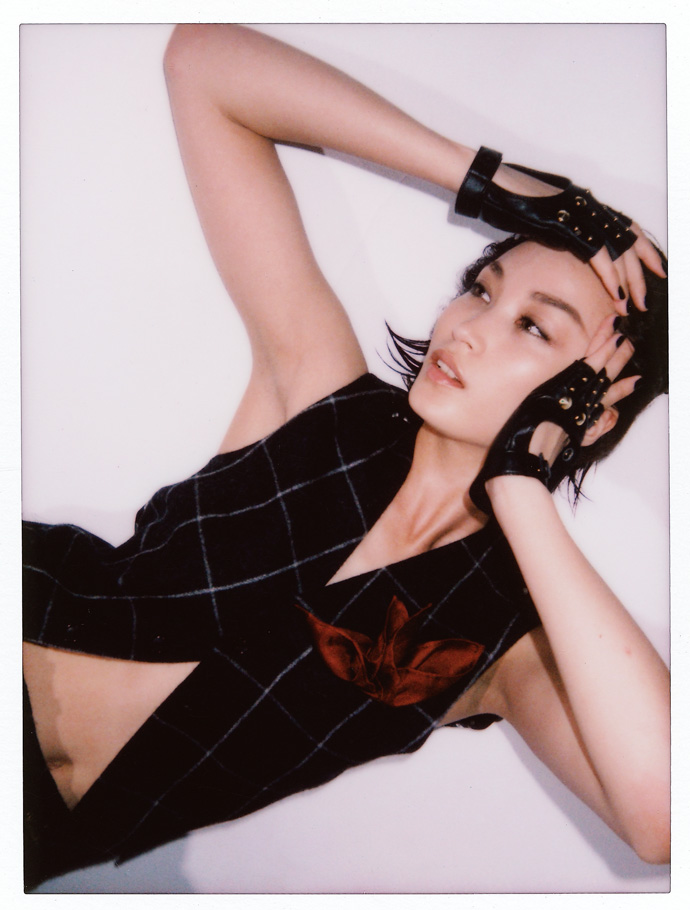 SAVE TOKYO CREATION Photography by Yasumasa Yonehara
SAVE TOKYO CREATION Photography by Yasumasa YoneharaDo you feel there is a different mood now among japanese society? I am asking as Japanese people expressing in the past to feeling alienated to their fellow countrymen…
Yes, “alienation” is a serious issue after the quake. Japanese people appear to be longing for the tightly-bound feeling.
Not only real communication and society, but also they are keen to make bonds with others in virtual community, such as Facebook, Twitter and other numerous social media networks. Some people are obsessed about that too much.Generally speaking, however, I think the Japanese people have found what is important and what is less in life. I believe this is a great chance to reform the typical Japanese convenience-oriented life.They appear to have started making their lives a little slower and calmer, too.
It’s really a big shift of the country.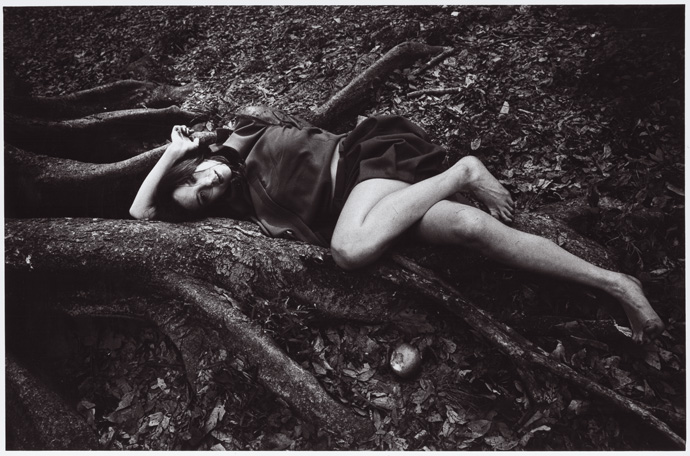 SAVE TOKYO CREATION Photography by Chikashi Kasai
SAVE TOKYO CREATION Photography by Chikashi KasaiWhat is the last thing that stimulated you?
I would say THE EARTHQUAKE in Japan.The exhibition is held from May 27th to 29th at EYE OF GYRE, Omotesando, Tokyo.
 SAVE TOKYO CREATION Photography by Masahiro Shoda
SAVE TOKYO CREATION Photography by Masahiro Shoda -

SANDRA BACKLUND: is knitting herself to the top
-Wherever Sandra Backlund picks her thread it will lead to an incomparable result. That earned her the jury prize in Hyères 2008 and with it international recognition, on which Louis Vuitton had bought in shortly after. The dark Swede impresses with knit works that go far beyond the discipline of fashion and render the use of traditional artisan technique to visionary, body oriented sculptures. Looking at her latest installation CUPRUM 2010, it comes not as a surprise she had studied art history.
The Piece made entirely of finest copper yarn, was commissioned by the Villa Noailles for this years exhibition.The Stimuleye talked with Sandra about here recent work. The conversation was shortly interrupted by yet another request from the international glitteratti circuit: Sandra is truly knitting to the top!
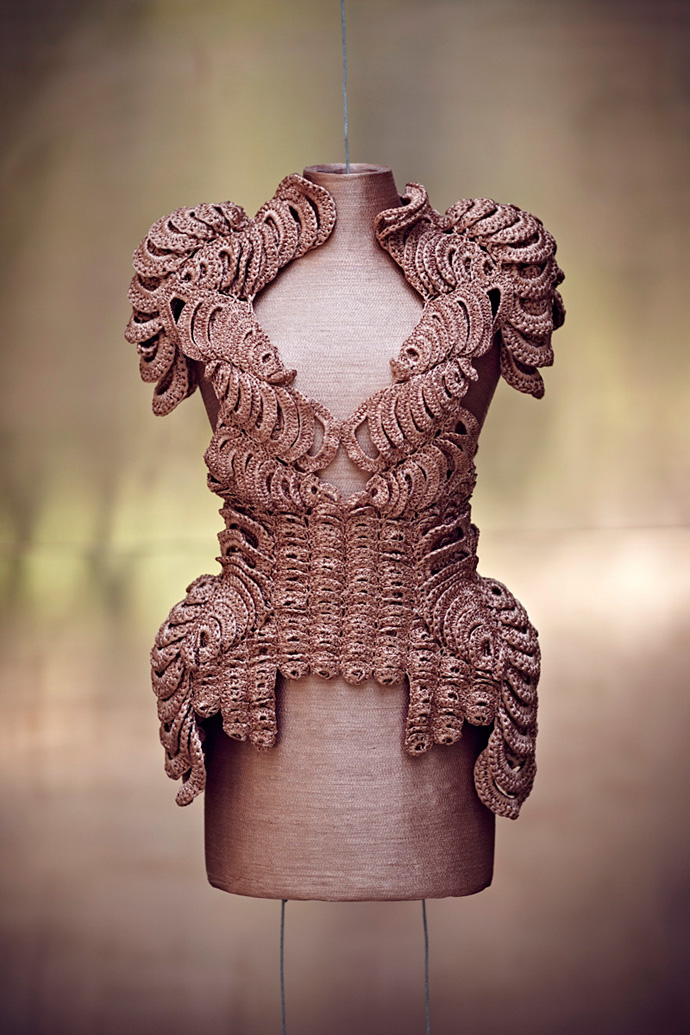 Sandra Backlund's installation CUPRUM 2010 at the Villa Noailles' pigeonnier. Photography by René Habermacher
Sandra Backlund's installation CUPRUM 2010 at the Villa Noailles' pigeonnier. Photography by René HabermacherRENÉ HABERMACHER: What was the point of departure for this installation and the inspiration behind it?
SANDRA BACKLUND: Everything took off from the position they gave me for my exhibition, the Pigeon House in the north garden of Villa Noailles. I think it’s a very beautiful space, so I wanted to use it as a frame, rather then just a location. Because the house is partly open and the exhibition would run for one month outside, I had to carefully consider what material to work with. Already for my current S/S 2011 collection I had been working with a metal yarn made from 100% copper, so in a way it came natural to me to continue exploring that material. With a history of use that is at least 10 000 years old, copper is an important part of both our history and the future. It’s one of the world’s most useful natural resources, 100% recyclable without any loss of quality and it’s estimated that 80% of the copper ever mined, is still in use today. In a way I feel like the story of copper as a material and the way I try to approach fashion go very well together.Can you explain me the process of planning, and the making of the dress?
As always, the handicraft techniques and the human body is the main starting point for me. I never sketch, instead I work with a three dimensional collage method where I develop some basic bricks that I multiply and attach to each other in different ways to discover the silhouette. The only thing I decided already from the beginning was that I wanted some kind of link between the signature piece (the paper origami top) of my winning collection from the 22nd edition of the festival in 2007. Because of the different techniques, materials and colours and because of the process, I guess in the end the link is not so obvious, but there is a few things that is still noticeable, like the silhouette and the size gradings for example.I’ve witnessed you working day and night on this piece – do you have a clue how many hours went into the making?
To be honest, I think that this is the longest piece I have ever worked on. First of all, crochet is always extremely time consuming, especially when it’s layered like this. The copper tape is also very fragile and ones it’s used it, it’s impossible to change, so I had let go of the control and in a way let faith guide me to the end result. If we are talking hours, my estimation is around 500-600 hours.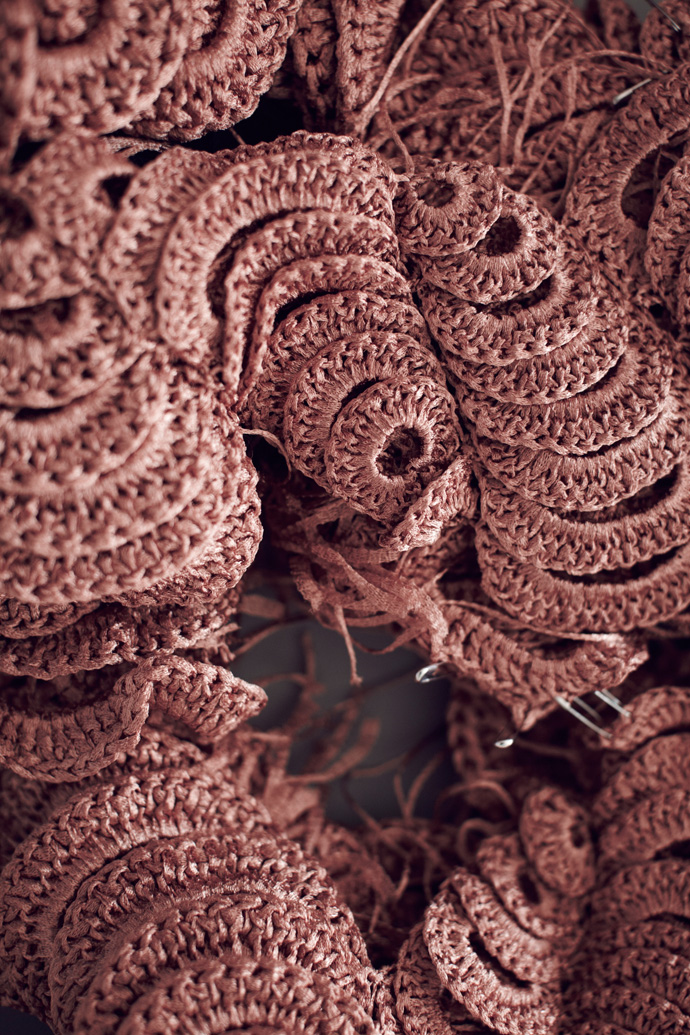
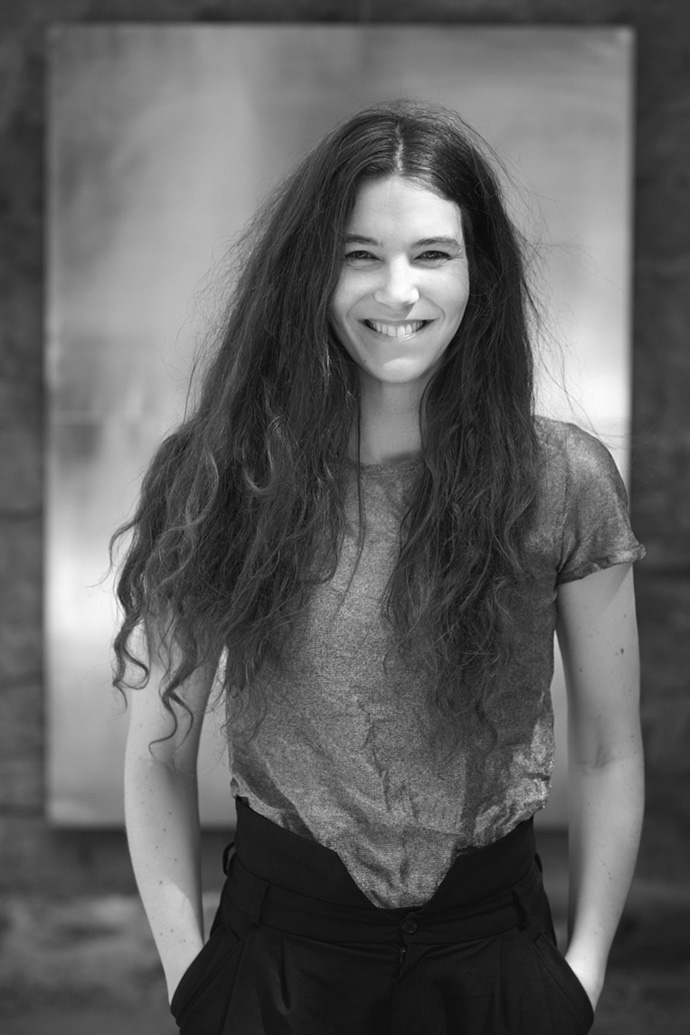 Pieces of copper yarn in the the making, and Sandra at the exhibition space. Photography by René Habermacher
Pieces of copper yarn in the the making, and Sandra at the exhibition space. Photography by René HabermacherYour pieces are often very sculptural, with the artisan work involved, i wonder wether you consider to put your work in a different context than fashion?
Of course I have consider this and many times questioned if fashion is really the right context for my work. As you said, my clothes are always quite sculptural and I also use methods when working that is more close to a sculptor’s, then a tailor’s. But somehow I always come back to the human body. I like to consciously dress and undress different parts of the body and I am very fascinated by all the ways highlight, distort and transform the natural silhouette with clothes and accessories. For me fashion is also one of the most democratic art forms, something that we are all related to. You don’t have to be a designer or a stylist to use clothes as a creative statement, but people in general could of course be more self-governed when t comes to fashion.To me it seems difficult to render your unique approach into industrial production. How are your experiences with that?
About two years ago I was introduced to the long tradition of Italian top knitwear and apparel production. The challenge was to add to my collections something inspired by my hand made pieces that could require only a limited amount of manual work. It was of course a big step for me to go from working alone in my studio, inventing pieces while doing them myself by hand, to suddenly be working in a team of experts within a field of fashion that I never before have had the chance to get to know. I was overwhelmed by all the possibilities I saw and even though I will never give up doing my hand knitted signature pieces, these production tests really made me understand that there is ways to develop my collections that I never thought was possible.What is this festival of Hyères to you? How was it to win – and to be back for this project?
The whole event is really an experience for life when you’re a young designer, all the people you meet and the rush from showing your work in a context like that. I didn’t know about the festival before I met Diane Pernet and she suggested that I should apply. I was crazy happy already when I was selected for the finale and then the wind up… It’s really an important moment in my career so far and to be back again this year and meet everyone was kind of a flash back. When I think about it, I’m still a bit shocked that I was the winner.What’s up next?
F/W 2011-2012 production, S/S 2012 collection and some up coming exhibitions.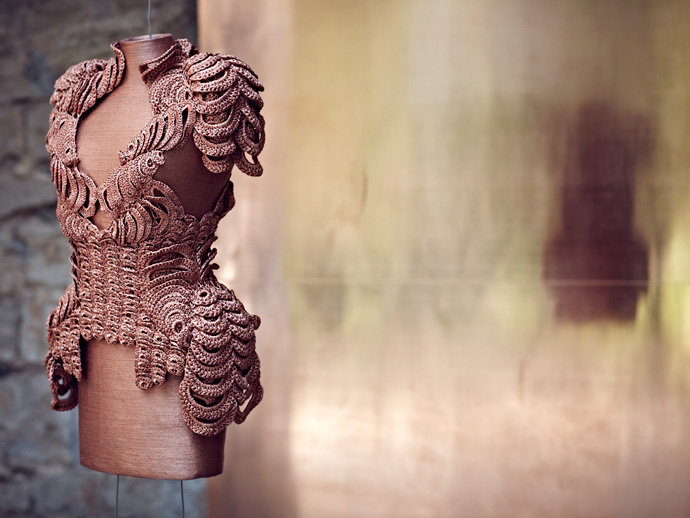
The dress weights over 6kg, made from an archaic material that was the first to be 100% recyclableFurther information on Sandra Backlund: sandrabacklund.com
The Exhibition at the Villa Noailles in Hyeres runs throughout May until the 29th -

-

What will you do for the summer holidays?
-What will you do for the summer holidays? This is a question we here often these days, a perfect conversation piece celebrated from Athens to Paris, London to New York. As a result of this planning many cities will be left deserted at the peak of August. So where do we go?
Travelling, the outlook to discover new and exotic places are something that stimulates us and we look forwards to.
How we could have left that out at The Stimuleye? I don’t know, it’s almost a crime!So we decided to start another series of special places that inspire and enlighten in one or another way. Off track, from a beach bar on a secluded island in Kenya to a spooky ryokan in Japan. And we’ll include food in addition that seems an important part of this experience. Specially considering that Stimuleye Antoine Asseraf had ran a blog around food: FOODGEEK, one of the godparents to The Stimuleye. That might all sound very TAMPOPO – and yes that’s exactly where we’re going with this.
So learn about the addresses for the best Japanese rahmen noodles or Mexican bull-meat tacos, Greek homemade pies, hefty Cuban mojitos or the perfect ring formed bread that’s handed out hung on thread to hold it best, since it’s hot and oven-fresh!
You might stay home during the summer, but nevertheless and hopefully, one of the places we’ll cover in this series starting from tomorrow, will be near you to discover. If you have a tip you believe should be shared and not left out, let us know!
Scene from alltime ultimate Japanese foodgeek movie TAMPOPO. Directed by Jûzô Itami, 1985
-

ATHI-PATRA RUGA: tales of bugchasers, watussi faghags and the afro-womble
-The ascension of young South African artist Athi-Patra Ruga came fast under radar of International attention.
His work, that is often characterized by a dislocated humor, is transcending the divides between fashion, performance and photography and interrogates the body in relation to society, ideology and politics, subverting the western ‘art library’ as he calls it.
The Stimuleye talks to charming Athi-Patra, who was recently featured in the Phaidon book ‘Younger Than Jesus’, a directory of the world’s best artists under the age of 33, about his work and influences.
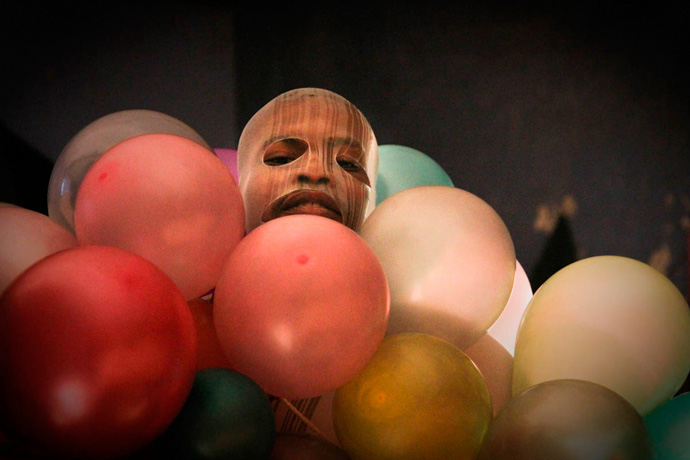 Athi Patra Ruga’s intervention for the X-Homes Hillbrow project with the character of ILUWANE.
Photography by Nadine Hutton
Athi Patra Ruga’s intervention for the X-Homes Hillbrow project with the character of ILUWANE.
Photography by Nadine HuttonRENÉ HABERMACHER: Where are you right now?
ATHI-PATRA RUGA: I’m in my Cape Town studio editing my latest tapestry series and fighting my cats… simultaneously. [laughs] I’m big on cat competitions… my two Russian blues Azange and Shadofax will be taking part so we have been grooming them like crazy… with a few scratches to prove it… hehe.
You’ve just came back from a break – have you got an idea already on what to work on?
At the moment I will be spending the next year creating quietly an extensive body of work revolving around a series of portraits that I will be rendering in tapestry. I have been doing a lot of sittings with various people and doing preliminary sketches. I am editing those now to get started in the next month. I was thinking of titles to name this body or the final exhibition etc: What do you think of :…the do’s and dont’s of bodyworship [laughs]
I am very interested in the power-relations involved in portraiture… especially in response to the ethnographic history involved. I am always concerned with who or what element in the image takes more precedents/importance… the technique or the seater or the artists ego. That argument in my head leads to some lovely renderings.
Your work is known to straddle the divides between fashion, performance and many more disciplines. What is your ultimate goal?
Transcending all boundaries that have been put on who and what one should create.
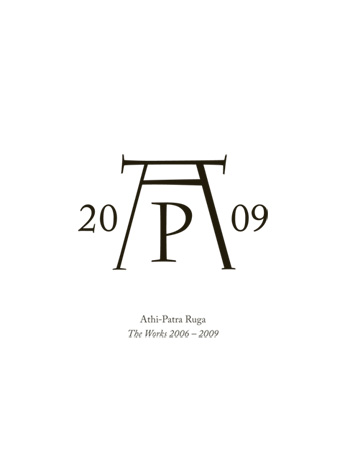
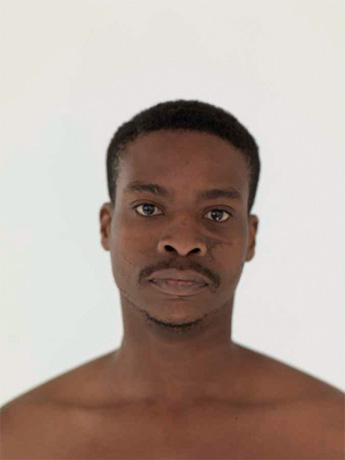 Athi-Patra Ruga's monogram and portrait photographed by Ant Strack
Athi-Patra Ruga's monogram and portrait photographed by Ant StrackThe monogram you use ‘AP’, seems to be derived from Albrecht Dürer?
Nice spotting, yes Dürer is the reference. A big part of the work is appropriation and ultimately subverting the “western art library”. In this case I am always interested in this “I am the one and only”, self-centric way of creating or rather I am totally disturbed by it. The logo is for Athi-Patra Ruga and studios cc. The name of my company and studio. The “and studio” part alludes to the idea that collaboration forms a big part of my practice. I would like to continue with this point.
Does Athi-Patra mean anything specific?
No, it’s a brand like others. And a brand is the highest promise of good quality and superior concept.
It’s two nicknames of my birth name. I’ve been called those names all my life really. It’s as old as I can remember.
So where does the “evil little boy”, as you called yourself come from?
Well I don’t know… I embrace my evils and vices I suppose. As to where it comes from, let’s just say there are a lot of boys and girls think so… at some points I tend to believe it. [laughs]
I was born in a Bantustan, which is a puppet state created by the apartheid government, a dictatorship. In March 1984, on my 13th birthday, Biggie Smalls died. My mom was a midwife, my dad a sports journalist. My parents were gone for long stretches of time and I had to defend myself. It seemed natural, it was one big ball of trauma. I grew up in the townships and during the strikes and boycotts. Many kids [or rather young adults] used to brutalise us for going to suburban/private schools. I spent most of my time indoors as many kids could not cope with me: I was violent in a violent time. Both at home and outside, the country was going through a revolution.
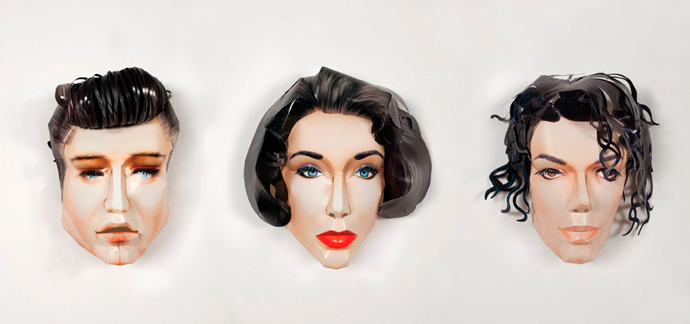 Athi-Patra Ruga: "Idol Death Mask Series" 2009, Modeled Paper, Approx. 27cm x 23cm each
Image courtesy of the artist and whatiftheworld gallery
Athi-Patra Ruga: "Idol Death Mask Series" 2009, Modeled Paper, Approx. 27cm x 23cm each
Image courtesy of the artist and whatiftheworld gallery -

NEXT : ATHI-PATRA RUGA
-Can I name five…1. Joanna Newsom’s new Album
2. My partners blog : “skattie what are you wearing”
3. my decision to cut down on the alcohol.
4. x-box…a godsent.
5. Cycling -

1136 postcards and a smoking nun…
-One family. One postcard for every day apart. The Butlers’ uncommon journey is told by the postcards from a mother to her daughter.
Collaborating with Dutch designer Irma Boom, Jennifer Butler has published an innovative book: JAMES JENNIFER GEORGINA, a taxi yellow, 1200 pages volume in limited editions of 999 copies, parted in three sections with a joint spine, telling a unique story through 1136 postcards and 20 dialogues.
Jennifer travelled the world with her husband James, in an effort to dry him out from his alcoholism, while their daughter Georgina stayed at home with various nannies, but Jennifer sent her daughter 1 postcard per day away – 1136 postcards written from 1989 to 1999.
205 flights taken, 268,162 miles driven, 2 bullfights.
A speeding ticket.
53 unpaid parking tickets.
13 cancelled flights, 1 bomb scare, and 205 churches visited, politics, wars, rising prices, births, funerals, holidays…
Yet what comes forward above all is their relationship.
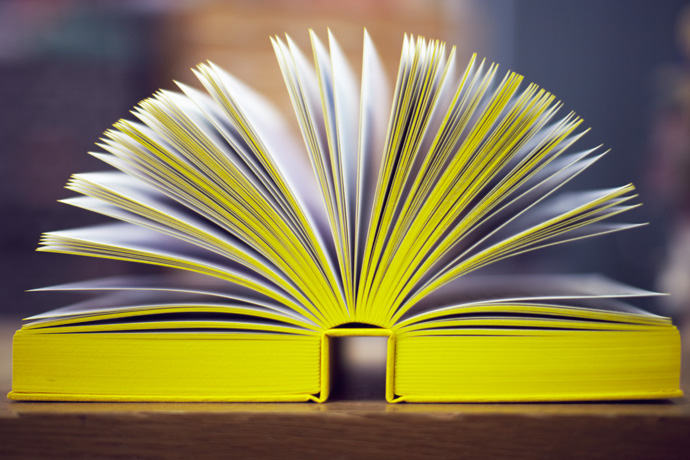 JAMES, JENNIFER, GEORGINA by Jennifer Butler. The 3 spine design allows to lay the book flat
JAMES, JENNIFER, GEORGINA by Jennifer Butler. The 3 spine design allows to lay the book flatWe meet at the American Library in Paris, 23 years after the odyssey started.
As they arrive, Jennifer, a former model, on her side her very British gentleman James, holds a copy of the book in her hands, spiked with post-its of matching yellow. She is in full swing, mentioning another book by Allen Fletcher: “Be aware of wet paint,” he wrote in his beautiful handwriting: ‘I don’t know where I am going, but I am on my way’ and it really sums me up: I don’t know ever where I am going, but I have a sense that I am gonna get there!”.
It was in fact Allen Fletcher’s work, and particularly “The Art of Looking Sideways” that made her look differently at the value of the hundreds of postcards she had kept in boxes after 10 years on the road. When in 1999 the drinking of James stopped, so did the postcards. In 2007, Allen Fletcher was only a few months more to live, so he recommended to Jennifer to work on her project with Dutch designer Irma Boom.
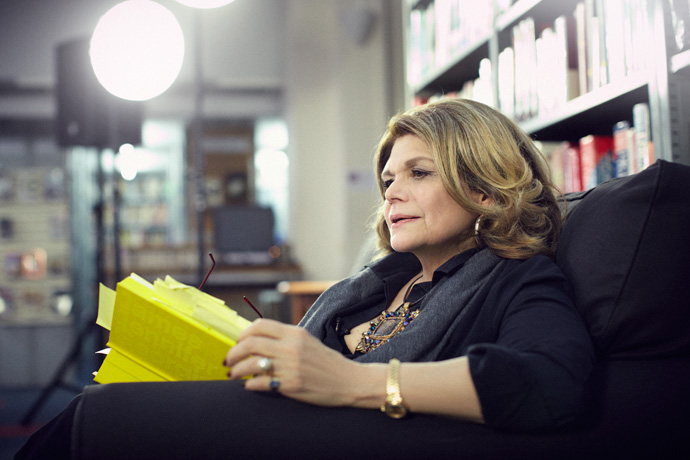 Jennifer Butler at the American Library Paris
Jennifer Butler at the American Library ParisBehind the book, says Butler, lies a passion “for extending the boundaries of what a book can be. And the knowledge that books have to be more, different than ‘information.’ More than being able to download them from the internet” she says. According to her, ‘the book’ is not in the ‘up’ – it’s in the ‘down’:
“The book remains to spread something else: maybe sheer beauty or a much slower, more thought-provoking message” Jennifer expresses in her first correspondence with Irma Boom, sharing the designer’s standpoint on book-making today.
Despite the highly sophisticated and calculated design, JAMES JENNIFER GEORGINA is an emotional matter: “The book is an extension of the content. Irma would not have designed that way for a book about tennis players, or about architecture, whatever. This book is married to the silk screen yellow that she chose, and the yellow canvas. The book is yellow because its full of light and success! […]”
“My husband, Georgina’s father, was drinking himself to death. And with one failed marriage behind me I fought to stave off a second.” James was given only two more years to live, so “to save us I took the difficult decision to leave Georgina at home. We travelled to dry James out and we travelled to shield her from the indignities of drink. Everyday we were apart I wrote to Georgina. If love waits upon a gesture, then my gesture was these postcards. I wanted her to know just who I was and just what I did. They’re a testament to a mother’s love and a sharing of advice, anecdotes, front page news and exotic places” she explains.
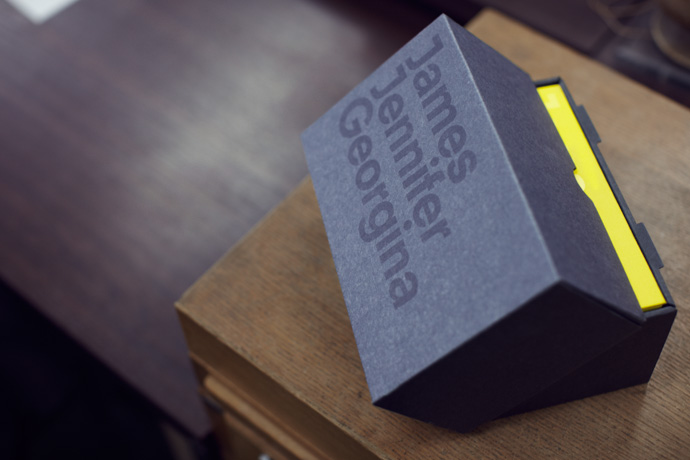 Cassette with the Book of 1200 pages, sewn in yellow cloth
Cassette with the Book of 1200 pages, sewn in yellow cloth“The post cards were never written for public consumption. They were written because I loved doing them.
And I did miss Georgina. And I did feel guilty and it was a way, felt like mothering from a distance.”
For Jennifer, it is actually a very traditional story: “there is a situation, a lot of descriptions with the postcards of a story, there is drama and there are 3 characters. They’re just divided in a very innovative way, because the description and the situation is part 1, the drama is part 2, and the characters are in an album in part 3. Usually when you read about a family or a story or a novel it’s all in one. […] ” She continues, “when people hear the word alcoholism – you know its like a dirty word or somebody survived it. The alcoholism really gave the book its Alfred Hitchcock time element.”
Jennifer admits that there was certainly a bit of irresponsibility concerning the traveling, looking back on it:
“The structure was: let’s go. Like Thelma and Louise. And I was so excited having James sober and clean shaven! He was adorable and generous and he is so knowledgeable about Europe, its history and its wars. It was like being back in university when we were driving! And there was no drink. Because he was so excited being on the road. So it really was not just about keeping him sober. He was sober and I loved the way he was.”
 Postcard from Granada, February 10, 1996
Postcard from Granada, February 10, 1996The book is framing this story of longing guilt and salvation for a wider audience in a fresh way. Despite the 210 postcards that are printed full bore in the volume, accompanied by 400 in miniature, most remarkably, the book also features a series of conversations between James, Georgina and Jennifer: “One guideline that Georgina said, and James backed her 100% up was: there would be no editing! […] “
Irma Boom, according to Jennifer, had approached the book with an enormous integrity and much love for its protagonists had insisted “that we pose the question to Georgina in one of the conversations: what was the sacrifice made by not being there. I said: ‘oh, isn’t this fantastic, Georgina spends every night looking at them.’ My mother said: ‘this is disgusting! my granddaughter is alone a third of her life!’ – of course the people who love you tell you the biggest truths.”
“It was never ever difficult [to talk about our issues as a family]. We’re all very strong characters and I think the love is so loyal that nobody worried about sacrificing love. It was never difficult to talk about the painful subjects: most of all it’s a love story.”
< (more…)
-

HYERES ARE THE DESIGNERS
-Below our office window in the mythical Villa Noailles, people sprawl in the gardens, visit exhibits and discover new designers and photographers. Creative stimulation everywhere. The yearly invasion of Hyères, a sleepy town in the Côte d’Azur, is at its peak, with this micro-festival gaining even more attention by the international press.
On the secluded terrasse in front of us, Raf Simons, the President of this year’s jury, sits in the shade of an umbrella having conversations with numerous journalists, while simultaneously the crowds gather and mingle: headhunters, designers, buyers…
Christopher Kane is here, teamed up with Carla Sozzani of Vogue Italia, Jack and Lazaro of Proenza Schouler came in from NY to have a look at the 10 designers’ work.Its Hyères-storic.
All Photographs by René Habermacher
ODA PAUSMA
Netherlands“It’s very much about contrast: My work is always focused around the vulnerability of women. I play with it, I try to hide it or extend, to show it or protect it. This collection is really about my most vulnerable moment because I ended love after nine years of relationship. I thought I should speak about this in my own language which is fashion. In the beginning it was all black. But later on in the process I was getting better and was seeing the good things about my situation:
Life goes on and there is so much in the world, so I said to myself don’t worry so much! The world is sad enough, so bring some light!
So I brought that into the collection by using white and Swarovski elements and my favorite materials silks and leathers, to work the contrast between fluidity and the protective. The silhouette is very tall from the waist on, so it looks a little surreal and dramatic.”
“The last thing that stimulated me was just my surroundings I guess. I am having a lot of fun lately and I am really enjoying this festival: it gives me energy and I want to move on and work and do something with this feeling of being selected and being a little proud to be so. It’s a good feeling, so why not do something with it.”
JULIETTE ALLEAUME & MARIE VIAL
France“We always help each other on our own collections, but this is our first official collaboration.
We met in high school while studying for our baccalaureate in applied arts. After that we pursued fashion design in different schools–I was at Duperre and Juliette was at Chardon Savard. We lived one year apart and then moved in together in order work together. In fact, the collection that we are presenting in Hyères, is a collection that we made during the time that we shared an apartment.
As for the collection…our starting point was a scarecrow. Using the image of the scarecrow we started to explore the feminine silhouette. Eventually we turned this silhouette upside-down and reworked all of the different facets of it. We were also inspired by cubism so, in the collection, there is the idea of a double body–like one body superimposed on another. For example the shoulders have large proportions and are backwards, the skirts are divided in two and are skewed –so all of the body parts are somehow decontextualized. And we see the real body underneath or in the back, usually highlighted with bright colors. All of this creates disproportional, unhinged silhouettes. Plus, the wooden shoes for the collection create a strange walk”.
“The last thing that stimulated us — Well…the festival! And getting the chance to show our first collaboration. Since we were at different schools, we never had the chance to realize a project together and it is the energy of our duo that motivated us”.
www.artifactcollection.tumblr.com
MADS DINESEN
Denmark“I try to make a spirit army with no nations and no faces. My collection is a lot about shame and pride and the feeling of guilt.
It’s also about how to use the past in the present and the future and learn from it. This is my graduation collection. At the university in Berlin we do one each semester but this is the biggest one and the first with so many pieces. Though it’s a men’s collection, I showed it on women as well in the past.”
“The last thing that stimulated me was the film HOLY MOUNTAIN. That’s one of my favorite films. But right now I am looking a lot at Easter bunnies because I saw DONNIE DARKO. I use a lot of film and music in my work and literature.
Holy Mountain was part of the inspiration for this collection but mostly the colonial history of my home country Denmark. Because when I moved to Germany I found out I didn’t know anything about it, so the research for the collection started in Iceland. I went for a residency to Reykjavik and collected pieces of each culture that was under Denmark. It’s more like a typology of cultural pieces that I tried to put together.”
LEA PECKRE
France“The collection that I am presenting is the collection that I presented for my graduation at Lacambre last year. It’s called CEMETERIES ARE FIELDS OF FLOWERS. I am using a lot elements from cemeteries that interest me like wood, tombstones, mausoleums, bouquets of flowers, the contrast between wrought iron structures and the landscape. These elements, reworked in the materials used for the collection, provided me with really organic shapes–somewhat like trees that climb stones in the cemetery for example. There is a lot of embroidery in the collection as well.
Here in Hyères the defilés are much more structured then at Lacambre. But actually, my show at Lacambre was one of the more simple, subdued shows, so the Hyères show fits really well for me. I like when it is rather simple.”
“The last thing that stimulated me last: I want to finish my collection for Hyères! I am developing new pieces reworking some of the existing pieces and I think it will add a lot to the collection and that it will be better.”

